Written Project Plan on Hubb Holdings Company Limited PDF
VerifiedAdded on 2021/12/13
|41
|10801
|29
AI Summary
Contribute Materials
Your contribution can guide someone’s learning journey. Share your
documents today.

Running head: WRITTEN PROJECT PLAN
Section 1: Written Project Plan on Implementation of inventory management system in Hubb
Holdings Company Limited
Name of the Student:
Name of the University:
Section 1: Written Project Plan on Implementation of inventory management system in Hubb
Holdings Company Limited
Name of the Student:
Name of the University:
Secure Best Marks with AI Grader
Need help grading? Try our AI Grader for instant feedback on your assignments.
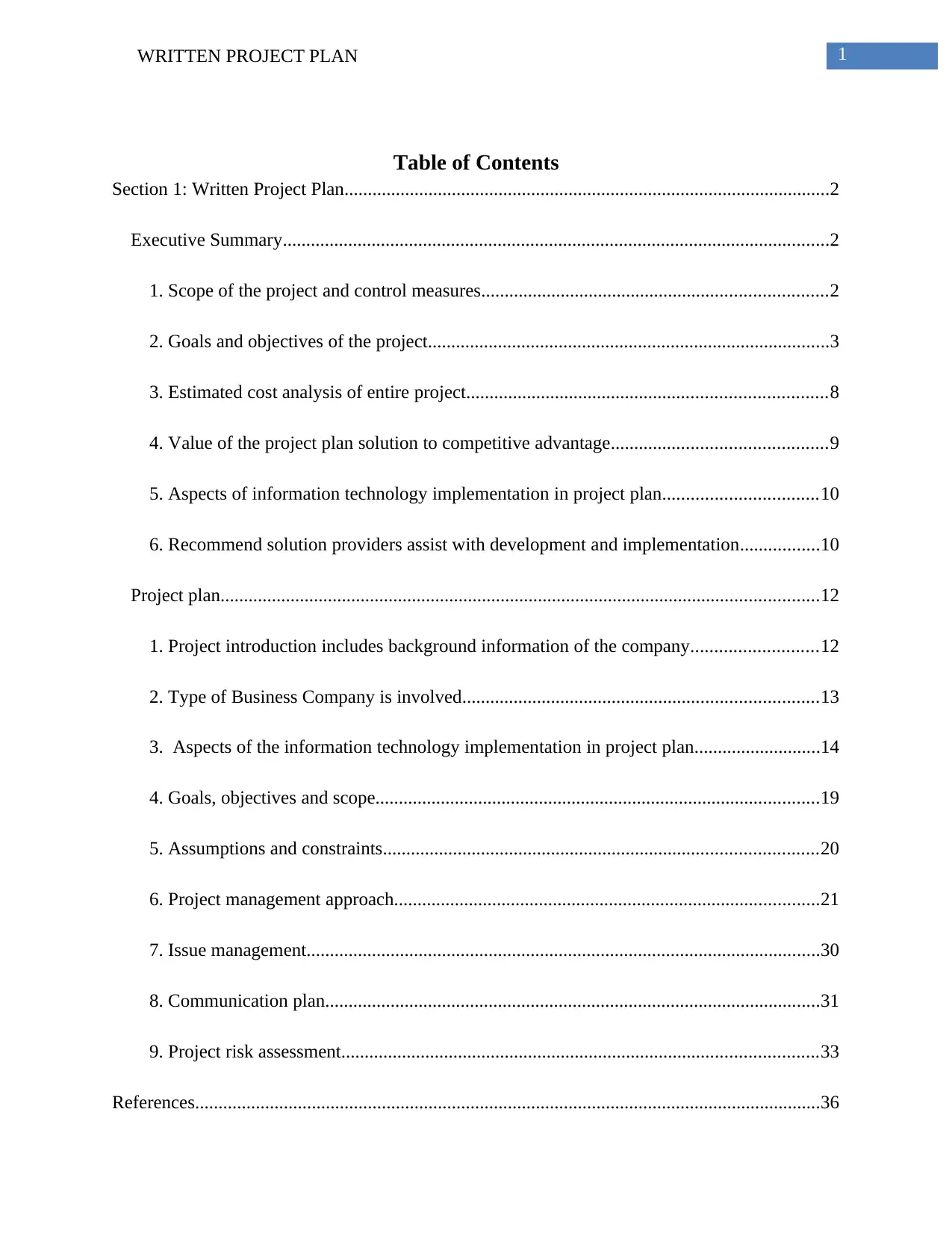
1WRITTEN PROJECT PLAN
Table of Contents
Section 1: Written Project Plan........................................................................................................2
Executive Summary.....................................................................................................................2
1. Scope of the project and control measures..........................................................................2
2. Goals and objectives of the project......................................................................................3
3. Estimated cost analysis of entire project.............................................................................8
4. Value of the project plan solution to competitive advantage..............................................9
5. Aspects of information technology implementation in project plan.................................10
6. Recommend solution providers assist with development and implementation.................10
Project plan................................................................................................................................12
1. Project introduction includes background information of the company...........................12
2. Type of Business Company is involved............................................................................13
3. Aspects of the information technology implementation in project plan...........................14
4. Goals, objectives and scope...............................................................................................19
5. Assumptions and constraints.............................................................................................20
6. Project management approach...........................................................................................21
7. Issue management..............................................................................................................30
8. Communication plan..........................................................................................................31
9. Project risk assessment......................................................................................................33
References......................................................................................................................................36
Table of Contents
Section 1: Written Project Plan........................................................................................................2
Executive Summary.....................................................................................................................2
1. Scope of the project and control measures..........................................................................2
2. Goals and objectives of the project......................................................................................3
3. Estimated cost analysis of entire project.............................................................................8
4. Value of the project plan solution to competitive advantage..............................................9
5. Aspects of information technology implementation in project plan.................................10
6. Recommend solution providers assist with development and implementation.................10
Project plan................................................................................................................................12
1. Project introduction includes background information of the company...........................12
2. Type of Business Company is involved............................................................................13
3. Aspects of the information technology implementation in project plan...........................14
4. Goals, objectives and scope...............................................................................................19
5. Assumptions and constraints.............................................................................................20
6. Project management approach...........................................................................................21
7. Issue management..............................................................................................................30
8. Communication plan..........................................................................................................31
9. Project risk assessment......................................................................................................33
References......................................................................................................................................36
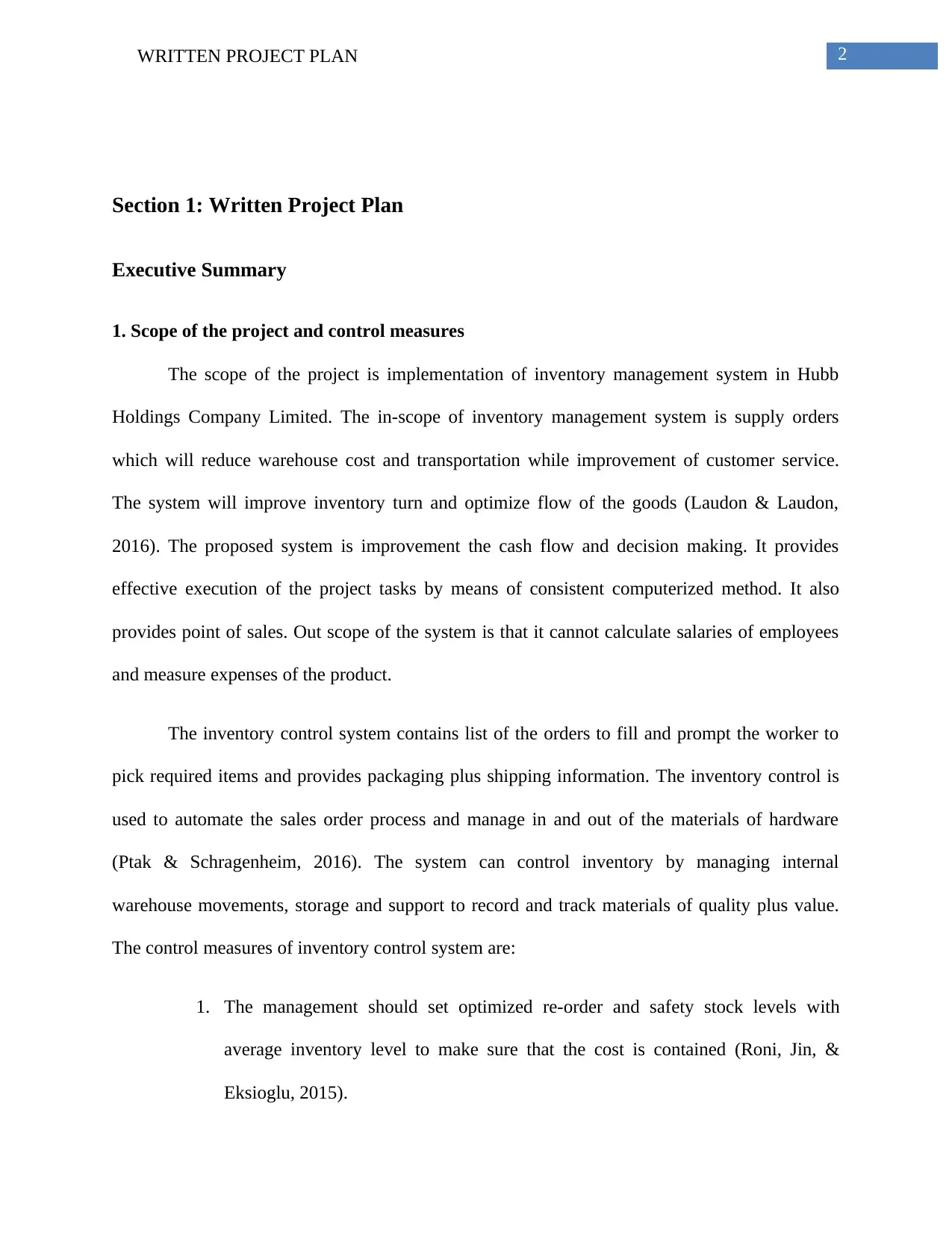
2WRITTEN PROJECT PLAN
Section 1: Written Project Plan
Executive Summary
1. Scope of the project and control measures
The scope of the project is implementation of inventory management system in Hubb
Holdings Company Limited. The in-scope of inventory management system is supply orders
which will reduce warehouse cost and transportation while improvement of customer service.
The system will improve inventory turn and optimize flow of the goods (Laudon & Laudon,
2016). The proposed system is improvement the cash flow and decision making. It provides
effective execution of the project tasks by means of consistent computerized method. It also
provides point of sales. Out scope of the system is that it cannot calculate salaries of employees
and measure expenses of the product.
The inventory control system contains list of the orders to fill and prompt the worker to
pick required items and provides packaging plus shipping information. The inventory control is
used to automate the sales order process and manage in and out of the materials of hardware
(Ptak & Schragenheim, 2016). The system can control inventory by managing internal
warehouse movements, storage and support to record and track materials of quality plus value.
The control measures of inventory control system are:
1. The management should set optimized re-order and safety stock levels with
average inventory level to make sure that the cost is contained (Roni, Jin, &
Eksioglu, 2015).
Section 1: Written Project Plan
Executive Summary
1. Scope of the project and control measures
The scope of the project is implementation of inventory management system in Hubb
Holdings Company Limited. The in-scope of inventory management system is supply orders
which will reduce warehouse cost and transportation while improvement of customer service.
The system will improve inventory turn and optimize flow of the goods (Laudon & Laudon,
2016). The proposed system is improvement the cash flow and decision making. It provides
effective execution of the project tasks by means of consistent computerized method. It also
provides point of sales. Out scope of the system is that it cannot calculate salaries of employees
and measure expenses of the product.
The inventory control system contains list of the orders to fill and prompt the worker to
pick required items and provides packaging plus shipping information. The inventory control is
used to automate the sales order process and manage in and out of the materials of hardware
(Ptak & Schragenheim, 2016). The system can control inventory by managing internal
warehouse movements, storage and support to record and track materials of quality plus value.
The control measures of inventory control system are:
1. The management should set optimized re-order and safety stock levels with
average inventory level to make sure that the cost is contained (Roni, Jin, &
Eksioglu, 2015).
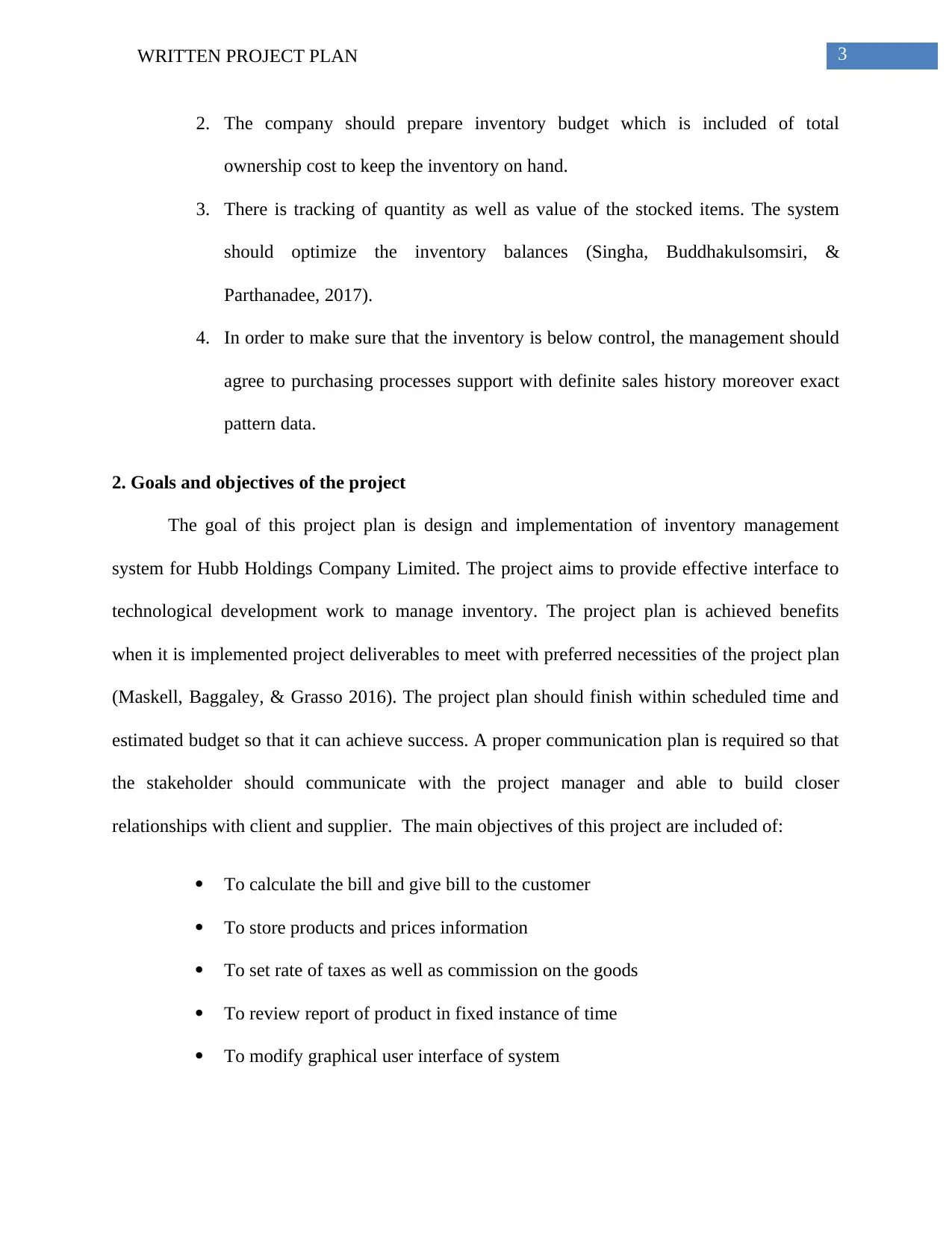
3WRITTEN PROJECT PLAN
2. The company should prepare inventory budget which is included of total
ownership cost to keep the inventory on hand.
3. There is tracking of quantity as well as value of the stocked items. The system
should optimize the inventory balances (Singha, Buddhakulsomsiri, &
Parthanadee, 2017).
4. In order to make sure that the inventory is below control, the management should
agree to purchasing processes support with definite sales history moreover exact
pattern data.
2. Goals and objectives of the project
The goal of this project plan is design and implementation of inventory management
system for Hubb Holdings Company Limited. The project aims to provide effective interface to
technological development work to manage inventory. The project plan is achieved benefits
when it is implemented project deliverables to meet with preferred necessities of the project plan
(Maskell, Baggaley, & Grasso 2016). The project plan should finish within scheduled time and
estimated budget so that it can achieve success. A proper communication plan is required so that
the stakeholder should communicate with the project manager and able to build closer
relationships with client and supplier. The main objectives of this project are included of:
To calculate the bill and give bill to the customer
To store products and prices information
To set rate of taxes as well as commission on the goods
To review report of product in fixed instance of time
To modify graphical user interface of system
2. The company should prepare inventory budget which is included of total
ownership cost to keep the inventory on hand.
3. There is tracking of quantity as well as value of the stocked items. The system
should optimize the inventory balances (Singha, Buddhakulsomsiri, &
Parthanadee, 2017).
4. In order to make sure that the inventory is below control, the management should
agree to purchasing processes support with definite sales history moreover exact
pattern data.
2. Goals and objectives of the project
The goal of this project plan is design and implementation of inventory management
system for Hubb Holdings Company Limited. The project aims to provide effective interface to
technological development work to manage inventory. The project plan is achieved benefits
when it is implemented project deliverables to meet with preferred necessities of the project plan
(Maskell, Baggaley, & Grasso 2016). The project plan should finish within scheduled time and
estimated budget so that it can achieve success. A proper communication plan is required so that
the stakeholder should communicate with the project manager and able to build closer
relationships with client and supplier. The main objectives of this project are included of:
To calculate the bill and give bill to the customer
To store products and prices information
To set rate of taxes as well as commission on the goods
To review report of product in fixed instance of time
To modify graphical user interface of system
Secure Best Marks with AI Grader
Need help grading? Try our AI Grader for instant feedback on your assignments.
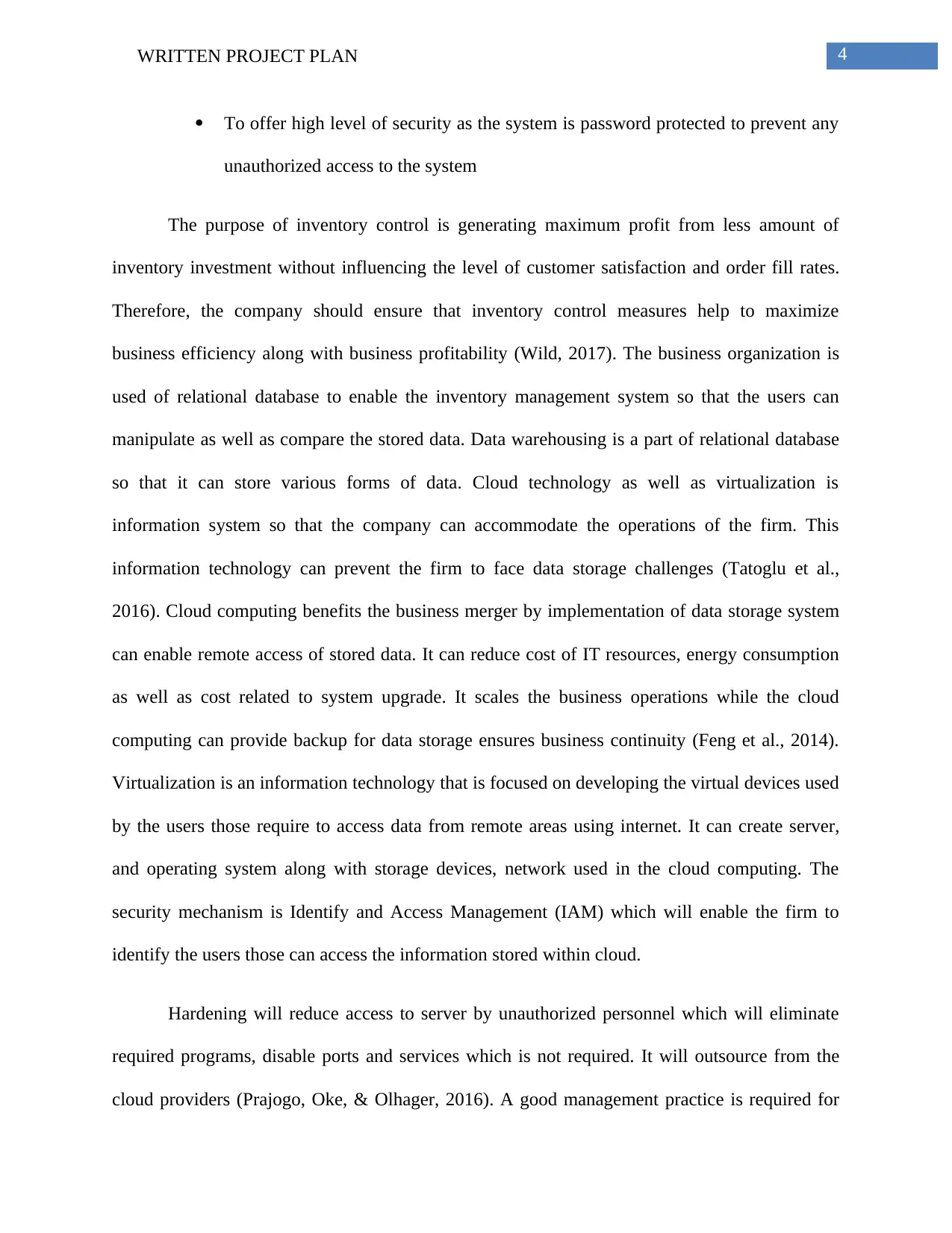
4WRITTEN PROJECT PLAN
To offer high level of security as the system is password protected to prevent any
unauthorized access to the system
The purpose of inventory control is generating maximum profit from less amount of
inventory investment without influencing the level of customer satisfaction and order fill rates.
Therefore, the company should ensure that inventory control measures help to maximize
business efficiency along with business profitability (Wild, 2017). The business organization is
used of relational database to enable the inventory management system so that the users can
manipulate as well as compare the stored data. Data warehousing is a part of relational database
so that it can store various forms of data. Cloud technology as well as virtualization is
information system so that the company can accommodate the operations of the firm. This
information technology can prevent the firm to face data storage challenges (Tatoglu et al.,
2016). Cloud computing benefits the business merger by implementation of data storage system
can enable remote access of stored data. It can reduce cost of IT resources, energy consumption
as well as cost related to system upgrade. It scales the business operations while the cloud
computing can provide backup for data storage ensures business continuity (Feng et al., 2014).
Virtualization is an information technology that is focused on developing the virtual devices used
by the users those require to access data from remote areas using internet. It can create server,
and operating system along with storage devices, network used in the cloud computing. The
security mechanism is Identify and Access Management (IAM) which will enable the firm to
identify the users those can access the information stored within cloud.
Hardening will reduce access to server by unauthorized personnel which will eliminate
required programs, disable ports and services which is not required. It will outsource from the
cloud providers (Prajogo, Oke, & Olhager, 2016). A good management practice is required for
To offer high level of security as the system is password protected to prevent any
unauthorized access to the system
The purpose of inventory control is generating maximum profit from less amount of
inventory investment without influencing the level of customer satisfaction and order fill rates.
Therefore, the company should ensure that inventory control measures help to maximize
business efficiency along with business profitability (Wild, 2017). The business organization is
used of relational database to enable the inventory management system so that the users can
manipulate as well as compare the stored data. Data warehousing is a part of relational database
so that it can store various forms of data. Cloud technology as well as virtualization is
information system so that the company can accommodate the operations of the firm. This
information technology can prevent the firm to face data storage challenges (Tatoglu et al.,
2016). Cloud computing benefits the business merger by implementation of data storage system
can enable remote access of stored data. It can reduce cost of IT resources, energy consumption
as well as cost related to system upgrade. It scales the business operations while the cloud
computing can provide backup for data storage ensures business continuity (Feng et al., 2014).
Virtualization is an information technology that is focused on developing the virtual devices used
by the users those require to access data from remote areas using internet. It can create server,
and operating system along with storage devices, network used in the cloud computing. The
security mechanism is Identify and Access Management (IAM) which will enable the firm to
identify the users those can access the information stored within cloud.
Hardening will reduce access to server by unauthorized personnel which will eliminate
required programs, disable ports and services which is not required. It will outsource from the
cloud providers (Prajogo, Oke, & Olhager, 2016). A good management practice is required for
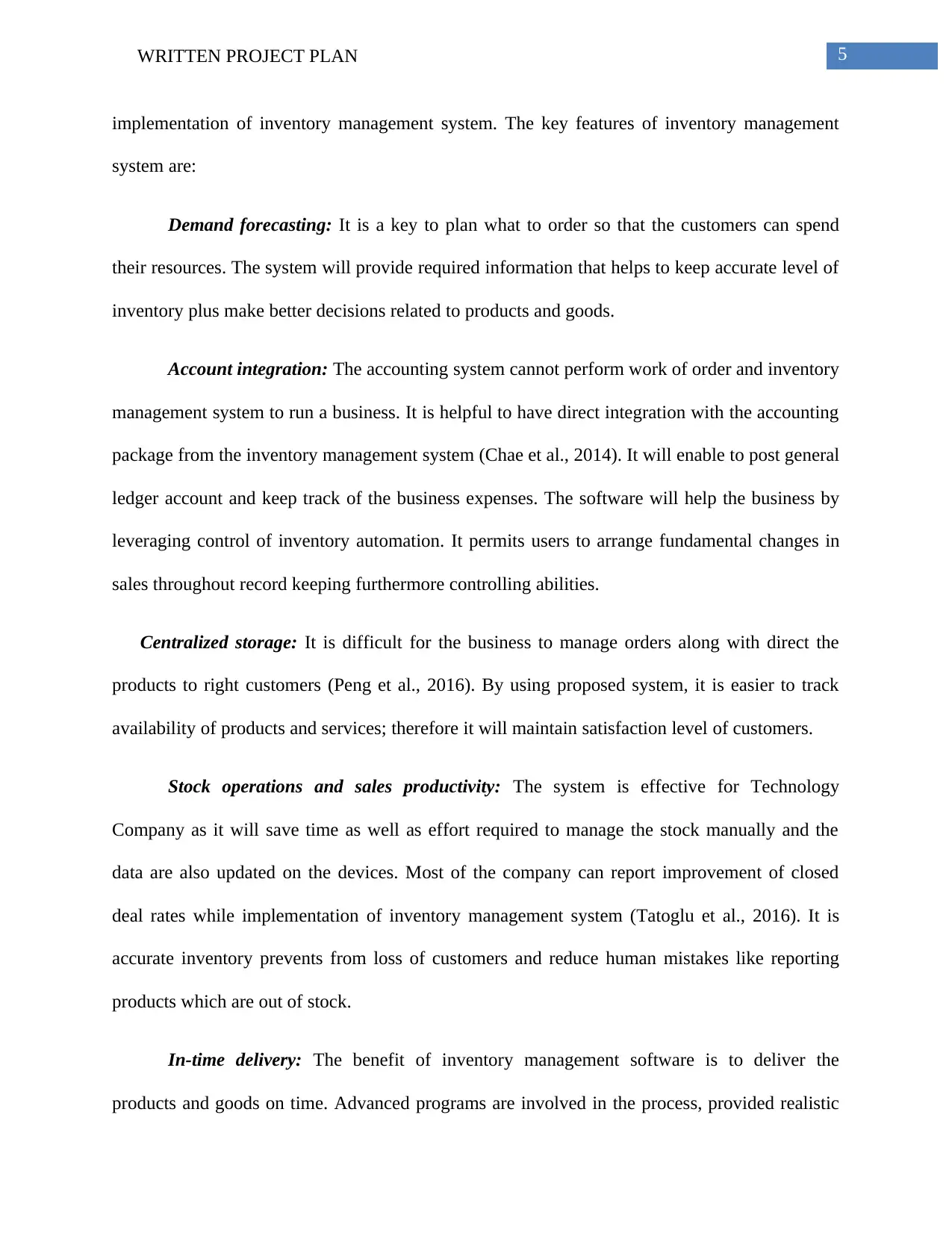
5WRITTEN PROJECT PLAN
implementation of inventory management system. The key features of inventory management
system are:
Demand forecasting: It is a key to plan what to order so that the customers can spend
their resources. The system will provide required information that helps to keep accurate level of
inventory plus make better decisions related to products and goods.
Account integration: The accounting system cannot perform work of order and inventory
management system to run a business. It is helpful to have direct integration with the accounting
package from the inventory management system (Chae et al., 2014). It will enable to post general
ledger account and keep track of the business expenses. The software will help the business by
leveraging control of inventory automation. It permits users to arrange fundamental changes in
sales throughout record keeping furthermore controlling abilities.
Centralized storage: It is difficult for the business to manage orders along with direct the
products to right customers (Peng et al., 2016). By using proposed system, it is easier to track
availability of products and services; therefore it will maintain satisfaction level of customers.
Stock operations and sales productivity: The system is effective for Technology
Company as it will save time as well as effort required to manage the stock manually and the
data are also updated on the devices. Most of the company can report improvement of closed
deal rates while implementation of inventory management system (Tatoglu et al., 2016). It is
accurate inventory prevents from loss of customers and reduce human mistakes like reporting
products which are out of stock.
In-time delivery: The benefit of inventory management software is to deliver the
products and goods on time. Advanced programs are involved in the process, provided realistic
implementation of inventory management system. The key features of inventory management
system are:
Demand forecasting: It is a key to plan what to order so that the customers can spend
their resources. The system will provide required information that helps to keep accurate level of
inventory plus make better decisions related to products and goods.
Account integration: The accounting system cannot perform work of order and inventory
management system to run a business. It is helpful to have direct integration with the accounting
package from the inventory management system (Chae et al., 2014). It will enable to post general
ledger account and keep track of the business expenses. The software will help the business by
leveraging control of inventory automation. It permits users to arrange fundamental changes in
sales throughout record keeping furthermore controlling abilities.
Centralized storage: It is difficult for the business to manage orders along with direct the
products to right customers (Peng et al., 2016). By using proposed system, it is easier to track
availability of products and services; therefore it will maintain satisfaction level of customers.
Stock operations and sales productivity: The system is effective for Technology
Company as it will save time as well as effort required to manage the stock manually and the
data are also updated on the devices. Most of the company can report improvement of closed
deal rates while implementation of inventory management system (Tatoglu et al., 2016). It is
accurate inventory prevents from loss of customers and reduce human mistakes like reporting
products which are out of stock.
In-time delivery: The benefit of inventory management software is to deliver the
products and goods on time. Advanced programs are involved in the process, provided realistic
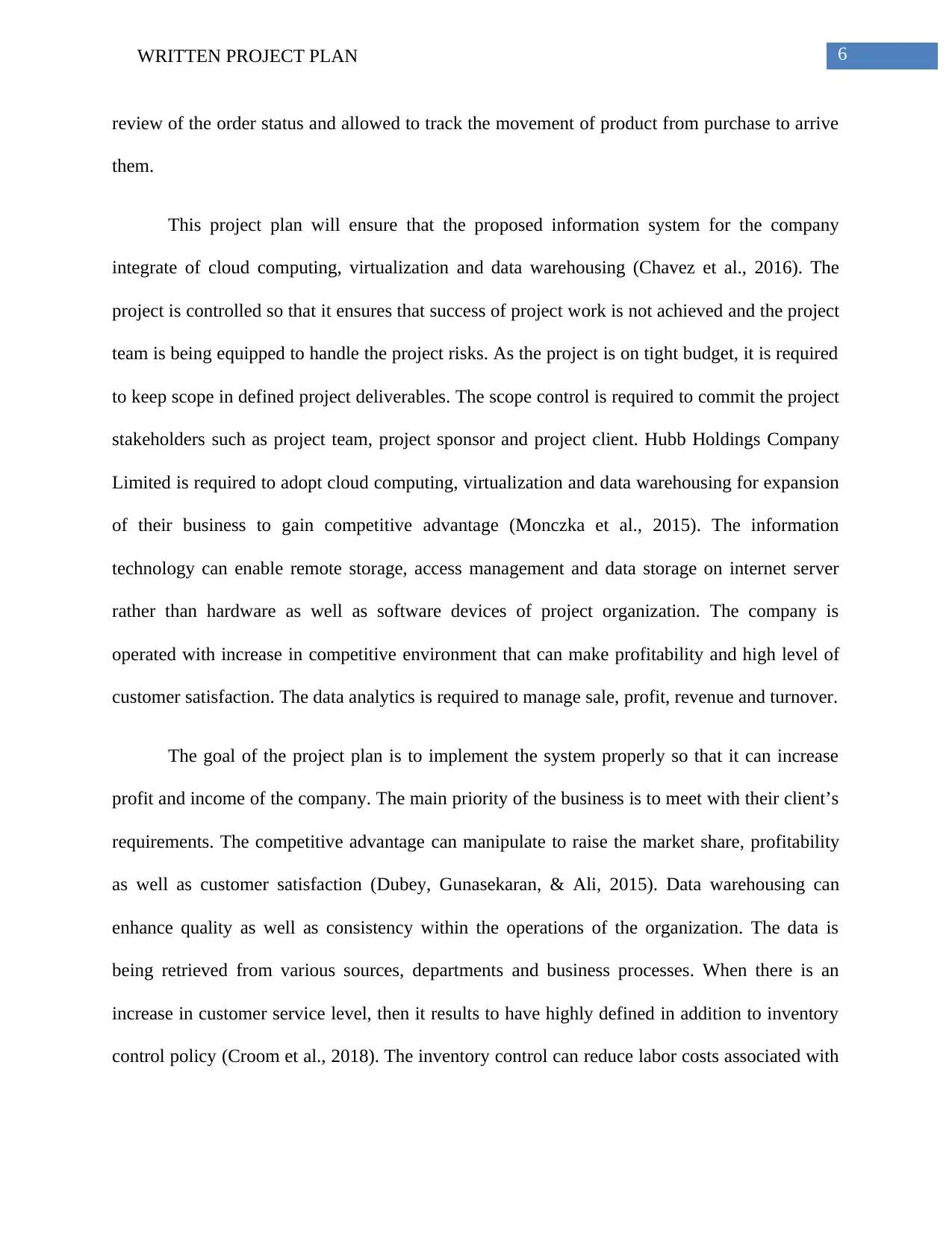
6WRITTEN PROJECT PLAN
review of the order status and allowed to track the movement of product from purchase to arrive
them.
This project plan will ensure that the proposed information system for the company
integrate of cloud computing, virtualization and data warehousing (Chavez et al., 2016). The
project is controlled so that it ensures that success of project work is not achieved and the project
team is being equipped to handle the project risks. As the project is on tight budget, it is required
to keep scope in defined project deliverables. The scope control is required to commit the project
stakeholders such as project team, project sponsor and project client. Hubb Holdings Company
Limited is required to adopt cloud computing, virtualization and data warehousing for expansion
of their business to gain competitive advantage (Monczka et al., 2015). The information
technology can enable remote storage, access management and data storage on internet server
rather than hardware as well as software devices of project organization. The company is
operated with increase in competitive environment that can make profitability and high level of
customer satisfaction. The data analytics is required to manage sale, profit, revenue and turnover.
The goal of the project plan is to implement the system properly so that it can increase
profit and income of the company. The main priority of the business is to meet with their client’s
requirements. The competitive advantage can manipulate to raise the market share, profitability
as well as customer satisfaction (Dubey, Gunasekaran, & Ali, 2015). Data warehousing can
enhance quality as well as consistency within the operations of the organization. The data is
being retrieved from various sources, departments and business processes. When there is an
increase in customer service level, then it results to have highly defined in addition to inventory
control policy (Croom et al., 2018). The inventory control can reduce labor costs associated with
review of the order status and allowed to track the movement of product from purchase to arrive
them.
This project plan will ensure that the proposed information system for the company
integrate of cloud computing, virtualization and data warehousing (Chavez et al., 2016). The
project is controlled so that it ensures that success of project work is not achieved and the project
team is being equipped to handle the project risks. As the project is on tight budget, it is required
to keep scope in defined project deliverables. The scope control is required to commit the project
stakeholders such as project team, project sponsor and project client. Hubb Holdings Company
Limited is required to adopt cloud computing, virtualization and data warehousing for expansion
of their business to gain competitive advantage (Monczka et al., 2015). The information
technology can enable remote storage, access management and data storage on internet server
rather than hardware as well as software devices of project organization. The company is
operated with increase in competitive environment that can make profitability and high level of
customer satisfaction. The data analytics is required to manage sale, profit, revenue and turnover.
The goal of the project plan is to implement the system properly so that it can increase
profit and income of the company. The main priority of the business is to meet with their client’s
requirements. The competitive advantage can manipulate to raise the market share, profitability
as well as customer satisfaction (Dubey, Gunasekaran, & Ali, 2015). Data warehousing can
enhance quality as well as consistency within the operations of the organization. The data is
being retrieved from various sources, departments and business processes. When there is an
increase in customer service level, then it results to have highly defined in addition to inventory
control policy (Croom et al., 2018). The inventory control can reduce labor costs associated with
Paraphrase This Document
Need a fresh take? Get an instant paraphrase of this document with our AI Paraphraser
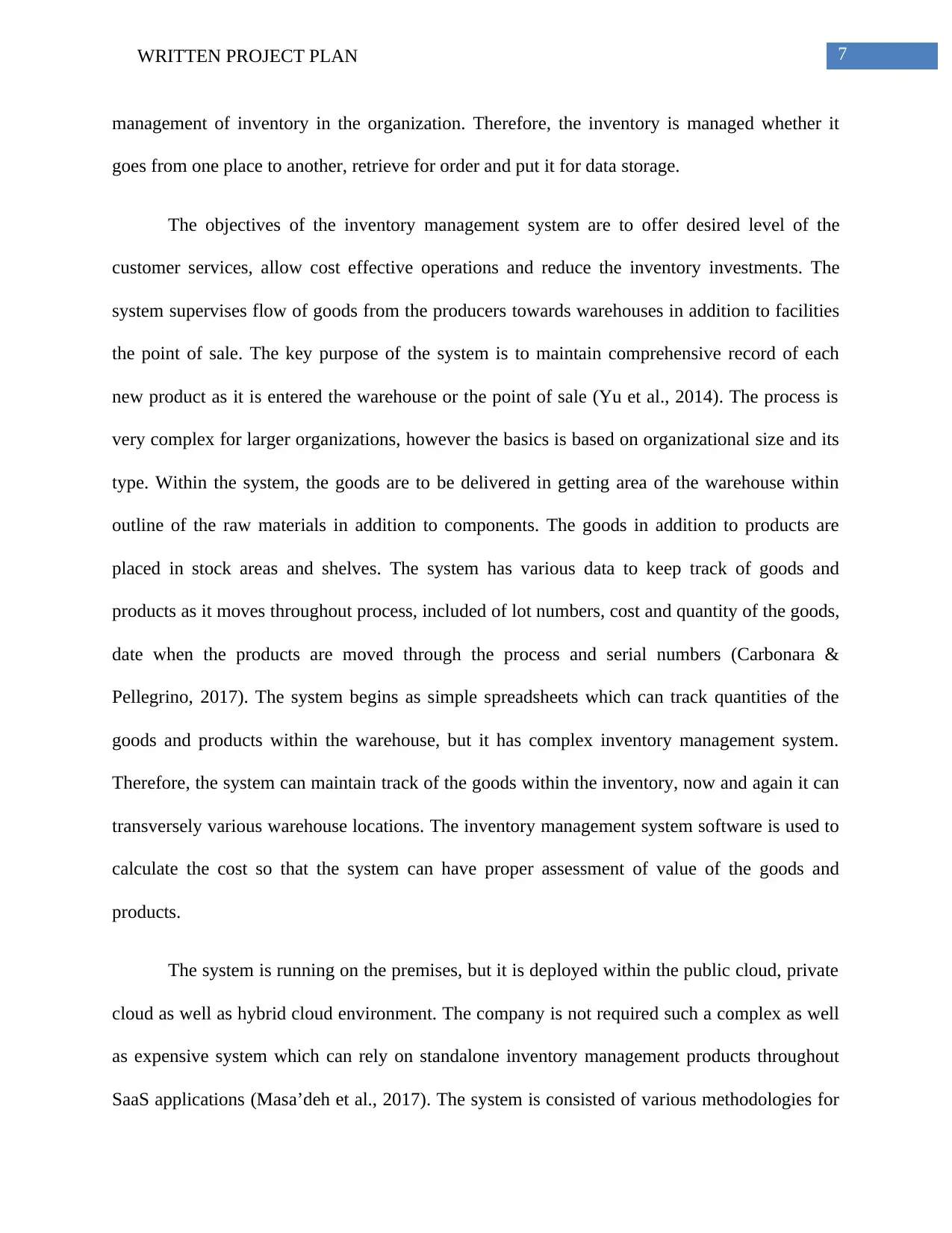
7WRITTEN PROJECT PLAN
management of inventory in the organization. Therefore, the inventory is managed whether it
goes from one place to another, retrieve for order and put it for data storage.
The objectives of the inventory management system are to offer desired level of the
customer services, allow cost effective operations and reduce the inventory investments. The
system supervises flow of goods from the producers towards warehouses in addition to facilities
the point of sale. The key purpose of the system is to maintain comprehensive record of each
new product as it is entered the warehouse or the point of sale (Yu et al., 2014). The process is
very complex for larger organizations, however the basics is based on organizational size and its
type. Within the system, the goods are to be delivered in getting area of the warehouse within
outline of the raw materials in addition to components. The goods in addition to products are
placed in stock areas and shelves. The system has various data to keep track of goods and
products as it moves throughout process, included of lot numbers, cost and quantity of the goods,
date when the products are moved through the process and serial numbers (Carbonara &
Pellegrino, 2017). The system begins as simple spreadsheets which can track quantities of the
goods and products within the warehouse, but it has complex inventory management system.
Therefore, the system can maintain track of the goods within the inventory, now and again it can
transversely various warehouse locations. The inventory management system software is used to
calculate the cost so that the system can have proper assessment of value of the goods and
products.
The system is running on the premises, but it is deployed within the public cloud, private
cloud as well as hybrid cloud environment. The company is not required such a complex as well
as expensive system which can rely on standalone inventory management products throughout
SaaS applications (Masa’deh et al., 2017). The system is consisted of various methodologies for
management of inventory in the organization. Therefore, the inventory is managed whether it
goes from one place to another, retrieve for order and put it for data storage.
The objectives of the inventory management system are to offer desired level of the
customer services, allow cost effective operations and reduce the inventory investments. The
system supervises flow of goods from the producers towards warehouses in addition to facilities
the point of sale. The key purpose of the system is to maintain comprehensive record of each
new product as it is entered the warehouse or the point of sale (Yu et al., 2014). The process is
very complex for larger organizations, however the basics is based on organizational size and its
type. Within the system, the goods are to be delivered in getting area of the warehouse within
outline of the raw materials in addition to components. The goods in addition to products are
placed in stock areas and shelves. The system has various data to keep track of goods and
products as it moves throughout process, included of lot numbers, cost and quantity of the goods,
date when the products are moved through the process and serial numbers (Carbonara &
Pellegrino, 2017). The system begins as simple spreadsheets which can track quantities of the
goods and products within the warehouse, but it has complex inventory management system.
Therefore, the system can maintain track of the goods within the inventory, now and again it can
transversely various warehouse locations. The inventory management system software is used to
calculate the cost so that the system can have proper assessment of value of the goods and
products.
The system is running on the premises, but it is deployed within the public cloud, private
cloud as well as hybrid cloud environment. The company is not required such a complex as well
as expensive system which can rely on standalone inventory management products throughout
SaaS applications (Masa’deh et al., 2017). The system is consisted of various methodologies for
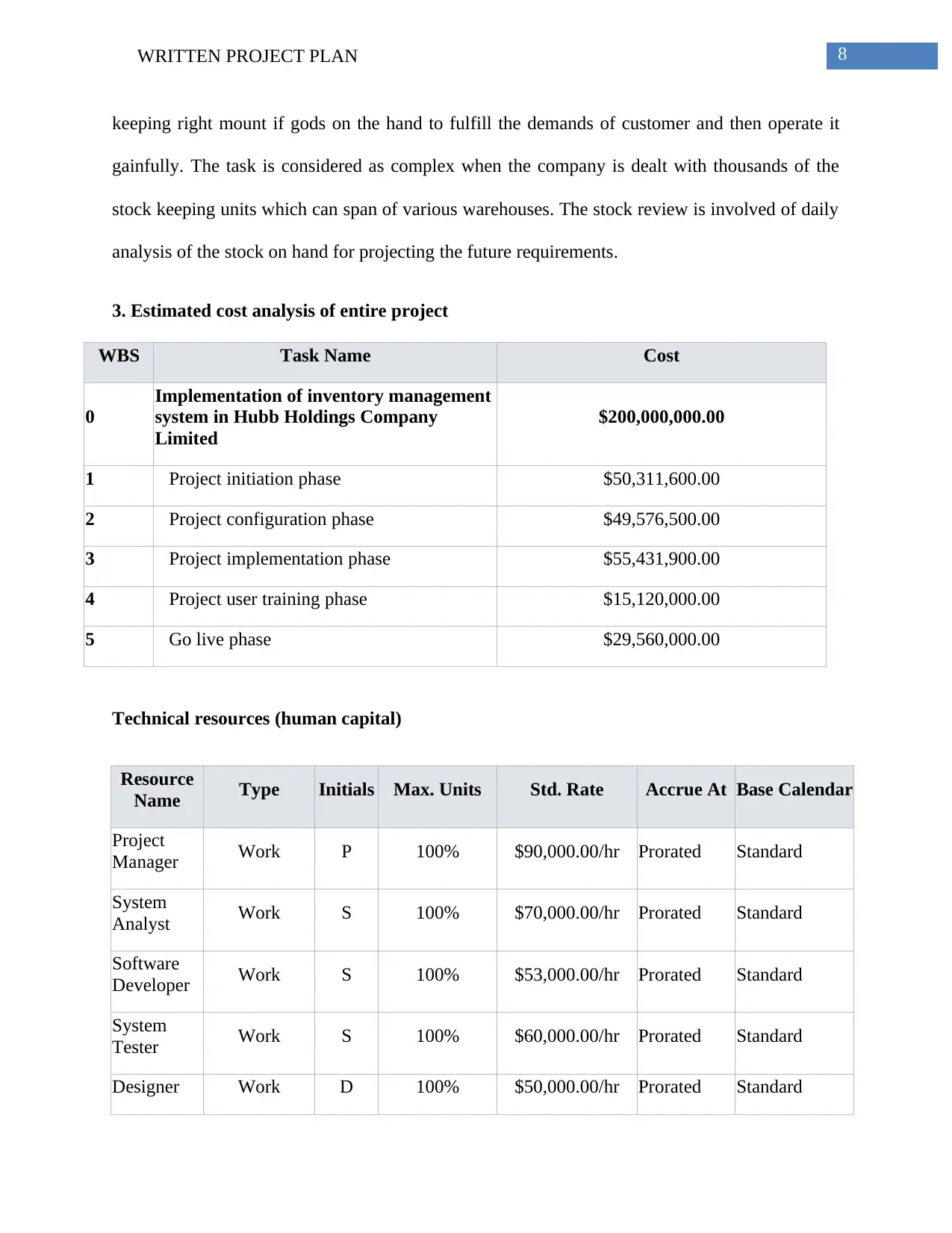
8WRITTEN PROJECT PLAN
keeping right mount if gods on the hand to fulfill the demands of customer and then operate it
gainfully. The task is considered as complex when the company is dealt with thousands of the
stock keeping units which can span of various warehouses. The stock review is involved of daily
analysis of the stock on hand for projecting the future requirements.
3. Estimated cost analysis of entire project
WBS Task Name Cost
0
Implementation of inventory management
system in Hubb Holdings Company
Limited
$200,000,000.00
1 Project initiation phase $50,311,600.00
2 Project configuration phase $49,576,500.00
3 Project implementation phase $55,431,900.00
4 Project user training phase $15,120,000.00
5 Go live phase $29,560,000.00
Technical resources (human capital)
Resource
Name Type Initials Max. Units Std. Rate Accrue At Base Calendar
Project
Manager Work P 100% $90,000.00/hr Prorated Standard
System
Analyst Work S 100% $70,000.00/hr Prorated Standard
Software
Developer Work S 100% $53,000.00/hr Prorated Standard
System
Tester Work S 100% $60,000.00/hr Prorated Standard
Designer Work D 100% $50,000.00/hr Prorated Standard
keeping right mount if gods on the hand to fulfill the demands of customer and then operate it
gainfully. The task is considered as complex when the company is dealt with thousands of the
stock keeping units which can span of various warehouses. The stock review is involved of daily
analysis of the stock on hand for projecting the future requirements.
3. Estimated cost analysis of entire project
WBS Task Name Cost
0
Implementation of inventory management
system in Hubb Holdings Company
Limited
$200,000,000.00
1 Project initiation phase $50,311,600.00
2 Project configuration phase $49,576,500.00
3 Project implementation phase $55,431,900.00
4 Project user training phase $15,120,000.00
5 Go live phase $29,560,000.00
Technical resources (human capital)
Resource
Name Type Initials Max. Units Std. Rate Accrue At Base Calendar
Project
Manager Work P 100% $90,000.00/hr Prorated Standard
System
Analyst Work S 100% $70,000.00/hr Prorated Standard
Software
Developer Work S 100% $53,000.00/hr Prorated Standard
System
Tester Work S 100% $60,000.00/hr Prorated Standard
Designer Work D 100% $50,000.00/hr Prorated Standard
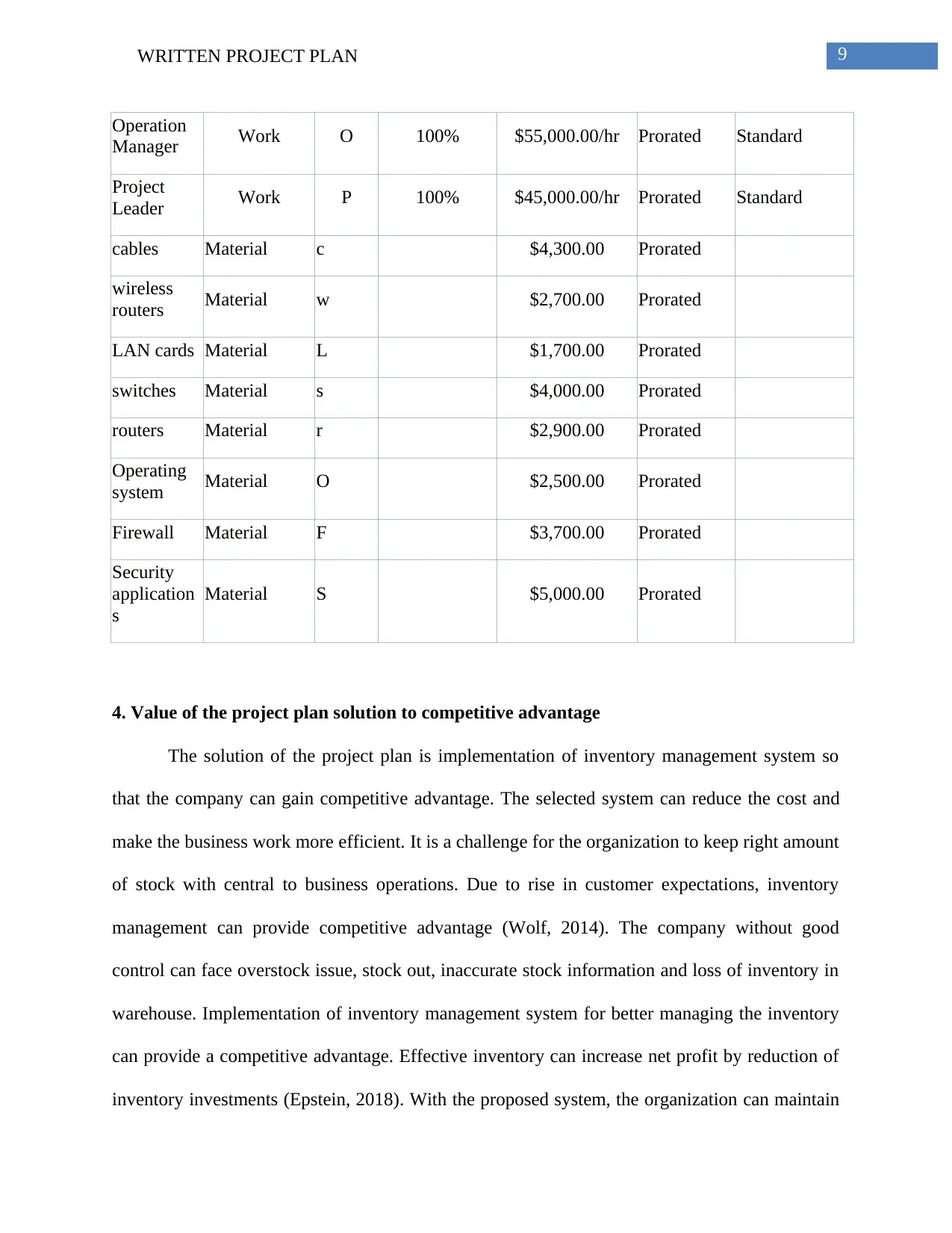
9WRITTEN PROJECT PLAN
Operation
Manager Work O 100% $55,000.00/hr Prorated Standard
Project
Leader Work P 100% $45,000.00/hr Prorated Standard
cables Material c $4,300.00 Prorated
wireless
routers Material w $2,700.00 Prorated
LAN cards Material L $1,700.00 Prorated
switches Material s $4,000.00 Prorated
routers Material r $2,900.00 Prorated
Operating
system Material O $2,500.00 Prorated
Firewall Material F $3,700.00 Prorated
Security
application
s
Material S $5,000.00 Prorated
4. Value of the project plan solution to competitive advantage
The solution of the project plan is implementation of inventory management system so
that the company can gain competitive advantage. The selected system can reduce the cost and
make the business work more efficient. It is a challenge for the organization to keep right amount
of stock with central to business operations. Due to rise in customer expectations, inventory
management can provide competitive advantage (Wolf, 2014). The company without good
control can face overstock issue, stock out, inaccurate stock information and loss of inventory in
warehouse. Implementation of inventory management system for better managing the inventory
can provide a competitive advantage. Effective inventory can increase net profit by reduction of
inventory investments (Epstein, 2018). With the proposed system, the organization can maintain
Operation
Manager Work O 100% $55,000.00/hr Prorated Standard
Project
Leader Work P 100% $45,000.00/hr Prorated Standard
cables Material c $4,300.00 Prorated
wireless
routers Material w $2,700.00 Prorated
LAN cards Material L $1,700.00 Prorated
switches Material s $4,000.00 Prorated
routers Material r $2,900.00 Prorated
Operating
system Material O $2,500.00 Prorated
Firewall Material F $3,700.00 Prorated
Security
application
s
Material S $5,000.00 Prorated
4. Value of the project plan solution to competitive advantage
The solution of the project plan is implementation of inventory management system so
that the company can gain competitive advantage. The selected system can reduce the cost and
make the business work more efficient. It is a challenge for the organization to keep right amount
of stock with central to business operations. Due to rise in customer expectations, inventory
management can provide competitive advantage (Wolf, 2014). The company without good
control can face overstock issue, stock out, inaccurate stock information and loss of inventory in
warehouse. Implementation of inventory management system for better managing the inventory
can provide a competitive advantage. Effective inventory can increase net profit by reduction of
inventory investments (Epstein, 2018). With the proposed system, the organization can maintain
Secure Best Marks with AI Grader
Need help grading? Try our AI Grader for instant feedback on your assignments.
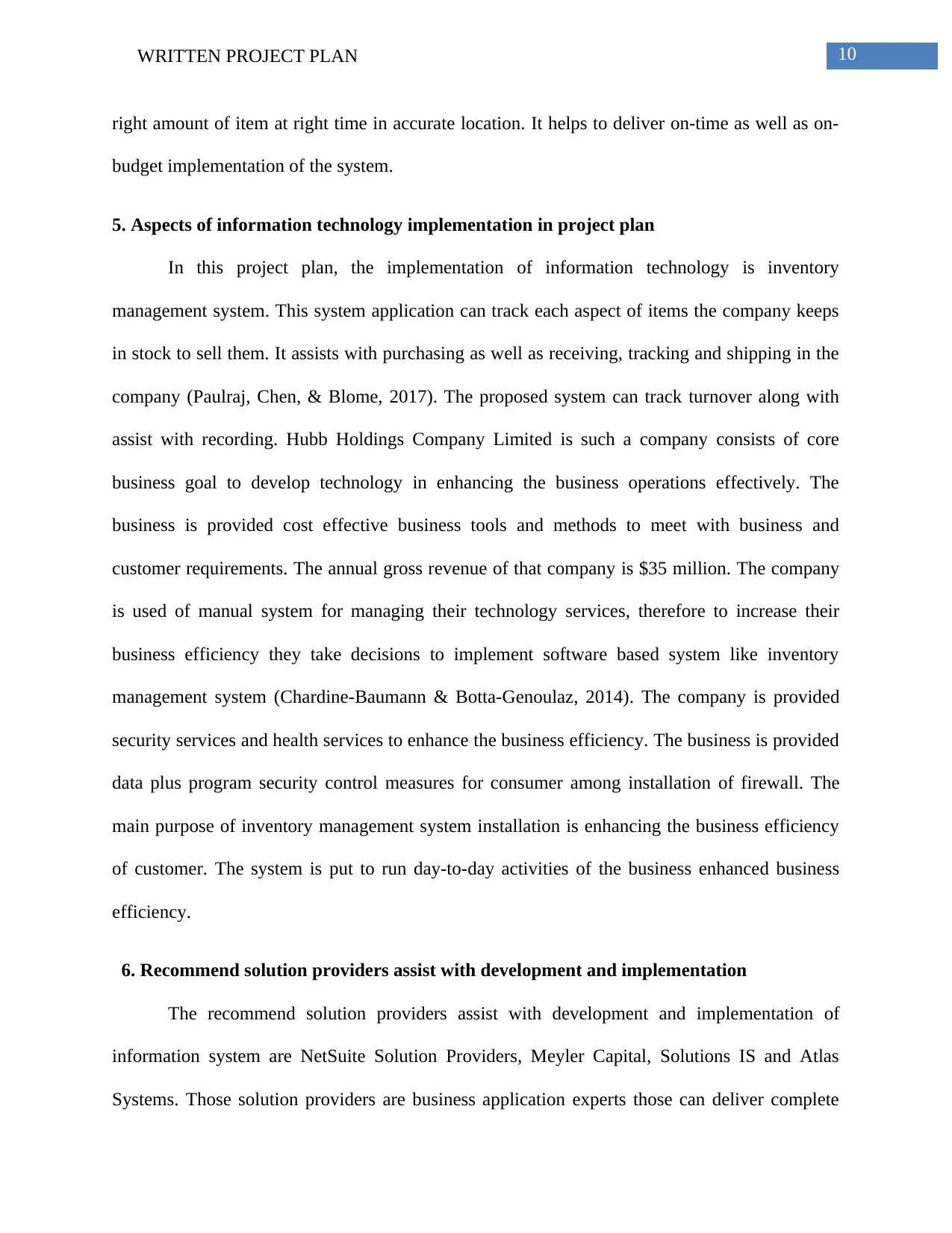
10WRITTEN PROJECT PLAN
right amount of item at right time in accurate location. It helps to deliver on-time as well as on-
budget implementation of the system.
5. Aspects of information technology implementation in project plan
In this project plan, the implementation of information technology is inventory
management system. This system application can track each aspect of items the company keeps
in stock to sell them. It assists with purchasing as well as receiving, tracking and shipping in the
company (Paulraj, Chen, & Blome, 2017). The proposed system can track turnover along with
assist with recording. Hubb Holdings Company Limited is such a company consists of core
business goal to develop technology in enhancing the business operations effectively. The
business is provided cost effective business tools and methods to meet with business and
customer requirements. The annual gross revenue of that company is $35 million. The company
is used of manual system for managing their technology services, therefore to increase their
business efficiency they take decisions to implement software based system like inventory
management system (Chardine-Baumann & Botta-Genoulaz, 2014). The company is provided
security services and health services to enhance the business efficiency. The business is provided
data plus program security control measures for consumer among installation of firewall. The
main purpose of inventory management system installation is enhancing the business efficiency
of customer. The system is put to run day-to-day activities of the business enhanced business
efficiency.
6. Recommend solution providers assist with development and implementation
The recommend solution providers assist with development and implementation of
information system are NetSuite Solution Providers, Meyler Capital, Solutions IS and Atlas
Systems. Those solution providers are business application experts those can deliver complete
right amount of item at right time in accurate location. It helps to deliver on-time as well as on-
budget implementation of the system.
5. Aspects of information technology implementation in project plan
In this project plan, the implementation of information technology is inventory
management system. This system application can track each aspect of items the company keeps
in stock to sell them. It assists with purchasing as well as receiving, tracking and shipping in the
company (Paulraj, Chen, & Blome, 2017). The proposed system can track turnover along with
assist with recording. Hubb Holdings Company Limited is such a company consists of core
business goal to develop technology in enhancing the business operations effectively. The
business is provided cost effective business tools and methods to meet with business and
customer requirements. The annual gross revenue of that company is $35 million. The company
is used of manual system for managing their technology services, therefore to increase their
business efficiency they take decisions to implement software based system like inventory
management system (Chardine-Baumann & Botta-Genoulaz, 2014). The company is provided
security services and health services to enhance the business efficiency. The business is provided
data plus program security control measures for consumer among installation of firewall. The
main purpose of inventory management system installation is enhancing the business efficiency
of customer. The system is put to run day-to-day activities of the business enhanced business
efficiency.
6. Recommend solution providers assist with development and implementation
The recommend solution providers assist with development and implementation of
information system are NetSuite Solution Providers, Meyler Capital, Solutions IS and Atlas
Systems. Those solution providers are business application experts those can deliver complete
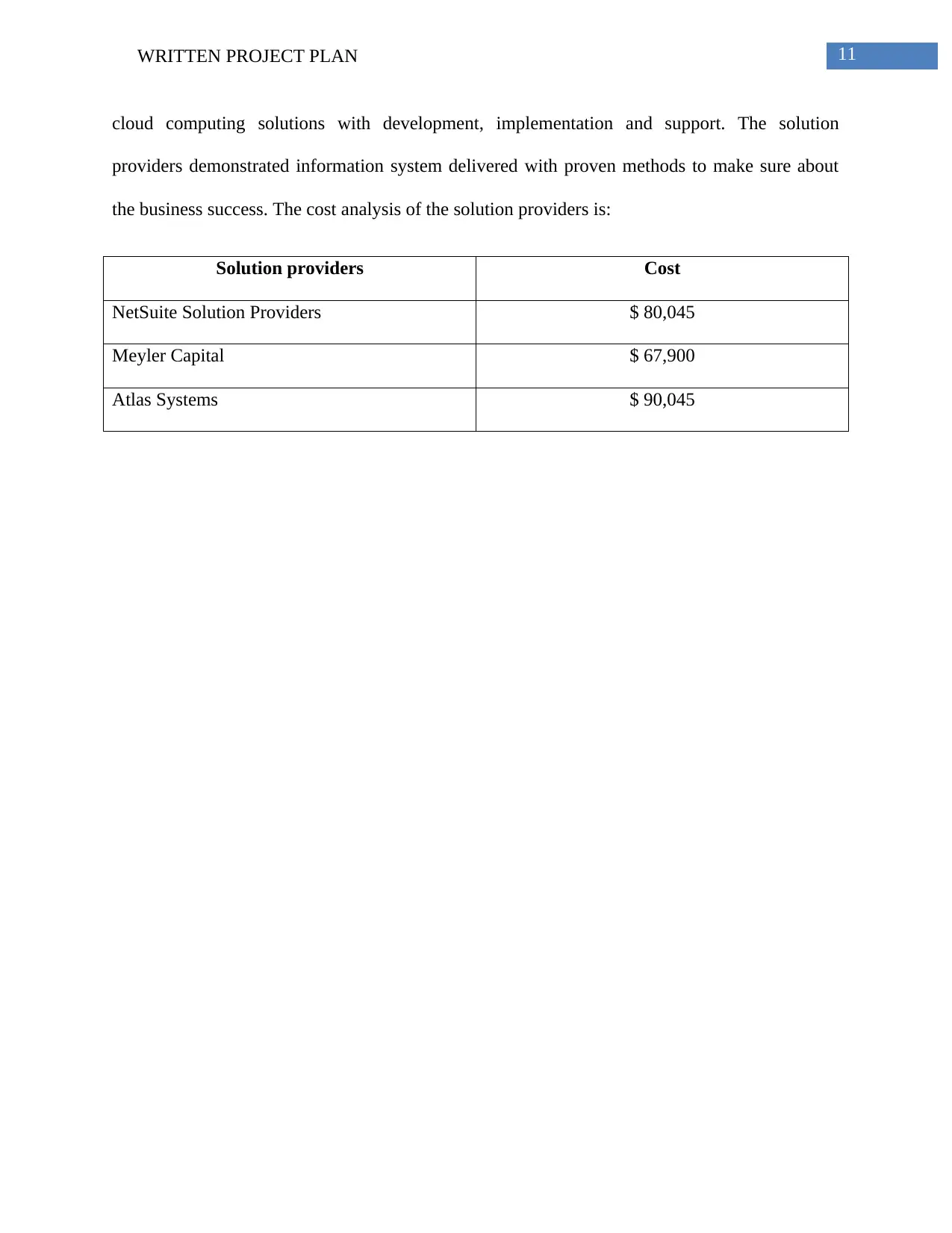
11WRITTEN PROJECT PLAN
cloud computing solutions with development, implementation and support. The solution
providers demonstrated information system delivered with proven methods to make sure about
the business success. The cost analysis of the solution providers is:
Solution providers Cost
NetSuite Solution Providers $ 80,045
Meyler Capital $ 67,900
Atlas Systems $ 90,045
cloud computing solutions with development, implementation and support. The solution
providers demonstrated information system delivered with proven methods to make sure about
the business success. The cost analysis of the solution providers is:
Solution providers Cost
NetSuite Solution Providers $ 80,045
Meyler Capital $ 67,900
Atlas Systems $ 90,045
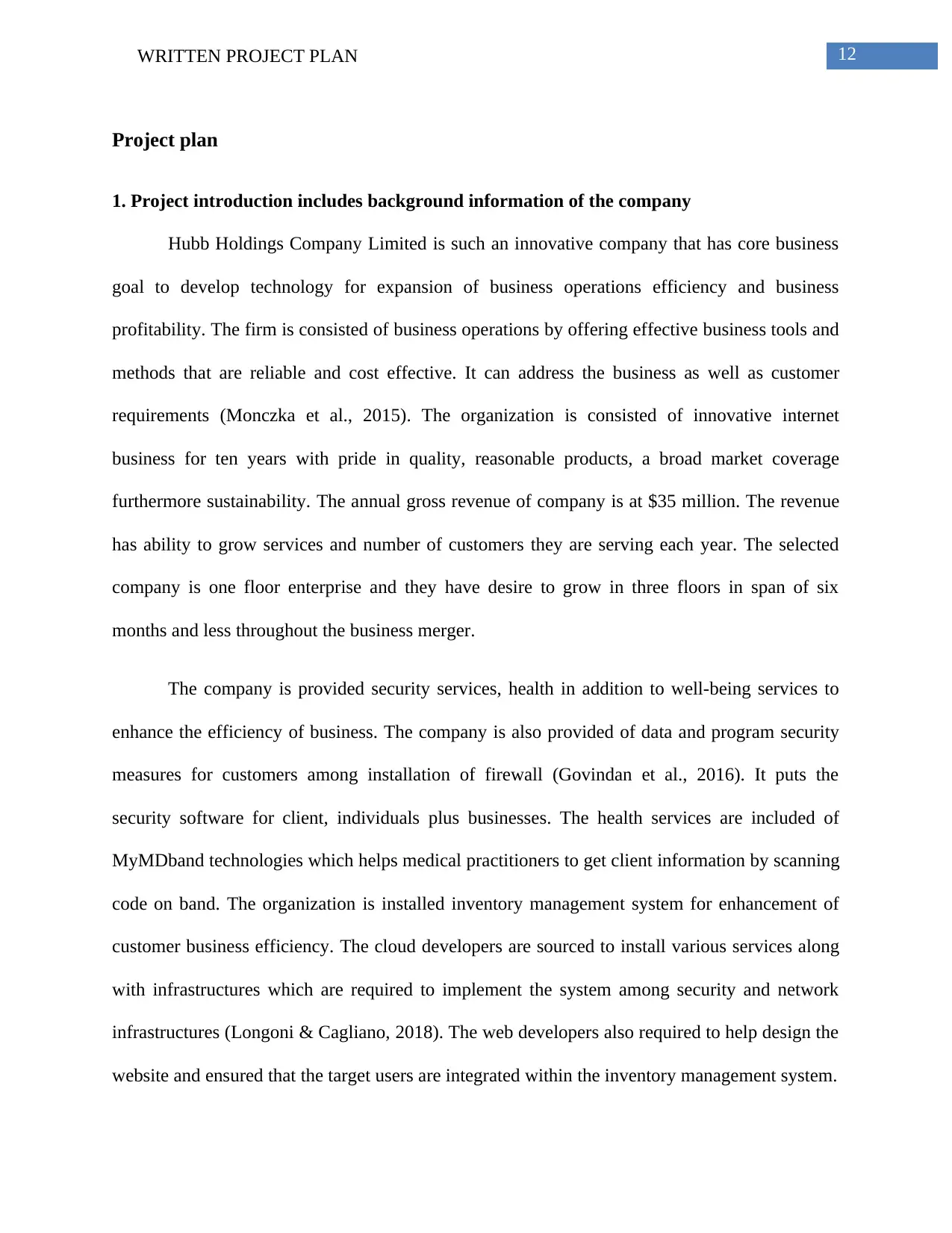
12WRITTEN PROJECT PLAN
Project plan
1. Project introduction includes background information of the company
Hubb Holdings Company Limited is such an innovative company that has core business
goal to develop technology for expansion of business operations efficiency and business
profitability. The firm is consisted of business operations by offering effective business tools and
methods that are reliable and cost effective. It can address the business as well as customer
requirements (Monczka et al., 2015). The organization is consisted of innovative internet
business for ten years with pride in quality, reasonable products, a broad market coverage
furthermore sustainability. The annual gross revenue of company is at $35 million. The revenue
has ability to grow services and number of customers they are serving each year. The selected
company is one floor enterprise and they have desire to grow in three floors in span of six
months and less throughout the business merger.
The company is provided security services, health in addition to well-being services to
enhance the efficiency of business. The company is also provided of data and program security
measures for customers among installation of firewall (Govindan et al., 2016). It puts the
security software for client, individuals plus businesses. The health services are included of
MyMDband technologies which helps medical practitioners to get client information by scanning
code on band. The organization is installed inventory management system for enhancement of
customer business efficiency. The cloud developers are sourced to install various services along
with infrastructures which are required to implement the system among security and network
infrastructures (Longoni & Cagliano, 2018). The web developers also required to help design the
website and ensured that the target users are integrated within the inventory management system.
Project plan
1. Project introduction includes background information of the company
Hubb Holdings Company Limited is such an innovative company that has core business
goal to develop technology for expansion of business operations efficiency and business
profitability. The firm is consisted of business operations by offering effective business tools and
methods that are reliable and cost effective. It can address the business as well as customer
requirements (Monczka et al., 2015). The organization is consisted of innovative internet
business for ten years with pride in quality, reasonable products, a broad market coverage
furthermore sustainability. The annual gross revenue of company is at $35 million. The revenue
has ability to grow services and number of customers they are serving each year. The selected
company is one floor enterprise and they have desire to grow in three floors in span of six
months and less throughout the business merger.
The company is provided security services, health in addition to well-being services to
enhance the efficiency of business. The company is also provided of data and program security
measures for customers among installation of firewall (Govindan et al., 2016). It puts the
security software for client, individuals plus businesses. The health services are included of
MyMDband technologies which helps medical practitioners to get client information by scanning
code on band. The organization is installed inventory management system for enhancement of
customer business efficiency. The cloud developers are sourced to install various services along
with infrastructures which are required to implement the system among security and network
infrastructures (Longoni & Cagliano, 2018). The web developers also required to help design the
website and ensured that the target users are integrated within the inventory management system.
Paraphrase This Document
Need a fresh take? Get an instant paraphrase of this document with our AI Paraphraser
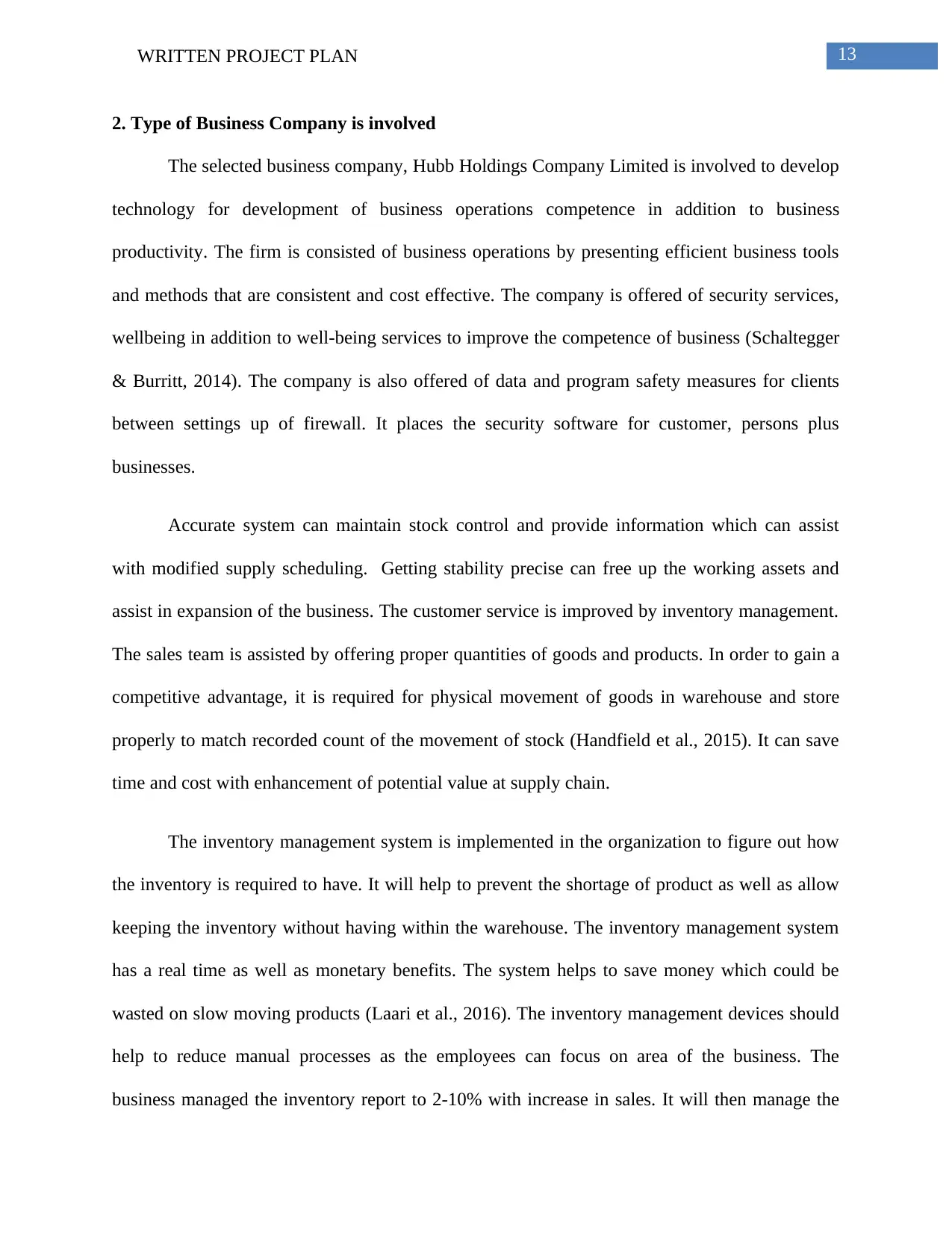
13WRITTEN PROJECT PLAN
2. Type of Business Company is involved
The selected business company, Hubb Holdings Company Limited is involved to develop
technology for development of business operations competence in addition to business
productivity. The firm is consisted of business operations by presenting efficient business tools
and methods that are consistent and cost effective. The company is offered of security services,
wellbeing in addition to well-being services to improve the competence of business (Schaltegger
& Burritt, 2014). The company is also offered of data and program safety measures for clients
between settings up of firewall. It places the security software for customer, persons plus
businesses.
Accurate system can maintain stock control and provide information which can assist
with modified supply scheduling. Getting stability precise can free up the working assets and
assist in expansion of the business. The customer service is improved by inventory management.
The sales team is assisted by offering proper quantities of goods and products. In order to gain a
competitive advantage, it is required for physical movement of goods in warehouse and store
properly to match recorded count of the movement of stock (Handfield et al., 2015). It can save
time and cost with enhancement of potential value at supply chain.
The inventory management system is implemented in the organization to figure out how
the inventory is required to have. It will help to prevent the shortage of product as well as allow
keeping the inventory without having within the warehouse. The inventory management system
has a real time as well as monetary benefits. The system helps to save money which could be
wasted on slow moving products (Laari et al., 2016). The inventory management devices should
help to reduce manual processes as the employees can focus on area of the business. The
business managed the inventory report to 2-10% with increase in sales. It will then manage the
2. Type of Business Company is involved
The selected business company, Hubb Holdings Company Limited is involved to develop
technology for development of business operations competence in addition to business
productivity. The firm is consisted of business operations by presenting efficient business tools
and methods that are consistent and cost effective. The company is offered of security services,
wellbeing in addition to well-being services to improve the competence of business (Schaltegger
& Burritt, 2014). The company is also offered of data and program safety measures for clients
between settings up of firewall. It places the security software for customer, persons plus
businesses.
Accurate system can maintain stock control and provide information which can assist
with modified supply scheduling. Getting stability precise can free up the working assets and
assist in expansion of the business. The customer service is improved by inventory management.
The sales team is assisted by offering proper quantities of goods and products. In order to gain a
competitive advantage, it is required for physical movement of goods in warehouse and store
properly to match recorded count of the movement of stock (Handfield et al., 2015). It can save
time and cost with enhancement of potential value at supply chain.
The inventory management system is implemented in the organization to figure out how
the inventory is required to have. It will help to prevent the shortage of product as well as allow
keeping the inventory without having within the warehouse. The inventory management system
has a real time as well as monetary benefits. The system helps to save money which could be
wasted on slow moving products (Laari et al., 2016). The inventory management devices should
help to reduce manual processes as the employees can focus on area of the business. The
business managed the inventory report to 2-10% with increase in sales. It will then manage the
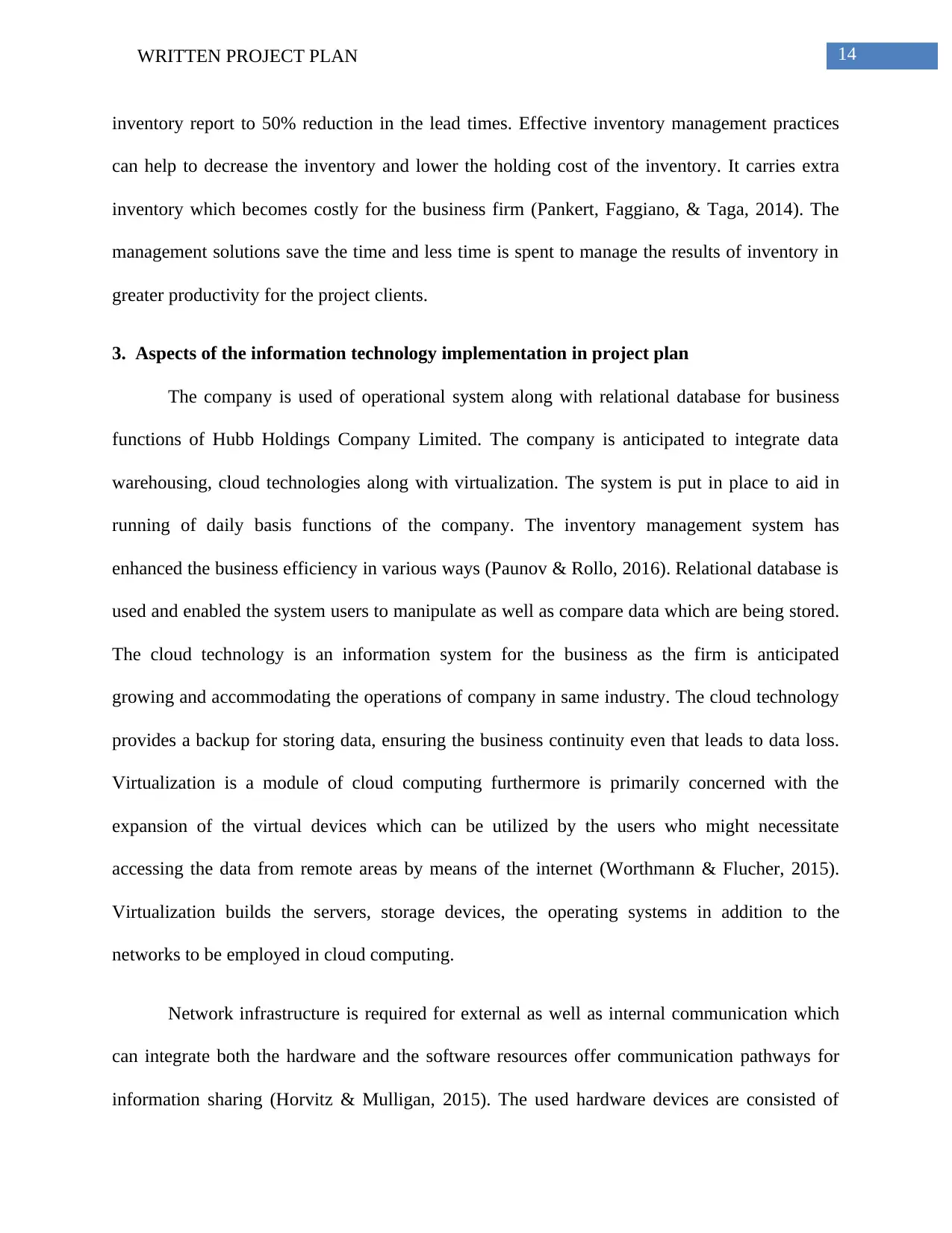
14WRITTEN PROJECT PLAN
inventory report to 50% reduction in the lead times. Effective inventory management practices
can help to decrease the inventory and lower the holding cost of the inventory. It carries extra
inventory which becomes costly for the business firm (Pankert, Faggiano, & Taga, 2014). The
management solutions save the time and less time is spent to manage the results of inventory in
greater productivity for the project clients.
3. Aspects of the information technology implementation in project plan
The company is used of operational system along with relational database for business
functions of Hubb Holdings Company Limited. The company is anticipated to integrate data
warehousing, cloud technologies along with virtualization. The system is put in place to aid in
running of daily basis functions of the company. The inventory management system has
enhanced the business efficiency in various ways (Paunov & Rollo, 2016). Relational database is
used and enabled the system users to manipulate as well as compare data which are being stored.
The cloud technology is an information system for the business as the firm is anticipated
growing and accommodating the operations of company in same industry. The cloud technology
provides a backup for storing data, ensuring the business continuity even that leads to data loss.
Virtualization is a module of cloud computing furthermore is primarily concerned with the
expansion of the virtual devices which can be utilized by the users who might necessitate
accessing the data from remote areas by means of the internet (Worthmann & Flucher, 2015).
Virtualization builds the servers, storage devices, the operating systems in addition to the
networks to be employed in cloud computing.
Network infrastructure is required for external as well as internal communication which
can integrate both the hardware and the software resources offer communication pathways for
information sharing (Horvitz & Mulligan, 2015). The used hardware devices are consisted of
inventory report to 50% reduction in the lead times. Effective inventory management practices
can help to decrease the inventory and lower the holding cost of the inventory. It carries extra
inventory which becomes costly for the business firm (Pankert, Faggiano, & Taga, 2014). The
management solutions save the time and less time is spent to manage the results of inventory in
greater productivity for the project clients.
3. Aspects of the information technology implementation in project plan
The company is used of operational system along with relational database for business
functions of Hubb Holdings Company Limited. The company is anticipated to integrate data
warehousing, cloud technologies along with virtualization. The system is put in place to aid in
running of daily basis functions of the company. The inventory management system has
enhanced the business efficiency in various ways (Paunov & Rollo, 2016). Relational database is
used and enabled the system users to manipulate as well as compare data which are being stored.
The cloud technology is an information system for the business as the firm is anticipated
growing and accommodating the operations of company in same industry. The cloud technology
provides a backup for storing data, ensuring the business continuity even that leads to data loss.
Virtualization is a module of cloud computing furthermore is primarily concerned with the
expansion of the virtual devices which can be utilized by the users who might necessitate
accessing the data from remote areas by means of the internet (Worthmann & Flucher, 2015).
Virtualization builds the servers, storage devices, the operating systems in addition to the
networks to be employed in cloud computing.
Network infrastructure is required for external as well as internal communication which
can integrate both the hardware and the software resources offer communication pathways for
information sharing (Horvitz & Mulligan, 2015). The used hardware devices are consisted of
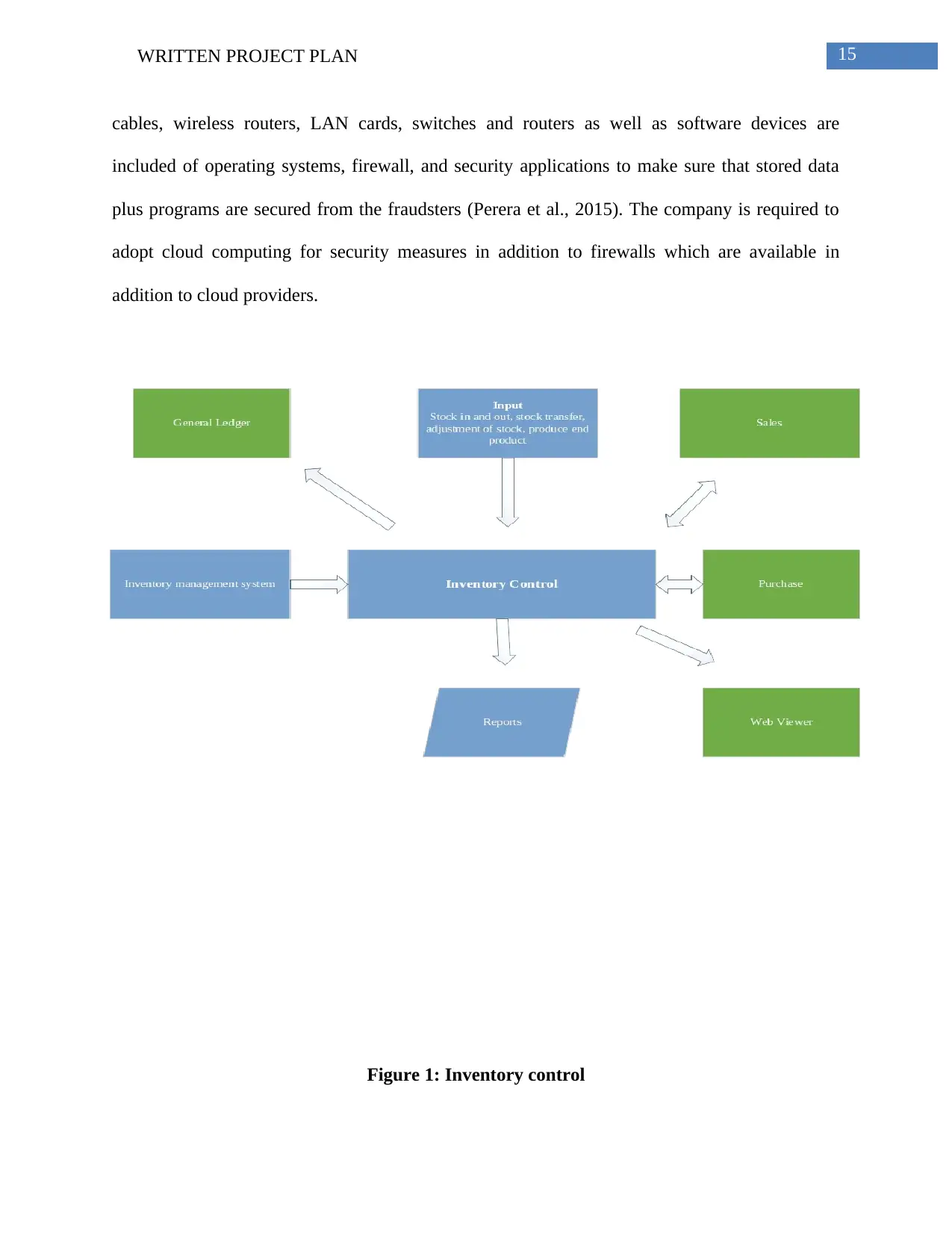
15WRITTEN PROJECT PLAN
cables, wireless routers, LAN cards, switches and routers as well as software devices are
included of operating systems, firewall, and security applications to make sure that stored data
plus programs are secured from the fraudsters (Perera et al., 2015). The company is required to
adopt cloud computing for security measures in addition to firewalls which are available in
addition to cloud providers.
Figure 1: Inventory control
cables, wireless routers, LAN cards, switches and routers as well as software devices are
included of operating systems, firewall, and security applications to make sure that stored data
plus programs are secured from the fraudsters (Perera et al., 2015). The company is required to
adopt cloud computing for security measures in addition to firewalls which are available in
addition to cloud providers.
Figure 1: Inventory control
Secure Best Marks with AI Grader
Need help grading? Try our AI Grader for instant feedback on your assignments.
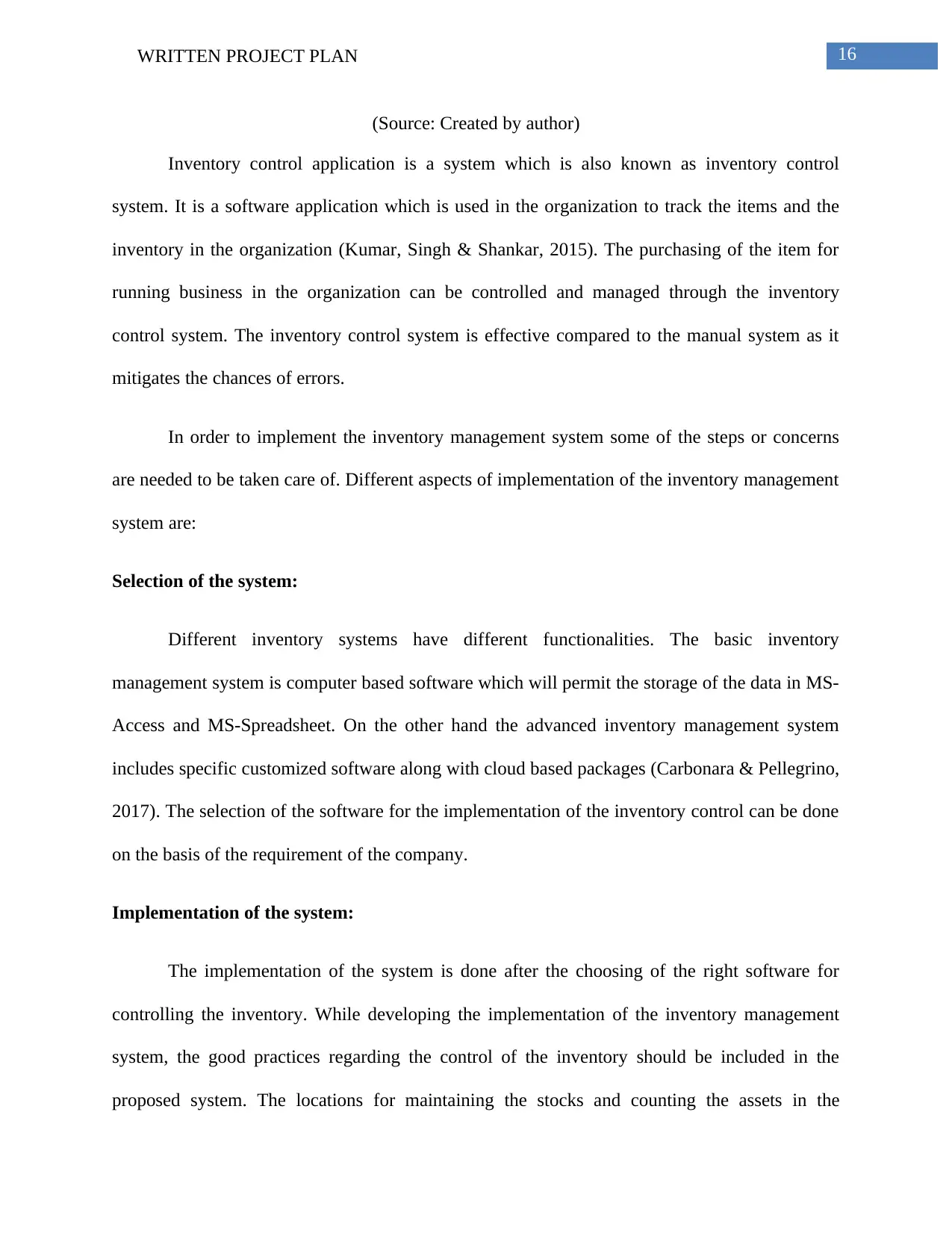
16WRITTEN PROJECT PLAN
(Source: Created by author)
Inventory control application is a system which is also known as inventory control
system. It is a software application which is used in the organization to track the items and the
inventory in the organization (Kumar, Singh & Shankar, 2015). The purchasing of the item for
running business in the organization can be controlled and managed through the inventory
control system. The inventory control system is effective compared to the manual system as it
mitigates the chances of errors.
In order to implement the inventory management system some of the steps or concerns
are needed to be taken care of. Different aspects of implementation of the inventory management
system are:
Selection of the system:
Different inventory systems have different functionalities. The basic inventory
management system is computer based software which will permit the storage of the data in MS-
Access and MS-Spreadsheet. On the other hand the advanced inventory management system
includes specific customized software along with cloud based packages (Carbonara & Pellegrino,
2017). The selection of the software for the implementation of the inventory control can be done
on the basis of the requirement of the company.
Implementation of the system:
The implementation of the system is done after the choosing of the right software for
controlling the inventory. While developing the implementation of the inventory management
system, the good practices regarding the control of the inventory should be included in the
proposed system. The locations for maintaining the stocks and counting the assets in the
(Source: Created by author)
Inventory control application is a system which is also known as inventory control
system. It is a software application which is used in the organization to track the items and the
inventory in the organization (Kumar, Singh & Shankar, 2015). The purchasing of the item for
running business in the organization can be controlled and managed through the inventory
control system. The inventory control system is effective compared to the manual system as it
mitigates the chances of errors.
In order to implement the inventory management system some of the steps or concerns
are needed to be taken care of. Different aspects of implementation of the inventory management
system are:
Selection of the system:
Different inventory systems have different functionalities. The basic inventory
management system is computer based software which will permit the storage of the data in MS-
Access and MS-Spreadsheet. On the other hand the advanced inventory management system
includes specific customized software along with cloud based packages (Carbonara & Pellegrino,
2017). The selection of the software for the implementation of the inventory control can be done
on the basis of the requirement of the company.
Implementation of the system:
The implementation of the system is done after the choosing of the right software for
controlling the inventory. While developing the implementation of the inventory management
system, the good practices regarding the control of the inventory should be included in the
proposed system. The locations for maintaining the stocks and counting the assets in the
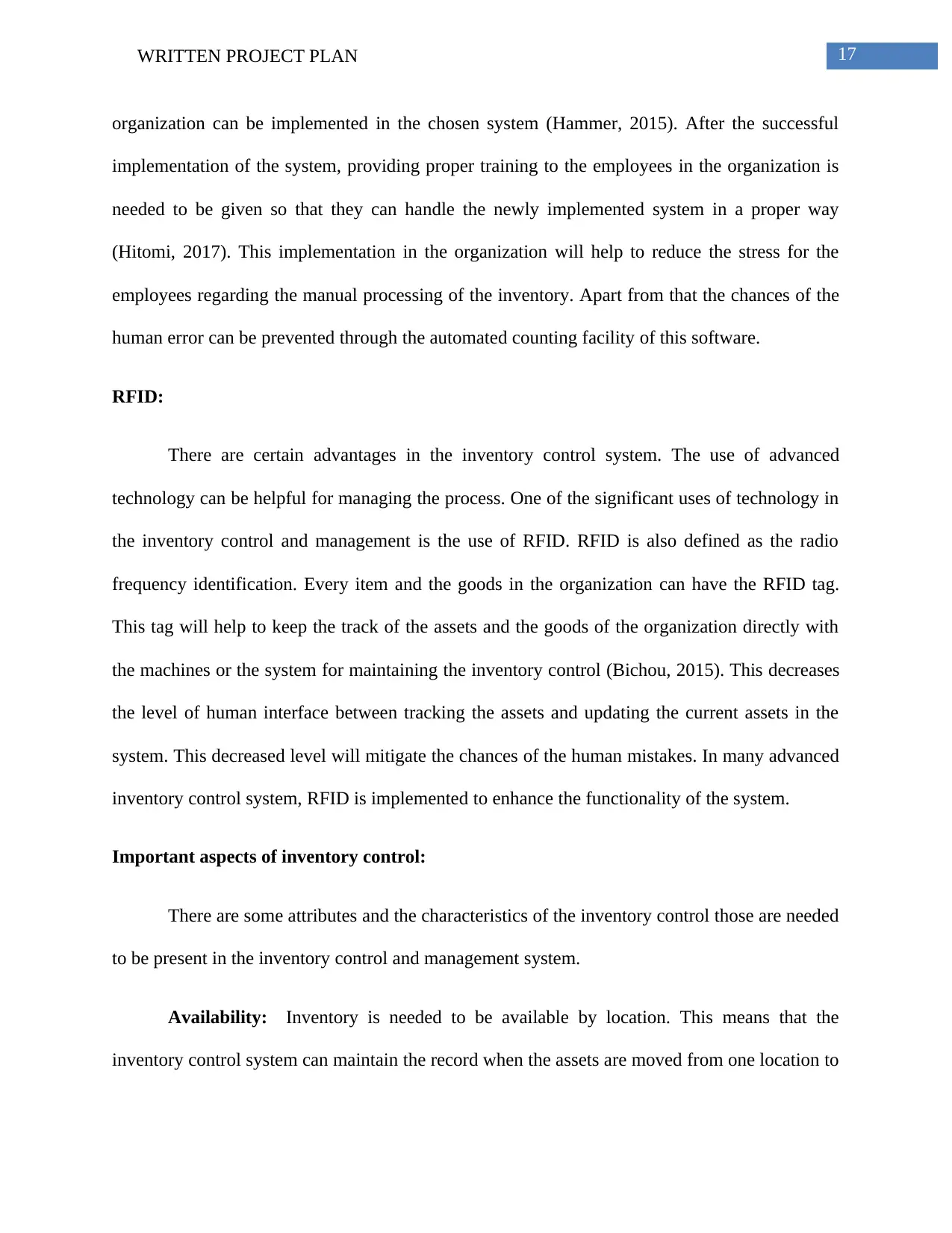
17WRITTEN PROJECT PLAN
organization can be implemented in the chosen system (Hammer, 2015). After the successful
implementation of the system, providing proper training to the employees in the organization is
needed to be given so that they can handle the newly implemented system in a proper way
(Hitomi, 2017). This implementation in the organization will help to reduce the stress for the
employees regarding the manual processing of the inventory. Apart from that the chances of the
human error can be prevented through the automated counting facility of this software.
RFID:
There are certain advantages in the inventory control system. The use of advanced
technology can be helpful for managing the process. One of the significant uses of technology in
the inventory control and management is the use of RFID. RFID is also defined as the radio
frequency identification. Every item and the goods in the organization can have the RFID tag.
This tag will help to keep the track of the assets and the goods of the organization directly with
the machines or the system for maintaining the inventory control (Bichou, 2015). This decreases
the level of human interface between tracking the assets and updating the current assets in the
system. This decreased level will mitigate the chances of the human mistakes. In many advanced
inventory control system, RFID is implemented to enhance the functionality of the system.
Important aspects of inventory control:
There are some attributes and the characteristics of the inventory control those are needed
to be present in the inventory control and management system.
Availability: Inventory is needed to be available by location. This means that the
inventory control system can maintain the record when the assets are moved from one location to
organization can be implemented in the chosen system (Hammer, 2015). After the successful
implementation of the system, providing proper training to the employees in the organization is
needed to be given so that they can handle the newly implemented system in a proper way
(Hitomi, 2017). This implementation in the organization will help to reduce the stress for the
employees regarding the manual processing of the inventory. Apart from that the chances of the
human error can be prevented through the automated counting facility of this software.
RFID:
There are certain advantages in the inventory control system. The use of advanced
technology can be helpful for managing the process. One of the significant uses of technology in
the inventory control and management is the use of RFID. RFID is also defined as the radio
frequency identification. Every item and the goods in the organization can have the RFID tag.
This tag will help to keep the track of the assets and the goods of the organization directly with
the machines or the system for maintaining the inventory control (Bichou, 2015). This decreases
the level of human interface between tracking the assets and updating the current assets in the
system. This decreased level will mitigate the chances of the human mistakes. In many advanced
inventory control system, RFID is implemented to enhance the functionality of the system.
Important aspects of inventory control:
There are some attributes and the characteristics of the inventory control those are needed
to be present in the inventory control and management system.
Availability: Inventory is needed to be available by location. This means that the
inventory control system can maintain the record when the assets are moved from one location to
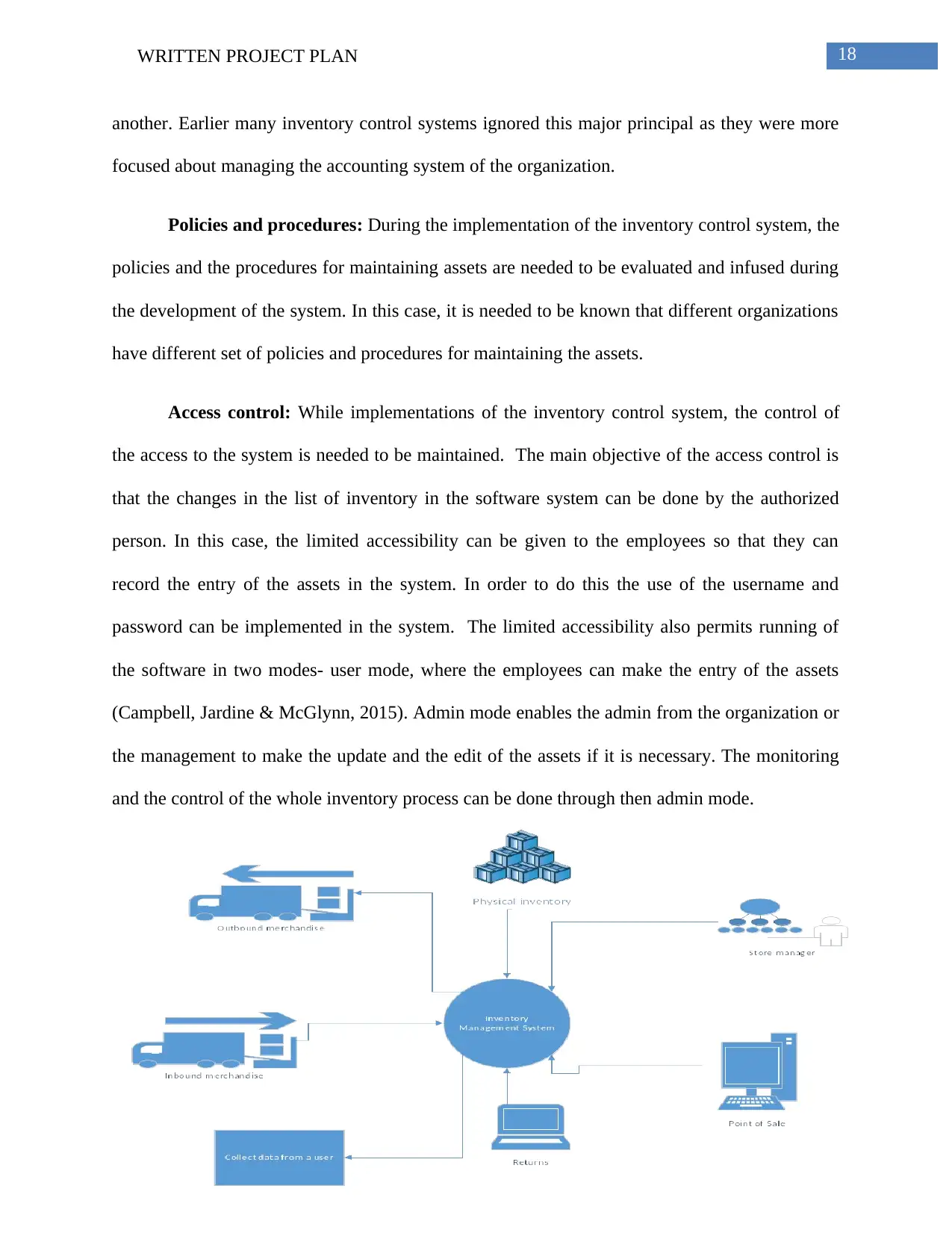
18WRITTEN PROJECT PLAN
another. Earlier many inventory control systems ignored this major principal as they were more
focused about managing the accounting system of the organization.
Policies and procedures: During the implementation of the inventory control system, the
policies and the procedures for maintaining assets are needed to be evaluated and infused during
the development of the system. In this case, it is needed to be known that different organizations
have different set of policies and procedures for maintaining the assets.
Access control: While implementations of the inventory control system, the control of
the access to the system is needed to be maintained. The main objective of the access control is
that the changes in the list of inventory in the software system can be done by the authorized
person. In this case, the limited accessibility can be given to the employees so that they can
record the entry of the assets in the system. In order to do this the use of the username and
password can be implemented in the system. The limited accessibility also permits running of
the software in two modes- user mode, where the employees can make the entry of the assets
(Campbell, Jardine & McGlynn, 2015). Admin mode enables the admin from the organization or
the management to make the update and the edit of the assets if it is necessary. The monitoring
and the control of the whole inventory process can be done through then admin mode.
another. Earlier many inventory control systems ignored this major principal as they were more
focused about managing the accounting system of the organization.
Policies and procedures: During the implementation of the inventory control system, the
policies and the procedures for maintaining assets are needed to be evaluated and infused during
the development of the system. In this case, it is needed to be known that different organizations
have different set of policies and procedures for maintaining the assets.
Access control: While implementations of the inventory control system, the control of
the access to the system is needed to be maintained. The main objective of the access control is
that the changes in the list of inventory in the software system can be done by the authorized
person. In this case, the limited accessibility can be given to the employees so that they can
record the entry of the assets in the system. In order to do this the use of the username and
password can be implemented in the system. The limited accessibility also permits running of
the software in two modes- user mode, where the employees can make the entry of the assets
(Campbell, Jardine & McGlynn, 2015). Admin mode enables the admin from the organization or
the management to make the update and the edit of the assets if it is necessary. The monitoring
and the control of the whole inventory process can be done through then admin mode.
Paraphrase This Document
Need a fresh take? Get an instant paraphrase of this document with our AI Paraphraser
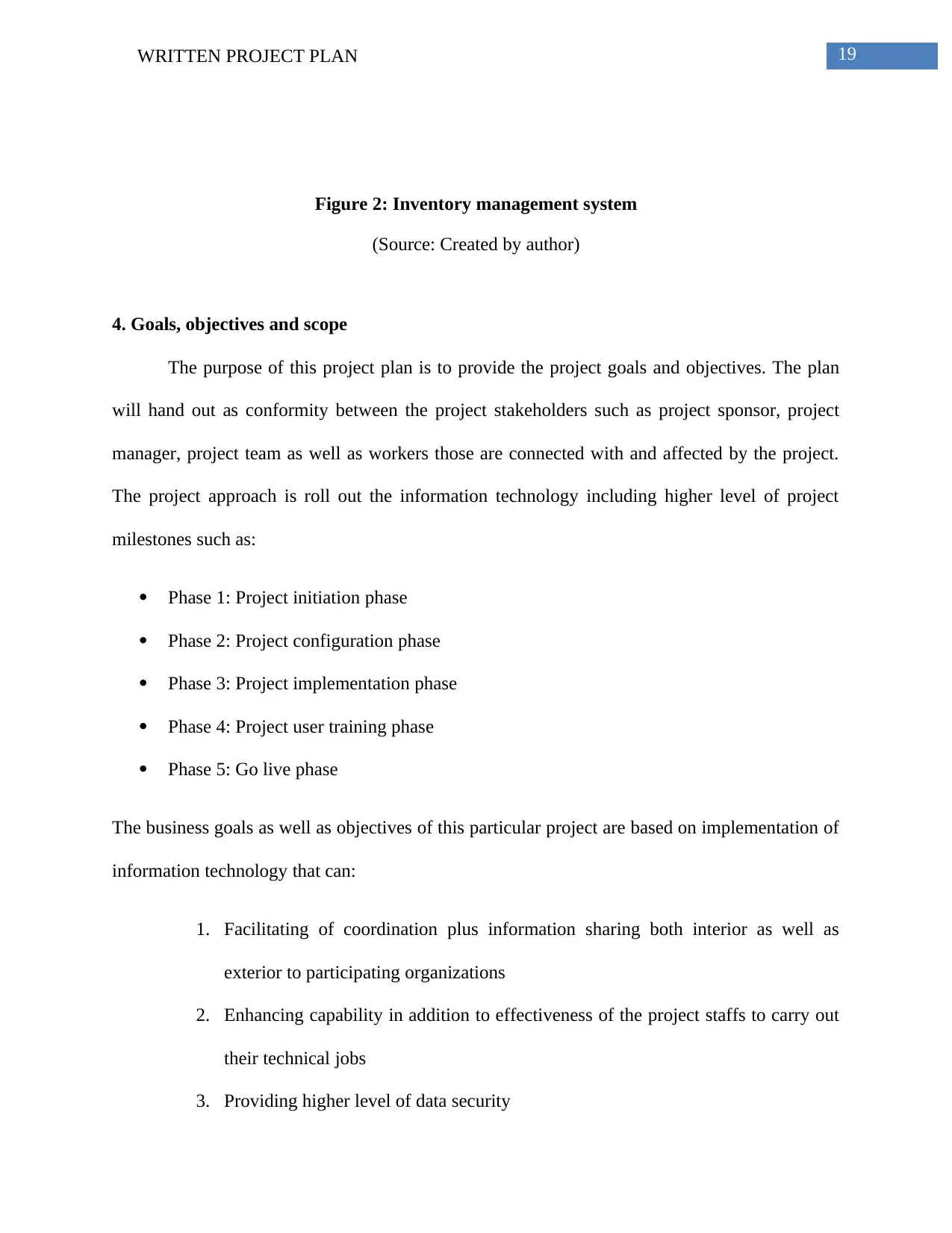
19WRITTEN PROJECT PLAN
Figure 2: Inventory management system
(Source: Created by author)
4. Goals, objectives and scope
The purpose of this project plan is to provide the project goals and objectives. The plan
will hand out as conformity between the project stakeholders such as project sponsor, project
manager, project team as well as workers those are connected with and affected by the project.
The project approach is roll out the information technology including higher level of project
milestones such as:
Phase 1: Project initiation phase
Phase 2: Project configuration phase
Phase 3: Project implementation phase
Phase 4: Project user training phase
Phase 5: Go live phase
The business goals as well as objectives of this particular project are based on implementation of
information technology that can:
1. Facilitating of coordination plus information sharing both interior as well as
exterior to participating organizations
2. Enhancing capability in addition to effectiveness of the project staffs to carry out
their technical jobs
3. Providing higher level of data security
Figure 2: Inventory management system
(Source: Created by author)
4. Goals, objectives and scope
The purpose of this project plan is to provide the project goals and objectives. The plan
will hand out as conformity between the project stakeholders such as project sponsor, project
manager, project team as well as workers those are connected with and affected by the project.
The project approach is roll out the information technology including higher level of project
milestones such as:
Phase 1: Project initiation phase
Phase 2: Project configuration phase
Phase 3: Project implementation phase
Phase 4: Project user training phase
Phase 5: Go live phase
The business goals as well as objectives of this particular project are based on implementation of
information technology that can:
1. Facilitating of coordination plus information sharing both interior as well as
exterior to participating organizations
2. Enhancing capability in addition to effectiveness of the project staffs to carry out
their technical jobs
3. Providing higher level of data security
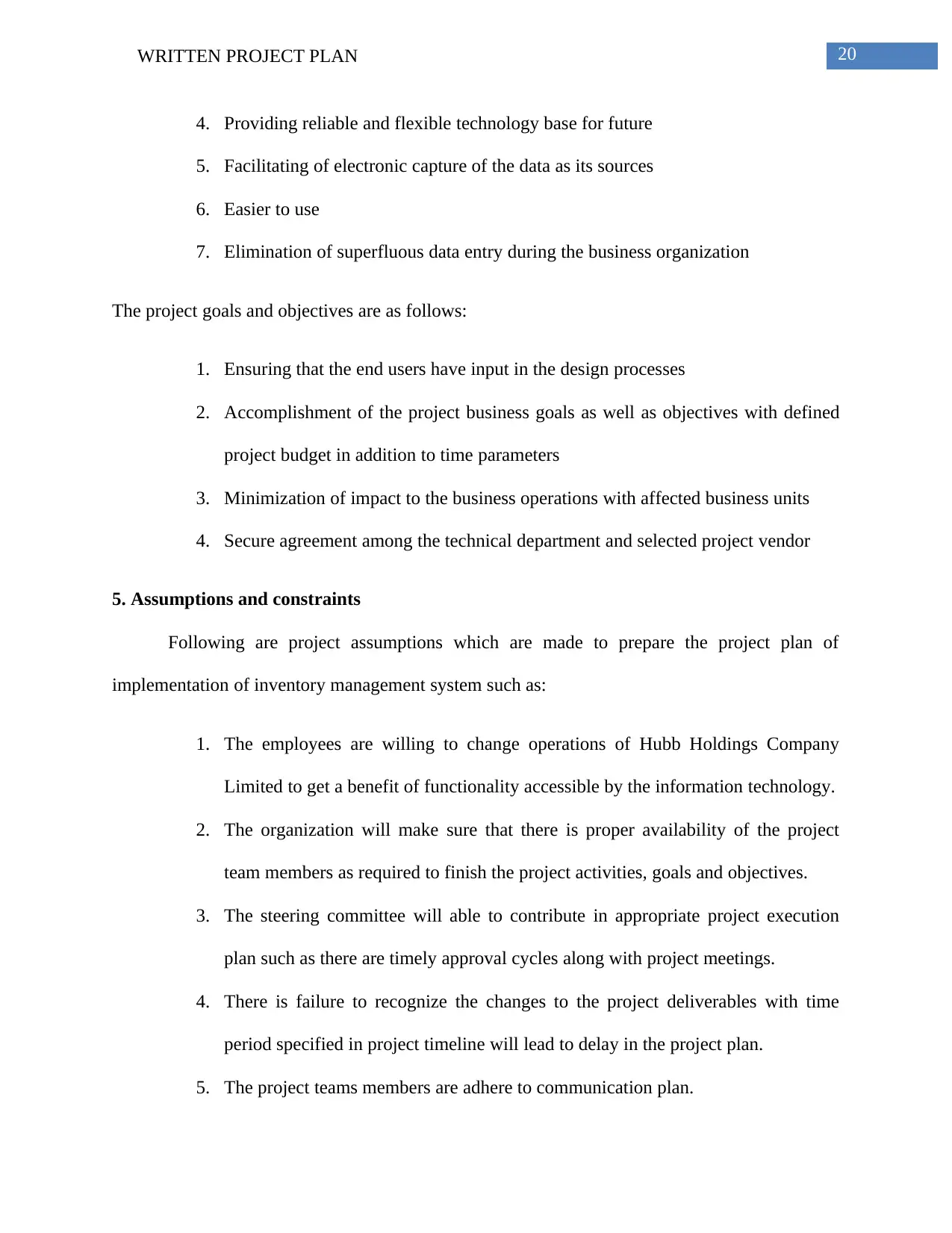
20WRITTEN PROJECT PLAN
4. Providing reliable and flexible technology base for future
5. Facilitating of electronic capture of the data as its sources
6. Easier to use
7. Elimination of superfluous data entry during the business organization
The project goals and objectives are as follows:
1. Ensuring that the end users have input in the design processes
2. Accomplishment of the project business goals as well as objectives with defined
project budget in addition to time parameters
3. Minimization of impact to the business operations with affected business units
4. Secure agreement among the technical department and selected project vendor
5. Assumptions and constraints
Following are project assumptions which are made to prepare the project plan of
implementation of inventory management system such as:
1. The employees are willing to change operations of Hubb Holdings Company
Limited to get a benefit of functionality accessible by the information technology.
2. The organization will make sure that there is proper availability of the project
team members as required to finish the project activities, goals and objectives.
3. The steering committee will able to contribute in appropriate project execution
plan such as there are timely approval cycles along with project meetings.
4. There is failure to recognize the changes to the project deliverables with time
period specified in project timeline will lead to delay in the project plan.
5. The project teams members are adhere to communication plan.
4. Providing reliable and flexible technology base for future
5. Facilitating of electronic capture of the data as its sources
6. Easier to use
7. Elimination of superfluous data entry during the business organization
The project goals and objectives are as follows:
1. Ensuring that the end users have input in the design processes
2. Accomplishment of the project business goals as well as objectives with defined
project budget in addition to time parameters
3. Minimization of impact to the business operations with affected business units
4. Secure agreement among the technical department and selected project vendor
5. Assumptions and constraints
Following are project assumptions which are made to prepare the project plan of
implementation of inventory management system such as:
1. The employees are willing to change operations of Hubb Holdings Company
Limited to get a benefit of functionality accessible by the information technology.
2. The organization will make sure that there is proper availability of the project
team members as required to finish the project activities, goals and objectives.
3. The steering committee will able to contribute in appropriate project execution
plan such as there are timely approval cycles along with project meetings.
4. There is failure to recognize the changes to the project deliverables with time
period specified in project timeline will lead to delay in the project plan.
5. The project teams members are adhere to communication plan.
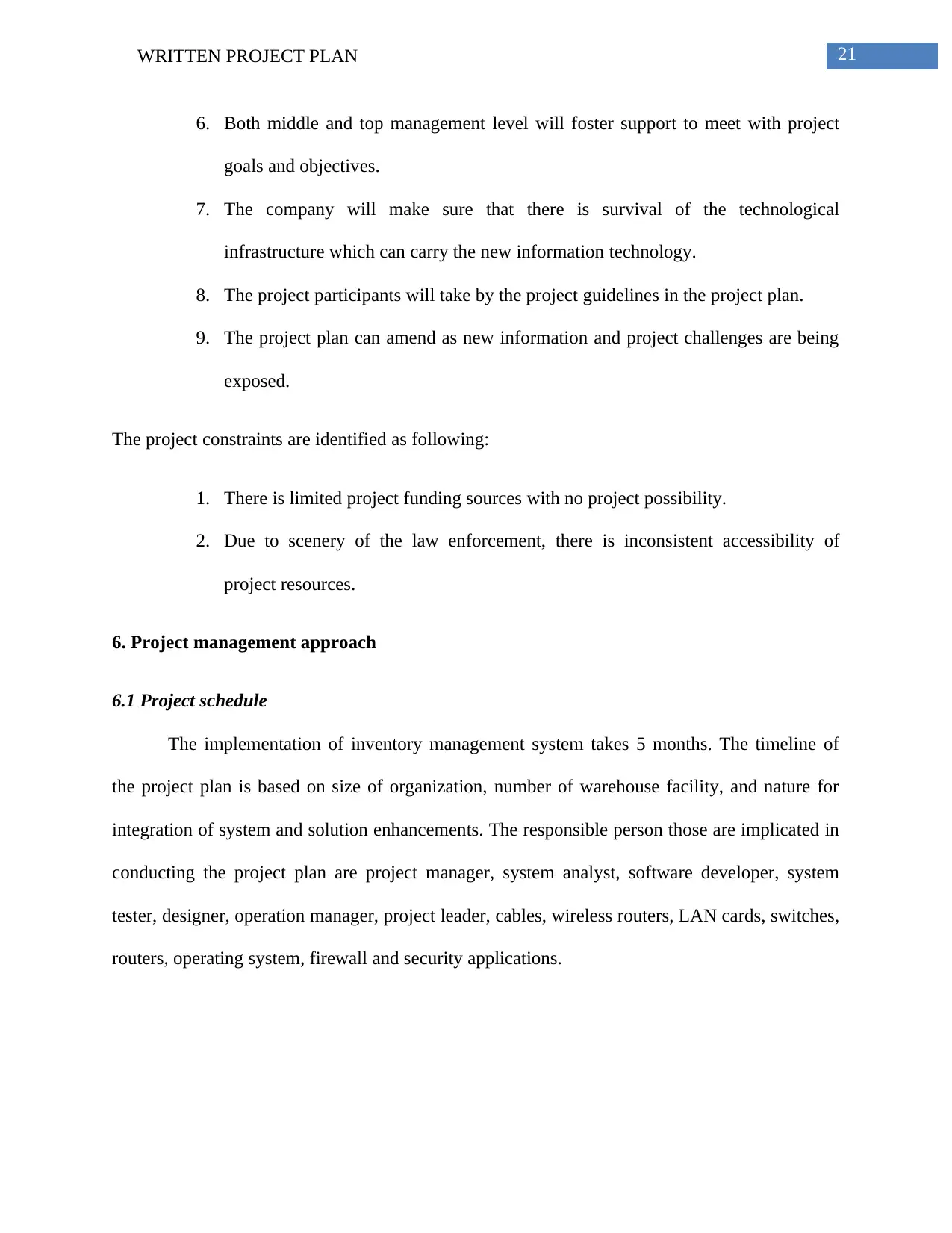
21WRITTEN PROJECT PLAN
6. Both middle and top management level will foster support to meet with project
goals and objectives.
7. The company will make sure that there is survival of the technological
infrastructure which can carry the new information technology.
8. The project participants will take by the project guidelines in the project plan.
9. The project plan can amend as new information and project challenges are being
exposed.
The project constraints are identified as following:
1. There is limited project funding sources with no project possibility.
2. Due to scenery of the law enforcement, there is inconsistent accessibility of
project resources.
6. Project management approach
6.1 Project schedule
The implementation of inventory management system takes 5 months. The timeline of
the project plan is based on size of organization, number of warehouse facility, and nature for
integration of system and solution enhancements. The responsible person those are implicated in
conducting the project plan are project manager, system analyst, software developer, system
tester, designer, operation manager, project leader, cables, wireless routers, LAN cards, switches,
routers, operating system, firewall and security applications.
6. Both middle and top management level will foster support to meet with project
goals and objectives.
7. The company will make sure that there is survival of the technological
infrastructure which can carry the new information technology.
8. The project participants will take by the project guidelines in the project plan.
9. The project plan can amend as new information and project challenges are being
exposed.
The project constraints are identified as following:
1. There is limited project funding sources with no project possibility.
2. Due to scenery of the law enforcement, there is inconsistent accessibility of
project resources.
6. Project management approach
6.1 Project schedule
The implementation of inventory management system takes 5 months. The timeline of
the project plan is based on size of organization, number of warehouse facility, and nature for
integration of system and solution enhancements. The responsible person those are implicated in
conducting the project plan are project manager, system analyst, software developer, system
tester, designer, operation manager, project leader, cables, wireless routers, LAN cards, switches,
routers, operating system, firewall and security applications.
Secure Best Marks with AI Grader
Need help grading? Try our AI Grader for instant feedback on your assignments.
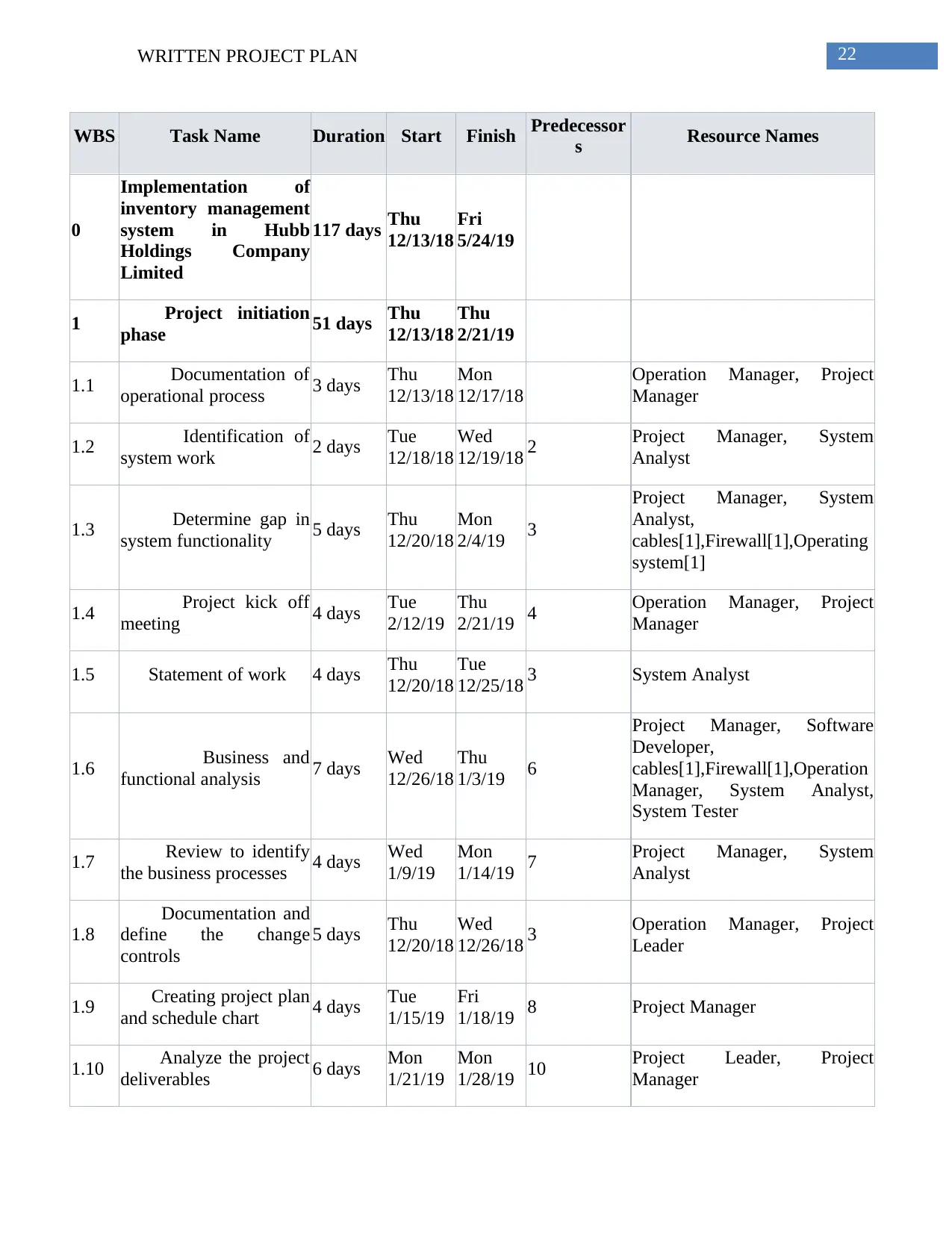
22WRITTEN PROJECT PLAN
WBS Task Name Duration Start Finish Predecessor
s Resource Names
0
Implementation of
inventory management
system in Hubb
Holdings Company
Limited
117 days Thu
12/13/18
Fri
5/24/19
1 Project initiation
phase 51 days Thu
12/13/18
Thu
2/21/19
1.1 Documentation of
operational process 3 days Thu
12/13/18
Mon
12/17/18
Operation Manager, Project
Manager
1.2 Identification of
system work 2 days Tue
12/18/18
Wed
12/19/18 2 Project Manager, System
Analyst
1.3 Determine gap in
system functionality 5 days Thu
12/20/18
Mon
2/4/19 3
Project Manager, System
Analyst,
cables[1],Firewall[1],Operating
system[1]
1.4 Project kick off
meeting 4 days Tue
2/12/19
Thu
2/21/19 4 Operation Manager, Project
Manager
1.5 Statement of work 4 days Thu
12/20/18
Tue
12/25/18 3 System Analyst
1.6 Business and
functional analysis 7 days Wed
12/26/18
Thu
1/3/19 6
Project Manager, Software
Developer,
cables[1],Firewall[1],Operation
Manager, System Analyst,
System Tester
1.7 Review to identify
the business processes 4 days Wed
1/9/19
Mon
1/14/19 7 Project Manager, System
Analyst
1.8
Documentation and
define the change
controls
5 days Thu
12/20/18
Wed
12/26/18 3 Operation Manager, Project
Leader
1.9 Creating project plan
and schedule chart 4 days Tue
1/15/19
Fri
1/18/19 8 Project Manager
1.10 Analyze the project
deliverables 6 days Mon
1/21/19
Mon
1/28/19 10 Project Leader, Project
Manager
WBS Task Name Duration Start Finish Predecessor
s Resource Names
0
Implementation of
inventory management
system in Hubb
Holdings Company
Limited
117 days Thu
12/13/18
Fri
5/24/19
1 Project initiation
phase 51 days Thu
12/13/18
Thu
2/21/19
1.1 Documentation of
operational process 3 days Thu
12/13/18
Mon
12/17/18
Operation Manager, Project
Manager
1.2 Identification of
system work 2 days Tue
12/18/18
Wed
12/19/18 2 Project Manager, System
Analyst
1.3 Determine gap in
system functionality 5 days Thu
12/20/18
Mon
2/4/19 3
Project Manager, System
Analyst,
cables[1],Firewall[1],Operating
system[1]
1.4 Project kick off
meeting 4 days Tue
2/12/19
Thu
2/21/19 4 Operation Manager, Project
Manager
1.5 Statement of work 4 days Thu
12/20/18
Tue
12/25/18 3 System Analyst
1.6 Business and
functional analysis 7 days Wed
12/26/18
Thu
1/3/19 6
Project Manager, Software
Developer,
cables[1],Firewall[1],Operation
Manager, System Analyst,
System Tester
1.7 Review to identify
the business processes 4 days Wed
1/9/19
Mon
1/14/19 7 Project Manager, System
Analyst
1.8
Documentation and
define the change
controls
5 days Thu
12/20/18
Wed
12/26/18 3 Operation Manager, Project
Leader
1.9 Creating project plan
and schedule chart 4 days Tue
1/15/19
Fri
1/18/19 8 Project Manager
1.10 Analyze the project
deliverables 6 days Mon
1/21/19
Mon
1/28/19 10 Project Leader, Project
Manager
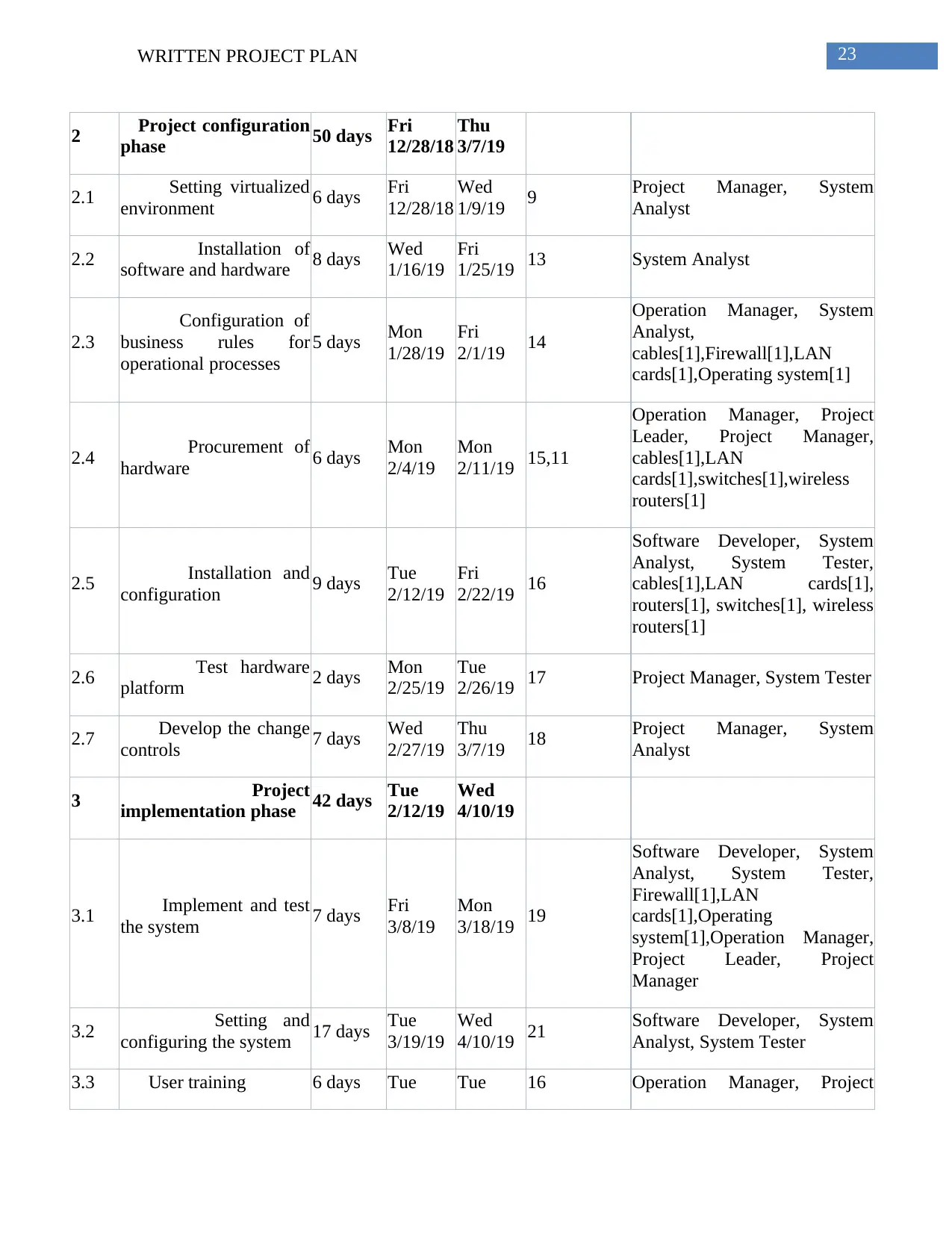
23WRITTEN PROJECT PLAN
2 Project configuration
phase 50 days Fri
12/28/18
Thu
3/7/19
2.1 Setting virtualized
environment 6 days Fri
12/28/18
Wed
1/9/19 9 Project Manager, System
Analyst
2.2 Installation of
software and hardware 8 days Wed
1/16/19
Fri
1/25/19 13 System Analyst
2.3
Configuration of
business rules for
operational processes
5 days Mon
1/28/19
Fri
2/1/19 14
Operation Manager, System
Analyst,
cables[1],Firewall[1],LAN
cards[1],Operating system[1]
2.4 Procurement of
hardware 6 days Mon
2/4/19
Mon
2/11/19 15,11
Operation Manager, Project
Leader, Project Manager,
cables[1],LAN
cards[1],switches[1],wireless
routers[1]
2.5 Installation and
configuration 9 days Tue
2/12/19
Fri
2/22/19 16
Software Developer, System
Analyst, System Tester,
cables[1],LAN cards[1],
routers[1], switches[1], wireless
routers[1]
2.6 Test hardware
platform 2 days Mon
2/25/19
Tue
2/26/19 17 Project Manager, System Tester
2.7 Develop the change
controls 7 days Wed
2/27/19
Thu
3/7/19 18 Project Manager, System
Analyst
3 Project
implementation phase 42 days Tue
2/12/19
Wed
4/10/19
3.1 Implement and test
the system 7 days Fri
3/8/19
Mon
3/18/19 19
Software Developer, System
Analyst, System Tester,
Firewall[1],LAN
cards[1],Operating
system[1],Operation Manager,
Project Leader, Project
Manager
3.2 Setting and
configuring the system 17 days Tue
3/19/19
Wed
4/10/19 21 Software Developer, System
Analyst, System Tester
3.3 User training 6 days Tue Tue 16 Operation Manager, Project
2 Project configuration
phase 50 days Fri
12/28/18
Thu
3/7/19
2.1 Setting virtualized
environment 6 days Fri
12/28/18
Wed
1/9/19 9 Project Manager, System
Analyst
2.2 Installation of
software and hardware 8 days Wed
1/16/19
Fri
1/25/19 13 System Analyst
2.3
Configuration of
business rules for
operational processes
5 days Mon
1/28/19
Fri
2/1/19 14
Operation Manager, System
Analyst,
cables[1],Firewall[1],LAN
cards[1],Operating system[1]
2.4 Procurement of
hardware 6 days Mon
2/4/19
Mon
2/11/19 15,11
Operation Manager, Project
Leader, Project Manager,
cables[1],LAN
cards[1],switches[1],wireless
routers[1]
2.5 Installation and
configuration 9 days Tue
2/12/19
Fri
2/22/19 16
Software Developer, System
Analyst, System Tester,
cables[1],LAN cards[1],
routers[1], switches[1], wireless
routers[1]
2.6 Test hardware
platform 2 days Mon
2/25/19
Tue
2/26/19 17 Project Manager, System Tester
2.7 Develop the change
controls 7 days Wed
2/27/19
Thu
3/7/19 18 Project Manager, System
Analyst
3 Project
implementation phase 42 days Tue
2/12/19
Wed
4/10/19
3.1 Implement and test
the system 7 days Fri
3/8/19
Mon
3/18/19 19
Software Developer, System
Analyst, System Tester,
Firewall[1],LAN
cards[1],Operating
system[1],Operation Manager,
Project Leader, Project
Manager
3.2 Setting and
configuring the system 17 days Tue
3/19/19
Wed
4/10/19 21 Software Developer, System
Analyst, System Tester
3.3 User training 6 days Tue Tue 16 Operation Manager, Project
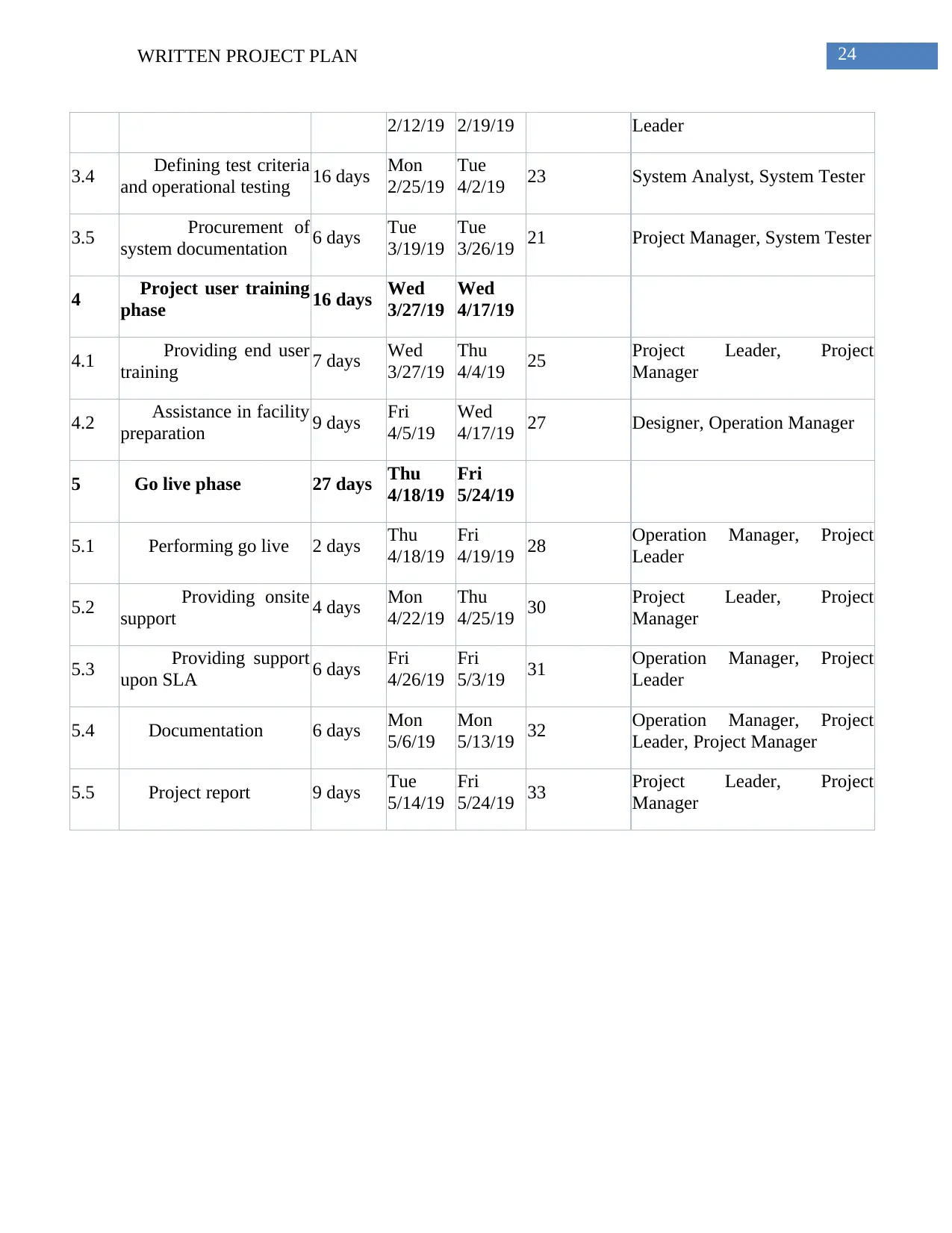
24WRITTEN PROJECT PLAN
2/12/19 2/19/19 Leader
3.4 Defining test criteria
and operational testing 16 days Mon
2/25/19
Tue
4/2/19 23 System Analyst, System Tester
3.5 Procurement of
system documentation 6 days Tue
3/19/19
Tue
3/26/19 21 Project Manager, System Tester
4 Project user training
phase 16 days Wed
3/27/19
Wed
4/17/19
4.1 Providing end user
training 7 days Wed
3/27/19
Thu
4/4/19 25 Project Leader, Project
Manager
4.2 Assistance in facility
preparation 9 days Fri
4/5/19
Wed
4/17/19 27 Designer, Operation Manager
5 Go live phase 27 days Thu
4/18/19
Fri
5/24/19
5.1 Performing go live 2 days Thu
4/18/19
Fri
4/19/19 28 Operation Manager, Project
Leader
5.2 Providing onsite
support 4 days Mon
4/22/19
Thu
4/25/19 30 Project Leader, Project
Manager
5.3 Providing support
upon SLA 6 days Fri
4/26/19
Fri
5/3/19 31 Operation Manager, Project
Leader
5.4 Documentation 6 days Mon
5/6/19
Mon
5/13/19 32 Operation Manager, Project
Leader, Project Manager
5.5 Project report 9 days Tue
5/14/19
Fri
5/24/19 33 Project Leader, Project
Manager
2/12/19 2/19/19 Leader
3.4 Defining test criteria
and operational testing 16 days Mon
2/25/19
Tue
4/2/19 23 System Analyst, System Tester
3.5 Procurement of
system documentation 6 days Tue
3/19/19
Tue
3/26/19 21 Project Manager, System Tester
4 Project user training
phase 16 days Wed
3/27/19
Wed
4/17/19
4.1 Providing end user
training 7 days Wed
3/27/19
Thu
4/4/19 25 Project Leader, Project
Manager
4.2 Assistance in facility
preparation 9 days Fri
4/5/19
Wed
4/17/19 27 Designer, Operation Manager
5 Go live phase 27 days Thu
4/18/19
Fri
5/24/19
5.1 Performing go live 2 days Thu
4/18/19
Fri
4/19/19 28 Operation Manager, Project
Leader
5.2 Providing onsite
support 4 days Mon
4/22/19
Thu
4/25/19 30 Project Leader, Project
Manager
5.3 Providing support
upon SLA 6 days Fri
4/26/19
Fri
5/3/19 31 Operation Manager, Project
Leader
5.4 Documentation 6 days Mon
5/6/19
Mon
5/13/19 32 Operation Manager, Project
Leader, Project Manager
5.5 Project report 9 days Tue
5/14/19
Fri
5/24/19 33 Project Leader, Project
Manager
Paraphrase This Document
Need a fresh take? Get an instant paraphrase of this document with our AI Paraphraser
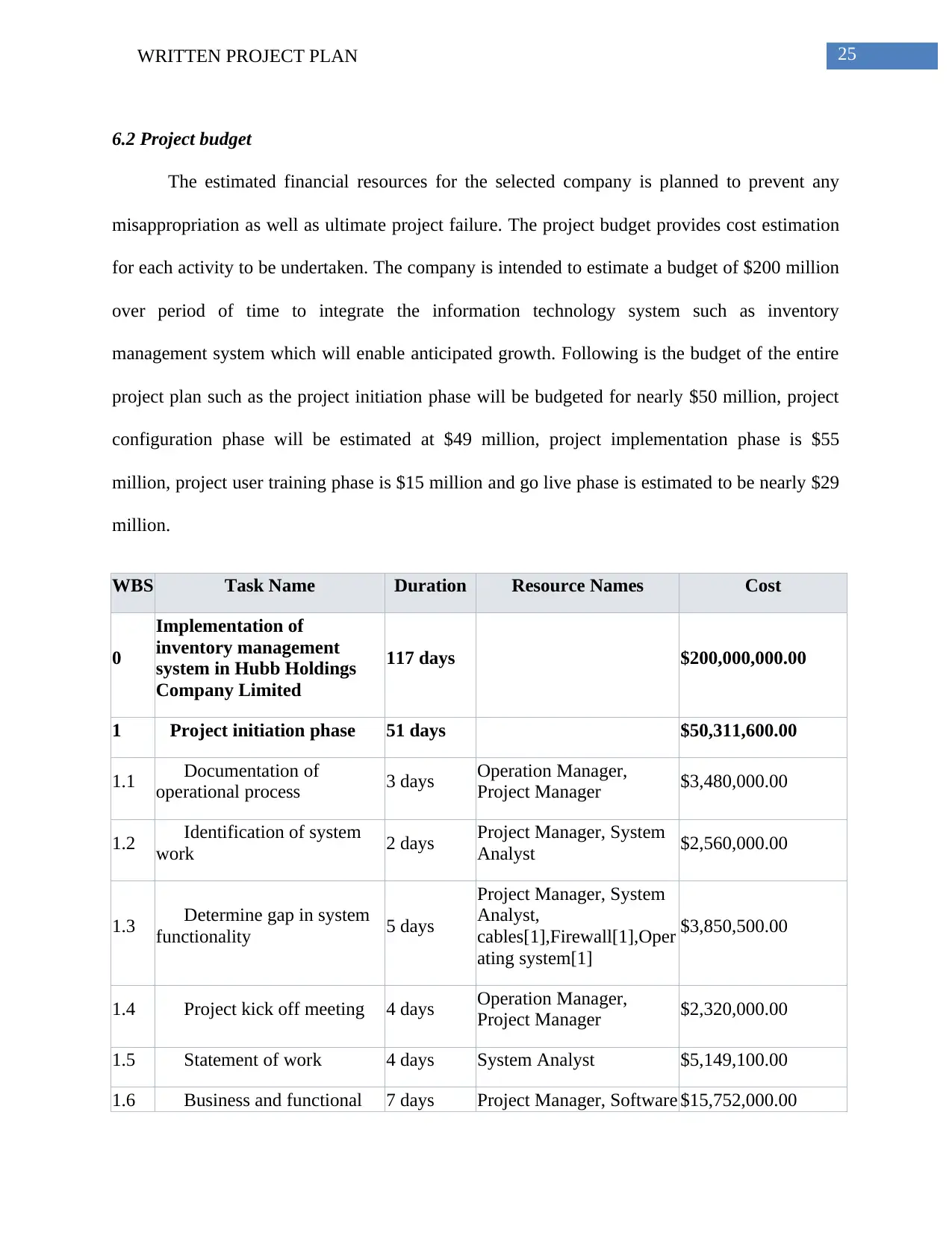
25WRITTEN PROJECT PLAN
6.2 Project budget
The estimated financial resources for the selected company is planned to prevent any
misappropriation as well as ultimate project failure. The project budget provides cost estimation
for each activity to be undertaken. The company is intended to estimate a budget of $200 million
over period of time to integrate the information technology system such as inventory
management system which will enable anticipated growth. Following is the budget of the entire
project plan such as the project initiation phase will be budgeted for nearly $50 million, project
configuration phase will be estimated at $49 million, project implementation phase is $55
million, project user training phase is $15 million and go live phase is estimated to be nearly $29
million.
WBS Task Name Duration Resource Names Cost
0
Implementation of
inventory management
system in Hubb Holdings
Company Limited
117 days $200,000,000.00
1 Project initiation phase 51 days $50,311,600.00
1.1 Documentation of
operational process 3 days Operation Manager,
Project Manager $3,480,000.00
1.2 Identification of system
work 2 days Project Manager, System
Analyst $2,560,000.00
1.3 Determine gap in system
functionality 5 days
Project Manager, System
Analyst,
cables[1],Firewall[1],Oper
ating system[1]
$3,850,500.00
1.4 Project kick off meeting 4 days Operation Manager,
Project Manager $2,320,000.00
1.5 Statement of work 4 days System Analyst $5,149,100.00
1.6 Business and functional 7 days Project Manager, Software $15,752,000.00
6.2 Project budget
The estimated financial resources for the selected company is planned to prevent any
misappropriation as well as ultimate project failure. The project budget provides cost estimation
for each activity to be undertaken. The company is intended to estimate a budget of $200 million
over period of time to integrate the information technology system such as inventory
management system which will enable anticipated growth. Following is the budget of the entire
project plan such as the project initiation phase will be budgeted for nearly $50 million, project
configuration phase will be estimated at $49 million, project implementation phase is $55
million, project user training phase is $15 million and go live phase is estimated to be nearly $29
million.
WBS Task Name Duration Resource Names Cost
0
Implementation of
inventory management
system in Hubb Holdings
Company Limited
117 days $200,000,000.00
1 Project initiation phase 51 days $50,311,600.00
1.1 Documentation of
operational process 3 days Operation Manager,
Project Manager $3,480,000.00
1.2 Identification of system
work 2 days Project Manager, System
Analyst $2,560,000.00
1.3 Determine gap in system
functionality 5 days
Project Manager, System
Analyst,
cables[1],Firewall[1],Oper
ating system[1]
$3,850,500.00
1.4 Project kick off meeting 4 days Operation Manager,
Project Manager $2,320,000.00
1.5 Statement of work 4 days System Analyst $5,149,100.00
1.6 Business and functional 7 days Project Manager, Software $15,752,000.00
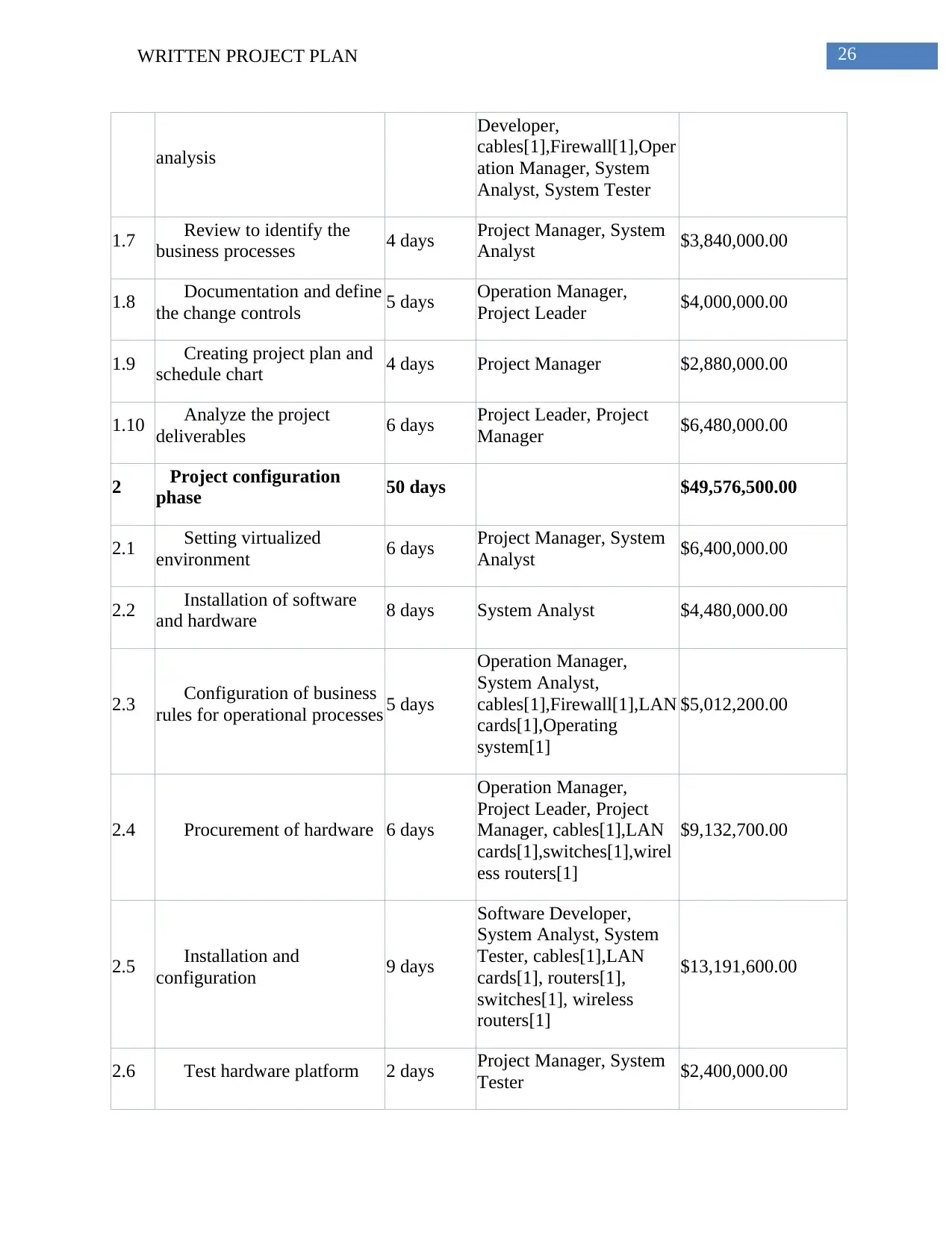
26WRITTEN PROJECT PLAN
analysis
Developer,
cables[1],Firewall[1],Oper
ation Manager, System
Analyst, System Tester
1.7 Review to identify the
business processes 4 days Project Manager, System
Analyst $3,840,000.00
1.8 Documentation and define
the change controls 5 days Operation Manager,
Project Leader $4,000,000.00
1.9 Creating project plan and
schedule chart 4 days Project Manager $2,880,000.00
1.10 Analyze the project
deliverables 6 days Project Leader, Project
Manager $6,480,000.00
2 Project configuration
phase 50 days $49,576,500.00
2.1 Setting virtualized
environment 6 days Project Manager, System
Analyst $6,400,000.00
2.2 Installation of software
and hardware 8 days System Analyst $4,480,000.00
2.3 Configuration of business
rules for operational processes 5 days
Operation Manager,
System Analyst,
cables[1],Firewall[1],LAN
cards[1],Operating
system[1]
$5,012,200.00
2.4 Procurement of hardware 6 days
Operation Manager,
Project Leader, Project
Manager, cables[1],LAN
cards[1],switches[1],wirel
ess routers[1]
$9,132,700.00
2.5 Installation and
configuration 9 days
Software Developer,
System Analyst, System
Tester, cables[1],LAN
cards[1], routers[1],
switches[1], wireless
routers[1]
$13,191,600.00
2.6 Test hardware platform 2 days Project Manager, System
Tester $2,400,000.00
analysis
Developer,
cables[1],Firewall[1],Oper
ation Manager, System
Analyst, System Tester
1.7 Review to identify the
business processes 4 days Project Manager, System
Analyst $3,840,000.00
1.8 Documentation and define
the change controls 5 days Operation Manager,
Project Leader $4,000,000.00
1.9 Creating project plan and
schedule chart 4 days Project Manager $2,880,000.00
1.10 Analyze the project
deliverables 6 days Project Leader, Project
Manager $6,480,000.00
2 Project configuration
phase 50 days $49,576,500.00
2.1 Setting virtualized
environment 6 days Project Manager, System
Analyst $6,400,000.00
2.2 Installation of software
and hardware 8 days System Analyst $4,480,000.00
2.3 Configuration of business
rules for operational processes 5 days
Operation Manager,
System Analyst,
cables[1],Firewall[1],LAN
cards[1],Operating
system[1]
$5,012,200.00
2.4 Procurement of hardware 6 days
Operation Manager,
Project Leader, Project
Manager, cables[1],LAN
cards[1],switches[1],wirel
ess routers[1]
$9,132,700.00
2.5 Installation and
configuration 9 days
Software Developer,
System Analyst, System
Tester, cables[1],LAN
cards[1], routers[1],
switches[1], wireless
routers[1]
$13,191,600.00
2.6 Test hardware platform 2 days Project Manager, System
Tester $2,400,000.00
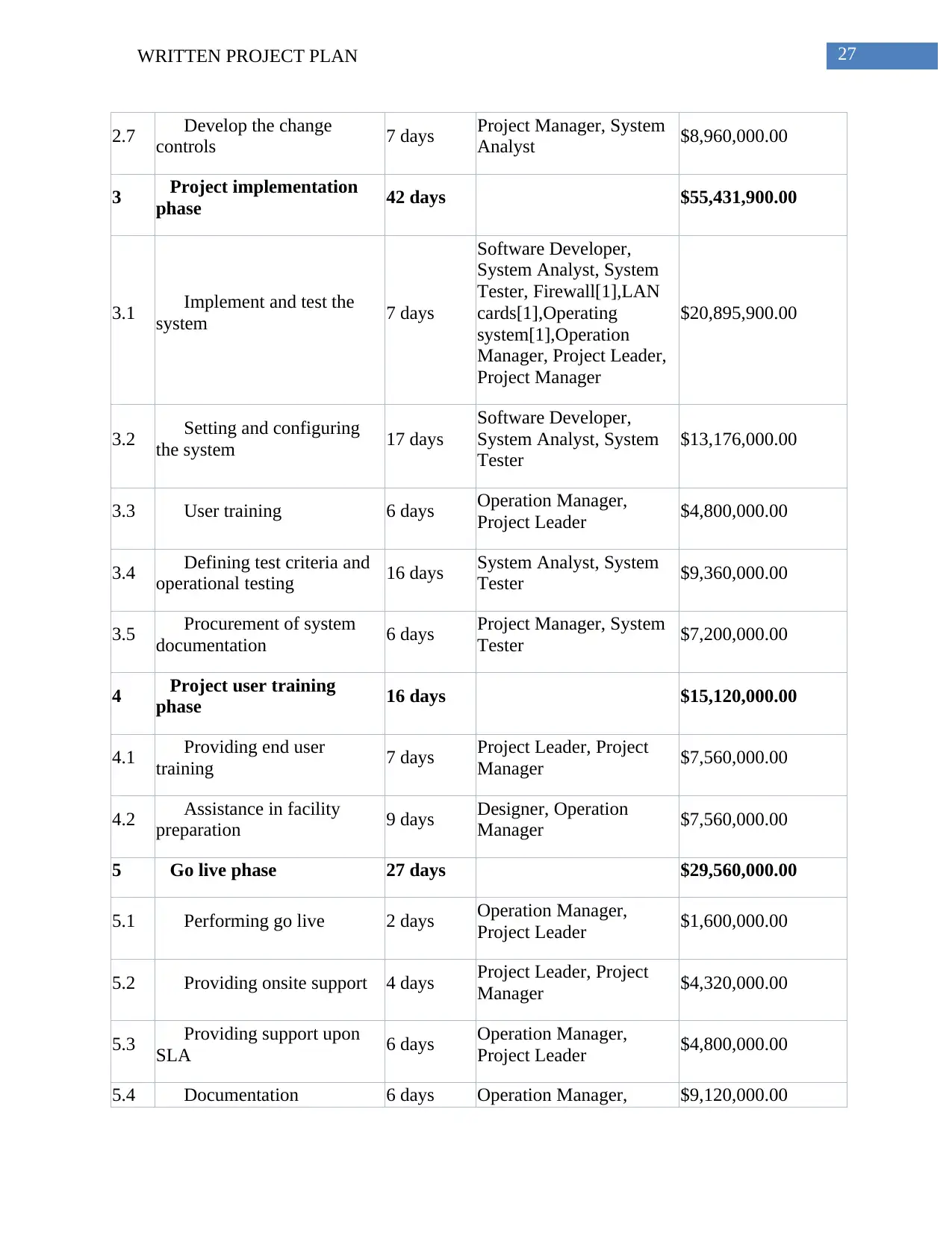
27WRITTEN PROJECT PLAN
2.7 Develop the change
controls 7 days Project Manager, System
Analyst $8,960,000.00
3 Project implementation
phase 42 days $55,431,900.00
3.1 Implement and test the
system 7 days
Software Developer,
System Analyst, System
Tester, Firewall[1],LAN
cards[1],Operating
system[1],Operation
Manager, Project Leader,
Project Manager
$20,895,900.00
3.2 Setting and configuring
the system 17 days
Software Developer,
System Analyst, System
Tester
$13,176,000.00
3.3 User training 6 days Operation Manager,
Project Leader $4,800,000.00
3.4 Defining test criteria and
operational testing 16 days System Analyst, System
Tester $9,360,000.00
3.5 Procurement of system
documentation 6 days Project Manager, System
Tester $7,200,000.00
4 Project user training
phase 16 days $15,120,000.00
4.1 Providing end user
training 7 days Project Leader, Project
Manager $7,560,000.00
4.2 Assistance in facility
preparation 9 days Designer, Operation
Manager $7,560,000.00
5 Go live phase 27 days $29,560,000.00
5.1 Performing go live 2 days Operation Manager,
Project Leader $1,600,000.00
5.2 Providing onsite support 4 days Project Leader, Project
Manager $4,320,000.00
5.3 Providing support upon
SLA 6 days Operation Manager,
Project Leader $4,800,000.00
5.4 Documentation 6 days Operation Manager, $9,120,000.00
2.7 Develop the change
controls 7 days Project Manager, System
Analyst $8,960,000.00
3 Project implementation
phase 42 days $55,431,900.00
3.1 Implement and test the
system 7 days
Software Developer,
System Analyst, System
Tester, Firewall[1],LAN
cards[1],Operating
system[1],Operation
Manager, Project Leader,
Project Manager
$20,895,900.00
3.2 Setting and configuring
the system 17 days
Software Developer,
System Analyst, System
Tester
$13,176,000.00
3.3 User training 6 days Operation Manager,
Project Leader $4,800,000.00
3.4 Defining test criteria and
operational testing 16 days System Analyst, System
Tester $9,360,000.00
3.5 Procurement of system
documentation 6 days Project Manager, System
Tester $7,200,000.00
4 Project user training
phase 16 days $15,120,000.00
4.1 Providing end user
training 7 days Project Leader, Project
Manager $7,560,000.00
4.2 Assistance in facility
preparation 9 days Designer, Operation
Manager $7,560,000.00
5 Go live phase 27 days $29,560,000.00
5.1 Performing go live 2 days Operation Manager,
Project Leader $1,600,000.00
5.2 Providing onsite support 4 days Project Leader, Project
Manager $4,320,000.00
5.3 Providing support upon
SLA 6 days Operation Manager,
Project Leader $4,800,000.00
5.4 Documentation 6 days Operation Manager, $9,120,000.00
Secure Best Marks with AI Grader
Need help grading? Try our AI Grader for instant feedback on your assignments.
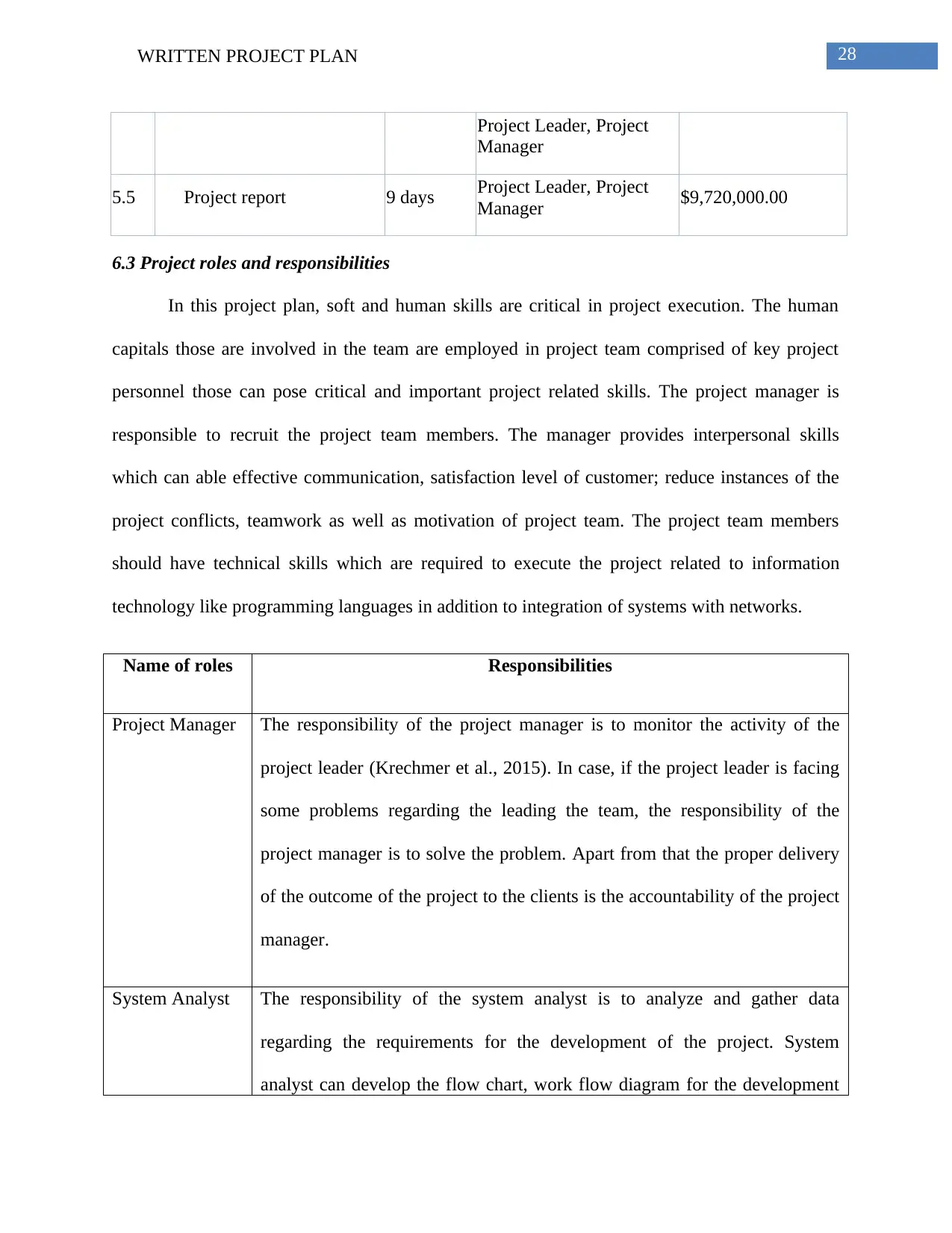
28WRITTEN PROJECT PLAN
Project Leader, Project
Manager
5.5 Project report 9 days Project Leader, Project
Manager $9,720,000.00
6.3 Project roles and responsibilities
In this project plan, soft and human skills are critical in project execution. The human
capitals those are involved in the team are employed in project team comprised of key project
personnel those can pose critical and important project related skills. The project manager is
responsible to recruit the project team members. The manager provides interpersonal skills
which can able effective communication, satisfaction level of customer; reduce instances of the
project conflicts, teamwork as well as motivation of project team. The project team members
should have technical skills which are required to execute the project related to information
technology like programming languages in addition to integration of systems with networks.
Name of roles Responsibilities
Project Manager The responsibility of the project manager is to monitor the activity of the
project leader (Krechmer et al., 2015). In case, if the project leader is facing
some problems regarding the leading the team, the responsibility of the
project manager is to solve the problem. Apart from that the proper delivery
of the outcome of the project to the clients is the accountability of the project
manager.
System Analyst The responsibility of the system analyst is to analyze and gather data
regarding the requirements for the development of the project. System
analyst can develop the flow chart, work flow diagram for the development
Project Leader, Project
Manager
5.5 Project report 9 days Project Leader, Project
Manager $9,720,000.00
6.3 Project roles and responsibilities
In this project plan, soft and human skills are critical in project execution. The human
capitals those are involved in the team are employed in project team comprised of key project
personnel those can pose critical and important project related skills. The project manager is
responsible to recruit the project team members. The manager provides interpersonal skills
which can able effective communication, satisfaction level of customer; reduce instances of the
project conflicts, teamwork as well as motivation of project team. The project team members
should have technical skills which are required to execute the project related to information
technology like programming languages in addition to integration of systems with networks.
Name of roles Responsibilities
Project Manager The responsibility of the project manager is to monitor the activity of the
project leader (Krechmer et al., 2015). In case, if the project leader is facing
some problems regarding the leading the team, the responsibility of the
project manager is to solve the problem. Apart from that the proper delivery
of the outcome of the project to the clients is the accountability of the project
manager.
System Analyst The responsibility of the system analyst is to analyze and gather data
regarding the requirements for the development of the project. System
analyst can develop the flow chart, work flow diagram for the development
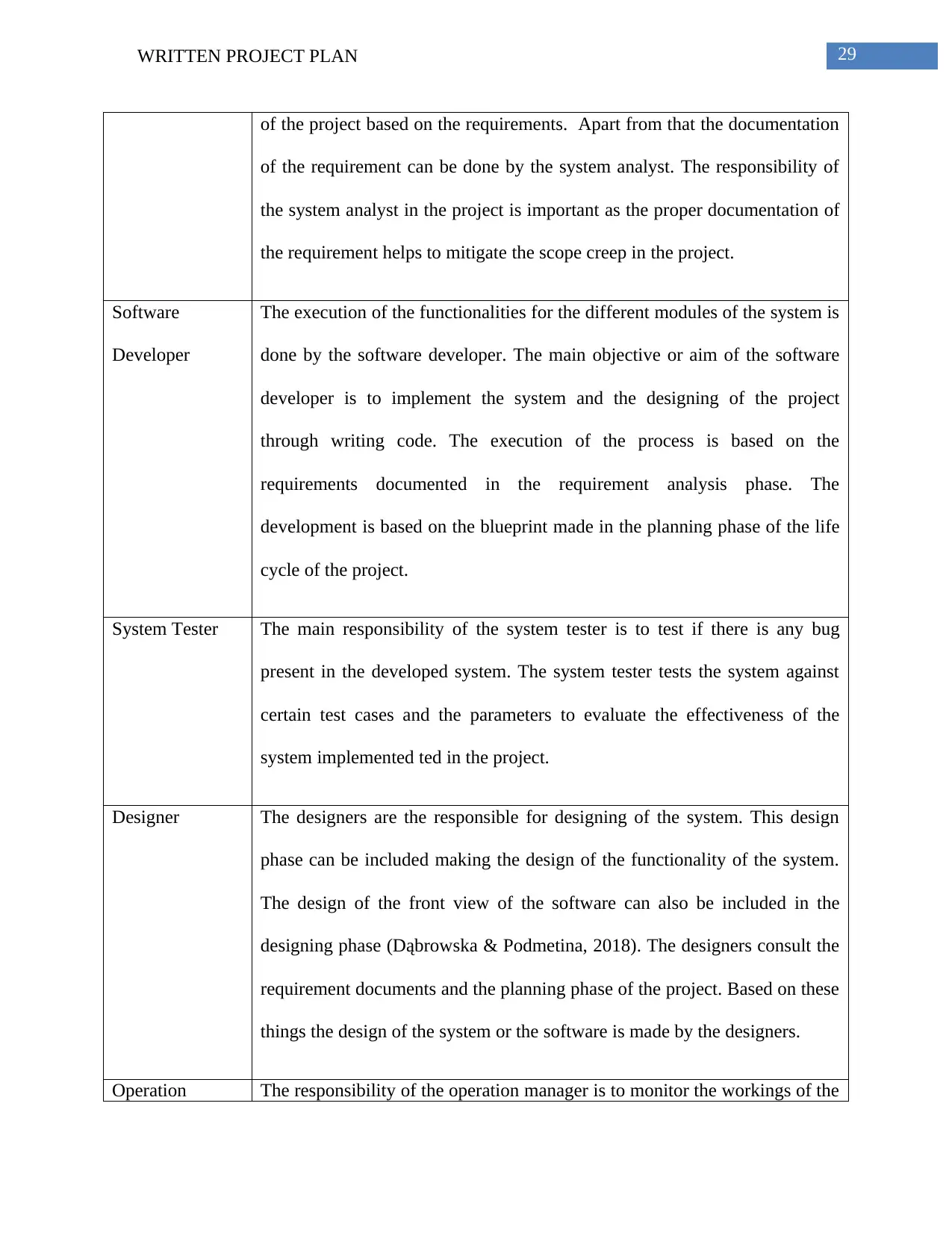
29WRITTEN PROJECT PLAN
of the project based on the requirements. Apart from that the documentation
of the requirement can be done by the system analyst. The responsibility of
the system analyst in the project is important as the proper documentation of
the requirement helps to mitigate the scope creep in the project.
Software
Developer
The execution of the functionalities for the different modules of the system is
done by the software developer. The main objective or aim of the software
developer is to implement the system and the designing of the project
through writing code. The execution of the process is based on the
requirements documented in the requirement analysis phase. The
development is based on the blueprint made in the planning phase of the life
cycle of the project.
System Tester The main responsibility of the system tester is to test if there is any bug
present in the developed system. The system tester tests the system against
certain test cases and the parameters to evaluate the effectiveness of the
system implemented ted in the project.
Designer The designers are the responsible for designing of the system. This design
phase can be included making the design of the functionality of the system.
The design of the front view of the software can also be included in the
designing phase (Dąbrowska & Podmetina, 2018). The designers consult the
requirement documents and the planning phase of the project. Based on these
things the design of the system or the software is made by the designers.
Operation The responsibility of the operation manager is to monitor the workings of the
of the project based on the requirements. Apart from that the documentation
of the requirement can be done by the system analyst. The responsibility of
the system analyst in the project is important as the proper documentation of
the requirement helps to mitigate the scope creep in the project.
Software
Developer
The execution of the functionalities for the different modules of the system is
done by the software developer. The main objective or aim of the software
developer is to implement the system and the designing of the project
through writing code. The execution of the process is based on the
requirements documented in the requirement analysis phase. The
development is based on the blueprint made in the planning phase of the life
cycle of the project.
System Tester The main responsibility of the system tester is to test if there is any bug
present in the developed system. The system tester tests the system against
certain test cases and the parameters to evaluate the effectiveness of the
system implemented ted in the project.
Designer The designers are the responsible for designing of the system. This design
phase can be included making the design of the functionality of the system.
The design of the front view of the software can also be included in the
designing phase (Dąbrowska & Podmetina, 2018). The designers consult the
requirement documents and the planning phase of the project. Based on these
things the design of the system or the software is made by the designers.
Operation The responsibility of the operation manager is to monitor the workings of the
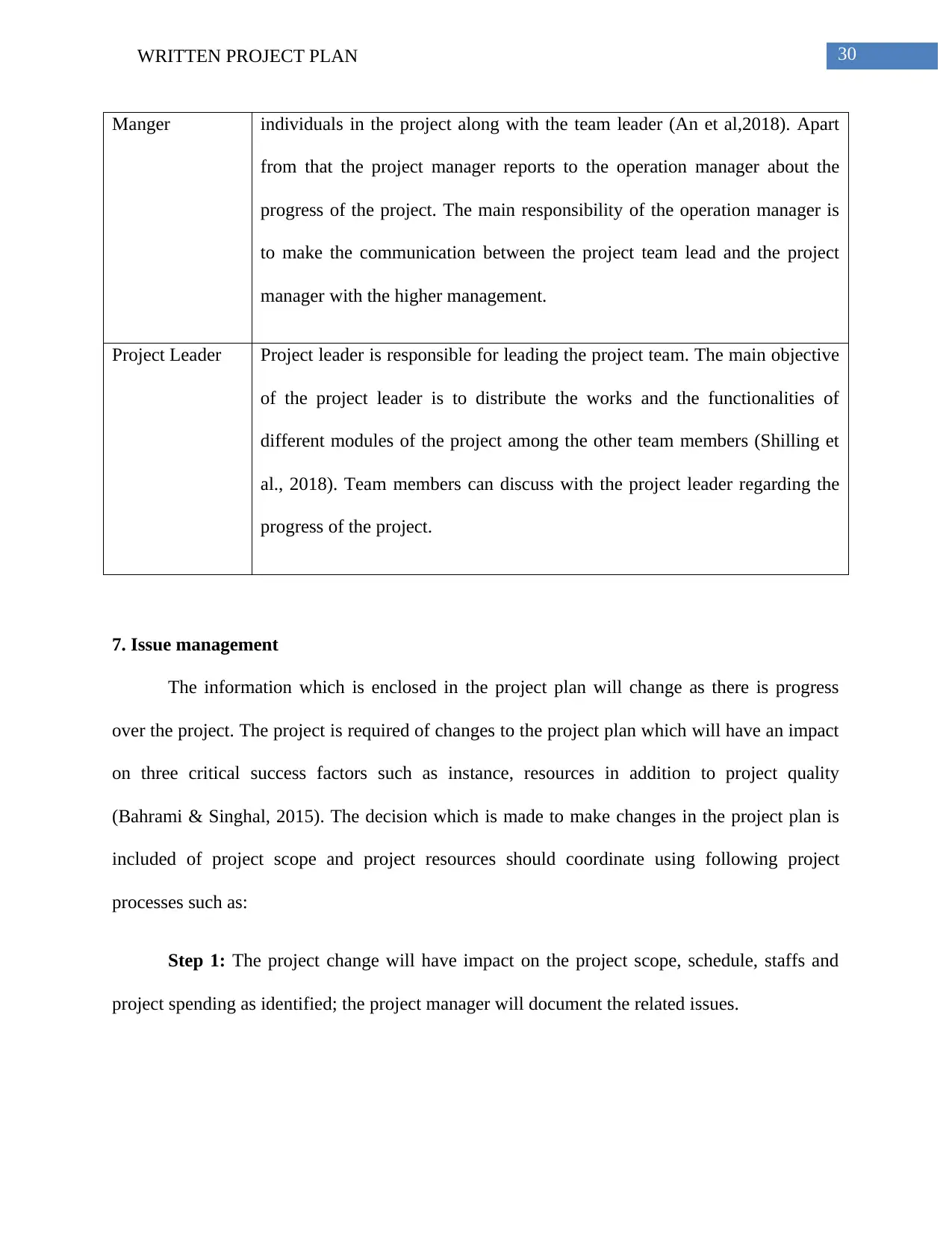
30WRITTEN PROJECT PLAN
Manger individuals in the project along with the team leader (An et al,2018). Apart
from that the project manager reports to the operation manager about the
progress of the project. The main responsibility of the operation manager is
to make the communication between the project team lead and the project
manager with the higher management.
Project Leader Project leader is responsible for leading the project team. The main objective
of the project leader is to distribute the works and the functionalities of
different modules of the project among the other team members (Shilling et
al., 2018). Team members can discuss with the project leader regarding the
progress of the project.
7. Issue management
The information which is enclosed in the project plan will change as there is progress
over the project. The project is required of changes to the project plan which will have an impact
on three critical success factors such as instance, resources in addition to project quality
(Bahrami & Singhal, 2015). The decision which is made to make changes in the project plan is
included of project scope and project resources should coordinate using following project
processes such as:
Step 1: The project change will have impact on the project scope, schedule, staffs and
project spending as identified; the project manager will document the related issues.
Manger individuals in the project along with the team leader (An et al,2018). Apart
from that the project manager reports to the operation manager about the
progress of the project. The main responsibility of the operation manager is
to make the communication between the project team lead and the project
manager with the higher management.
Project Leader Project leader is responsible for leading the project team. The main objective
of the project leader is to distribute the works and the functionalities of
different modules of the project among the other team members (Shilling et
al., 2018). Team members can discuss with the project leader regarding the
progress of the project.
7. Issue management
The information which is enclosed in the project plan will change as there is progress
over the project. The project is required of changes to the project plan which will have an impact
on three critical success factors such as instance, resources in addition to project quality
(Bahrami & Singhal, 2015). The decision which is made to make changes in the project plan is
included of project scope and project resources should coordinate using following project
processes such as:
Step 1: The project change will have impact on the project scope, schedule, staffs and
project spending as identified; the project manager will document the related issues.
Paraphrase This Document
Need a fresh take? Get an instant paraphrase of this document with our AI Paraphraser
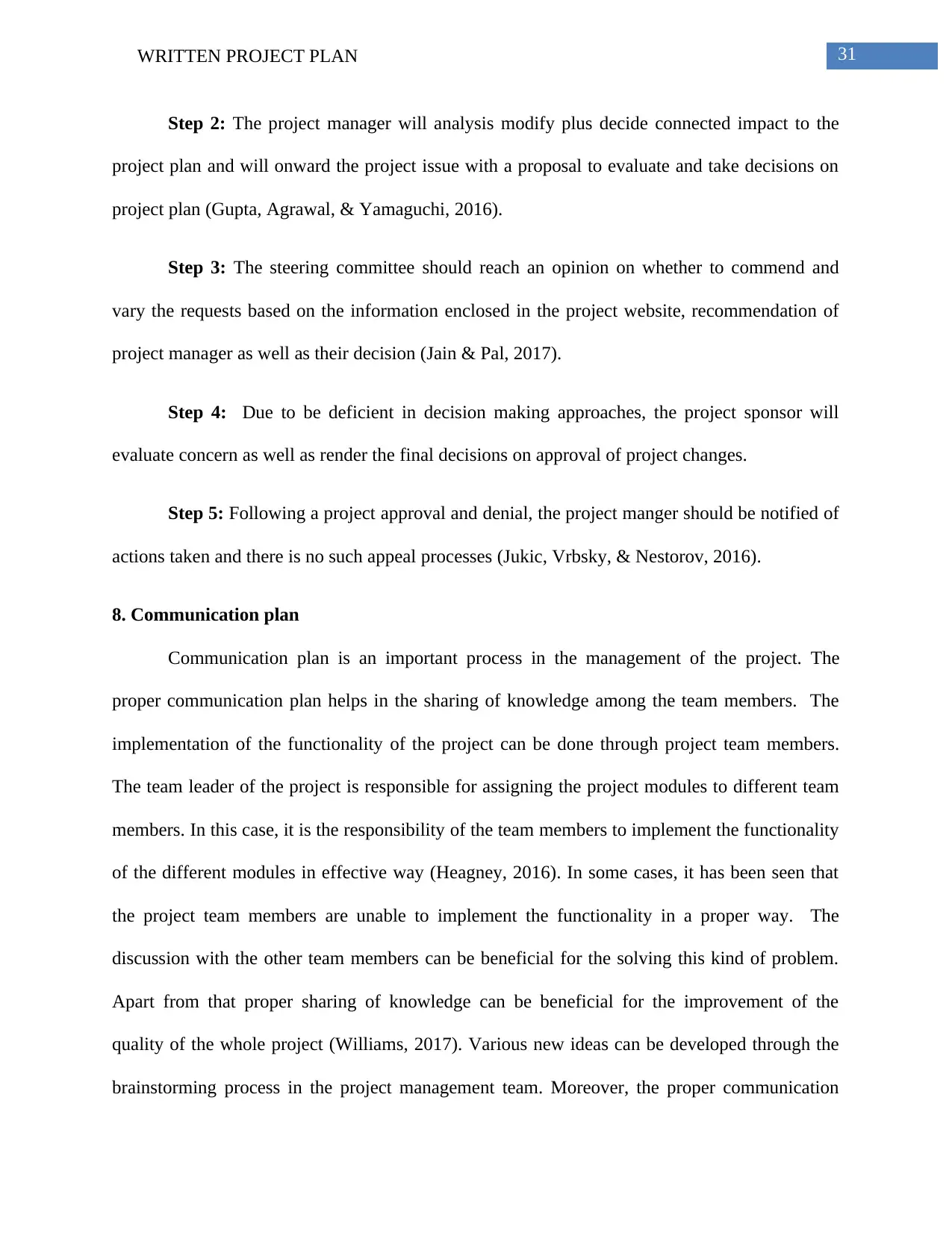
31WRITTEN PROJECT PLAN
Step 2: The project manager will analysis modify plus decide connected impact to the
project plan and will onward the project issue with a proposal to evaluate and take decisions on
project plan (Gupta, Agrawal, & Yamaguchi, 2016).
Step 3: The steering committee should reach an opinion on whether to commend and
vary the requests based on the information enclosed in the project website, recommendation of
project manager as well as their decision (Jain & Pal, 2017).
Step 4: Due to be deficient in decision making approaches, the project sponsor will
evaluate concern as well as render the final decisions on approval of project changes.
Step 5: Following a project approval and denial, the project manger should be notified of
actions taken and there is no such appeal processes (Jukic, Vrbsky, & Nestorov, 2016).
8. Communication plan
Communication plan is an important process in the management of the project. The
proper communication plan helps in the sharing of knowledge among the team members. The
implementation of the functionality of the project can be done through project team members.
The team leader of the project is responsible for assigning the project modules to different team
members. In this case, it is the responsibility of the team members to implement the functionality
of the different modules in effective way (Heagney, 2016). In some cases, it has been seen that
the project team members are unable to implement the functionality in a proper way. The
discussion with the other team members can be beneficial for the solving this kind of problem.
Apart from that proper sharing of knowledge can be beneficial for the improvement of the
quality of the whole project (Williams, 2017). Various new ideas can be developed through the
brainstorming process in the project management team. Moreover, the proper communication
Step 2: The project manager will analysis modify plus decide connected impact to the
project plan and will onward the project issue with a proposal to evaluate and take decisions on
project plan (Gupta, Agrawal, & Yamaguchi, 2016).
Step 3: The steering committee should reach an opinion on whether to commend and
vary the requests based on the information enclosed in the project website, recommendation of
project manager as well as their decision (Jain & Pal, 2017).
Step 4: Due to be deficient in decision making approaches, the project sponsor will
evaluate concern as well as render the final decisions on approval of project changes.
Step 5: Following a project approval and denial, the project manger should be notified of
actions taken and there is no such appeal processes (Jukic, Vrbsky, & Nestorov, 2016).
8. Communication plan
Communication plan is an important process in the management of the project. The
proper communication plan helps in the sharing of knowledge among the team members. The
implementation of the functionality of the project can be done through project team members.
The team leader of the project is responsible for assigning the project modules to different team
members. In this case, it is the responsibility of the team members to implement the functionality
of the different modules in effective way (Heagney, 2016). In some cases, it has been seen that
the project team members are unable to implement the functionality in a proper way. The
discussion with the other team members can be beneficial for the solving this kind of problem.
Apart from that proper sharing of knowledge can be beneficial for the improvement of the
quality of the whole project (Williams, 2017). Various new ideas can be developed through the
brainstorming process in the project management team. Moreover, the proper communication
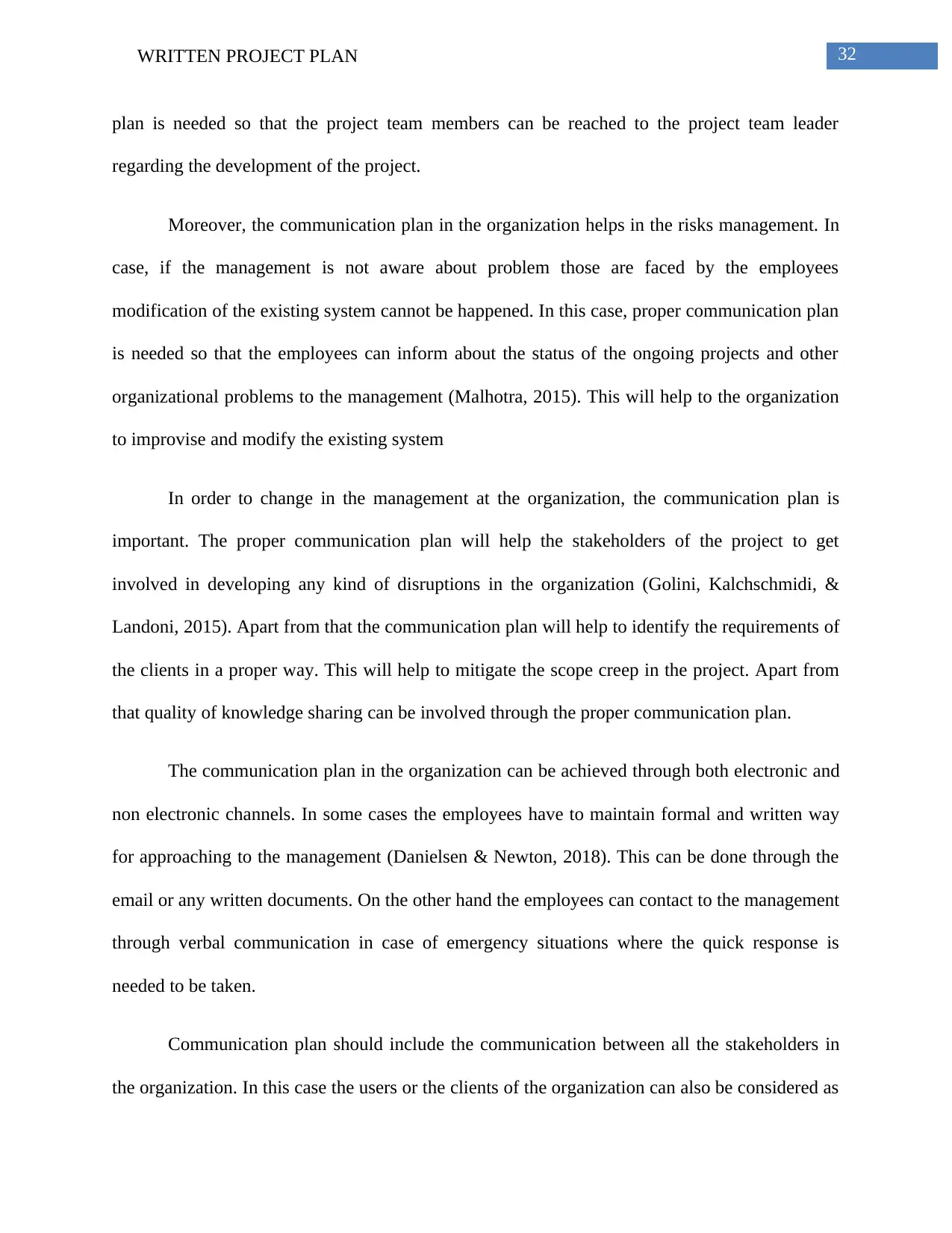
32WRITTEN PROJECT PLAN
plan is needed so that the project team members can be reached to the project team leader
regarding the development of the project.
Moreover, the communication plan in the organization helps in the risks management. In
case, if the management is not aware about problem those are faced by the employees
modification of the existing system cannot be happened. In this case, proper communication plan
is needed so that the employees can inform about the status of the ongoing projects and other
organizational problems to the management (Malhotra, 2015). This will help to the organization
to improvise and modify the existing system
In order to change in the management at the organization, the communication plan is
important. The proper communication plan will help the stakeholders of the project to get
involved in developing any kind of disruptions in the organization (Golini, Kalchschmidi, &
Landoni, 2015). Apart from that the communication plan will help to identify the requirements of
the clients in a proper way. This will help to mitigate the scope creep in the project. Apart from
that quality of knowledge sharing can be involved through the proper communication plan.
The communication plan in the organization can be achieved through both electronic and
non electronic channels. In some cases the employees have to maintain formal and written way
for approaching to the management (Danielsen & Newton, 2018). This can be done through the
email or any written documents. On the other hand the employees can contact to the management
through verbal communication in case of emergency situations where the quick response is
needed to be taken.
Communication plan should include the communication between all the stakeholders in
the organization. In this case the users or the clients of the organization can also be considered as
plan is needed so that the project team members can be reached to the project team leader
regarding the development of the project.
Moreover, the communication plan in the organization helps in the risks management. In
case, if the management is not aware about problem those are faced by the employees
modification of the existing system cannot be happened. In this case, proper communication plan
is needed so that the employees can inform about the status of the ongoing projects and other
organizational problems to the management (Malhotra, 2015). This will help to the organization
to improvise and modify the existing system
In order to change in the management at the organization, the communication plan is
important. The proper communication plan will help the stakeholders of the project to get
involved in developing any kind of disruptions in the organization (Golini, Kalchschmidi, &
Landoni, 2015). Apart from that the communication plan will help to identify the requirements of
the clients in a proper way. This will help to mitigate the scope creep in the project. Apart from
that quality of knowledge sharing can be involved through the proper communication plan.
The communication plan in the organization can be achieved through both electronic and
non electronic channels. In some cases the employees have to maintain formal and written way
for approaching to the management (Danielsen & Newton, 2018). This can be done through the
email or any written documents. On the other hand the employees can contact to the management
through verbal communication in case of emergency situations where the quick response is
needed to be taken.
Communication plan should include the communication between all the stakeholders in
the organization. In this case the users or the clients of the organization can also be considered as
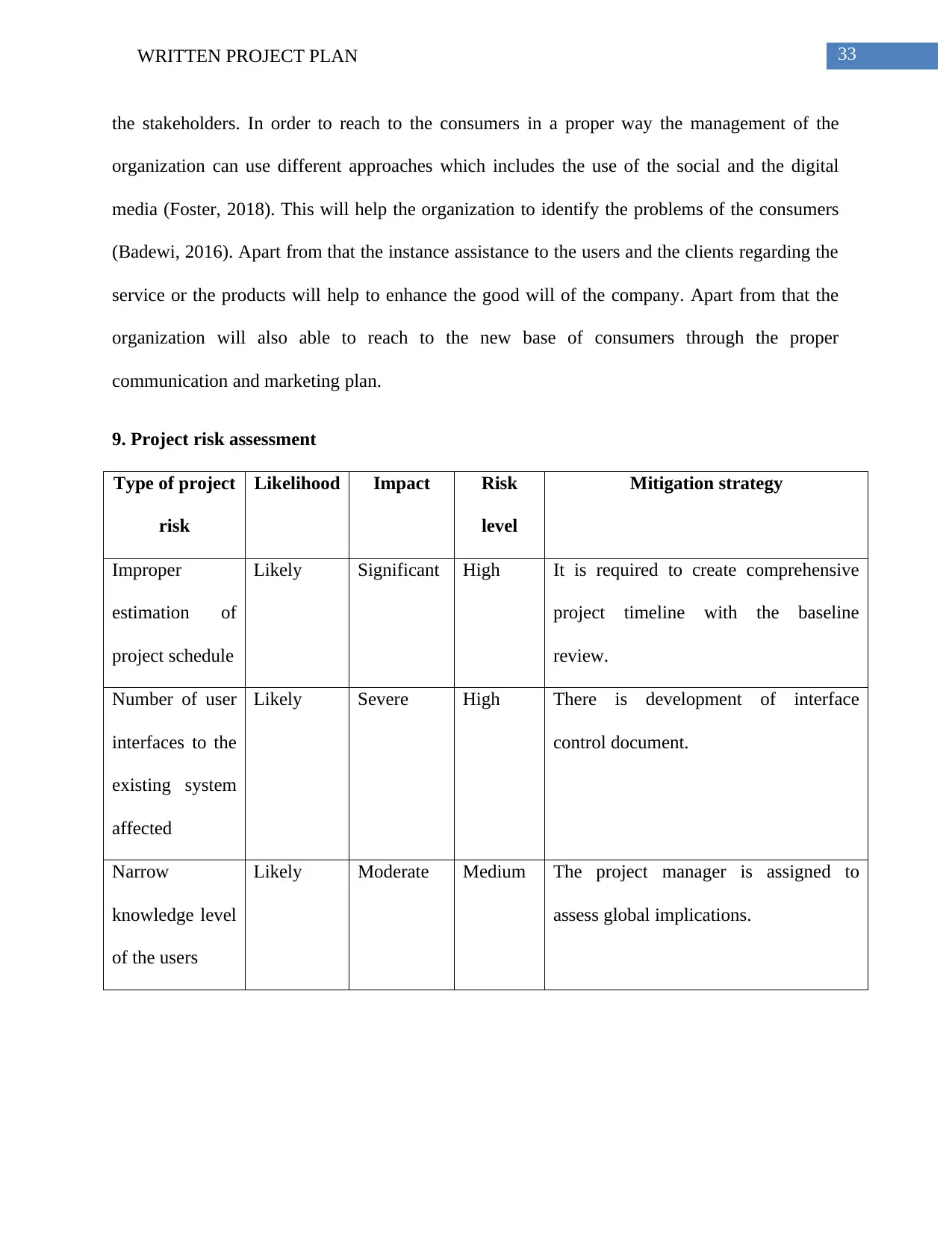
33WRITTEN PROJECT PLAN
the stakeholders. In order to reach to the consumers in a proper way the management of the
organization can use different approaches which includes the use of the social and the digital
media (Foster, 2018). This will help the organization to identify the problems of the consumers
(Badewi, 2016). Apart from that the instance assistance to the users and the clients regarding the
service or the products will help to enhance the good will of the company. Apart from that the
organization will also able to reach to the new base of consumers through the proper
communication and marketing plan.
9. Project risk assessment
Type of project
risk
Likelihood Impact Risk
level
Mitigation strategy
Improper
estimation of
project schedule
Likely Significant High It is required to create comprehensive
project timeline with the baseline
review.
Number of user
interfaces to the
existing system
affected
Likely Severe High There is development of interface
control document.
Narrow
knowledge level
of the users
Likely Moderate Medium The project manager is assigned to
assess global implications.
the stakeholders. In order to reach to the consumers in a proper way the management of the
organization can use different approaches which includes the use of the social and the digital
media (Foster, 2018). This will help the organization to identify the problems of the consumers
(Badewi, 2016). Apart from that the instance assistance to the users and the clients regarding the
service or the products will help to enhance the good will of the company. Apart from that the
organization will also able to reach to the new base of consumers through the proper
communication and marketing plan.
9. Project risk assessment
Type of project
risk
Likelihood Impact Risk
level
Mitigation strategy
Improper
estimation of
project schedule
Likely Significant High It is required to create comprehensive
project timeline with the baseline
review.
Number of user
interfaces to the
existing system
affected
Likely Severe High There is development of interface
control document.
Narrow
knowledge level
of the users
Likely Moderate Medium The project manager is assigned to
assess global implications.
Secure Best Marks with AI Grader
Need help grading? Try our AI Grader for instant feedback on your assignments.
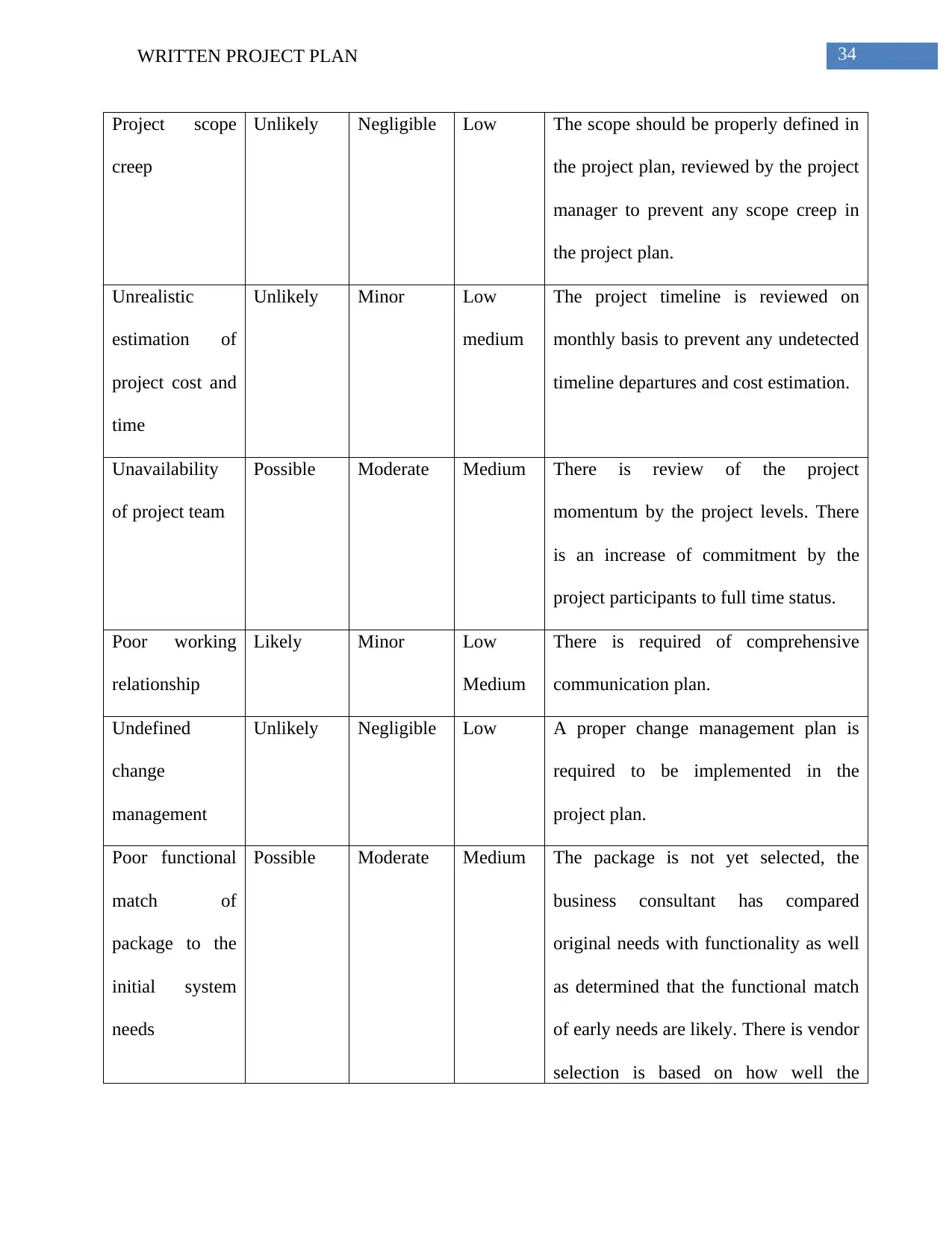
34WRITTEN PROJECT PLAN
Project scope
creep
Unlikely Negligible Low The scope should be properly defined in
the project plan, reviewed by the project
manager to prevent any scope creep in
the project plan.
Unrealistic
estimation of
project cost and
time
Unlikely Minor Low
medium
The project timeline is reviewed on
monthly basis to prevent any undetected
timeline departures and cost estimation.
Unavailability
of project team
Possible Moderate Medium There is review of the project
momentum by the project levels. There
is an increase of commitment by the
project participants to full time status.
Poor working
relationship
Likely Minor Low
Medium
There is required of comprehensive
communication plan.
Undefined
change
management
Unlikely Negligible Low A proper change management plan is
required to be implemented in the
project plan.
Poor functional
match of
package to the
initial system
needs
Possible Moderate Medium The package is not yet selected, the
business consultant has compared
original needs with functionality as well
as determined that the functional match
of early needs are likely. There is vendor
selection is based on how well the
Project scope
creep
Unlikely Negligible Low The scope should be properly defined in
the project plan, reviewed by the project
manager to prevent any scope creep in
the project plan.
Unrealistic
estimation of
project cost and
time
Unlikely Minor Low
medium
The project timeline is reviewed on
monthly basis to prevent any undetected
timeline departures and cost estimation.
Unavailability
of project team
Possible Moderate Medium There is review of the project
momentum by the project levels. There
is an increase of commitment by the
project participants to full time status.
Poor working
relationship
Likely Minor Low
Medium
There is required of comprehensive
communication plan.
Undefined
change
management
Unlikely Negligible Low A proper change management plan is
required to be implemented in the
project plan.
Poor functional
match of
package to the
initial system
needs
Possible Moderate Medium The package is not yet selected, the
business consultant has compared
original needs with functionality as well
as determined that the functional match
of early needs are likely. There is vendor
selection is based on how well the
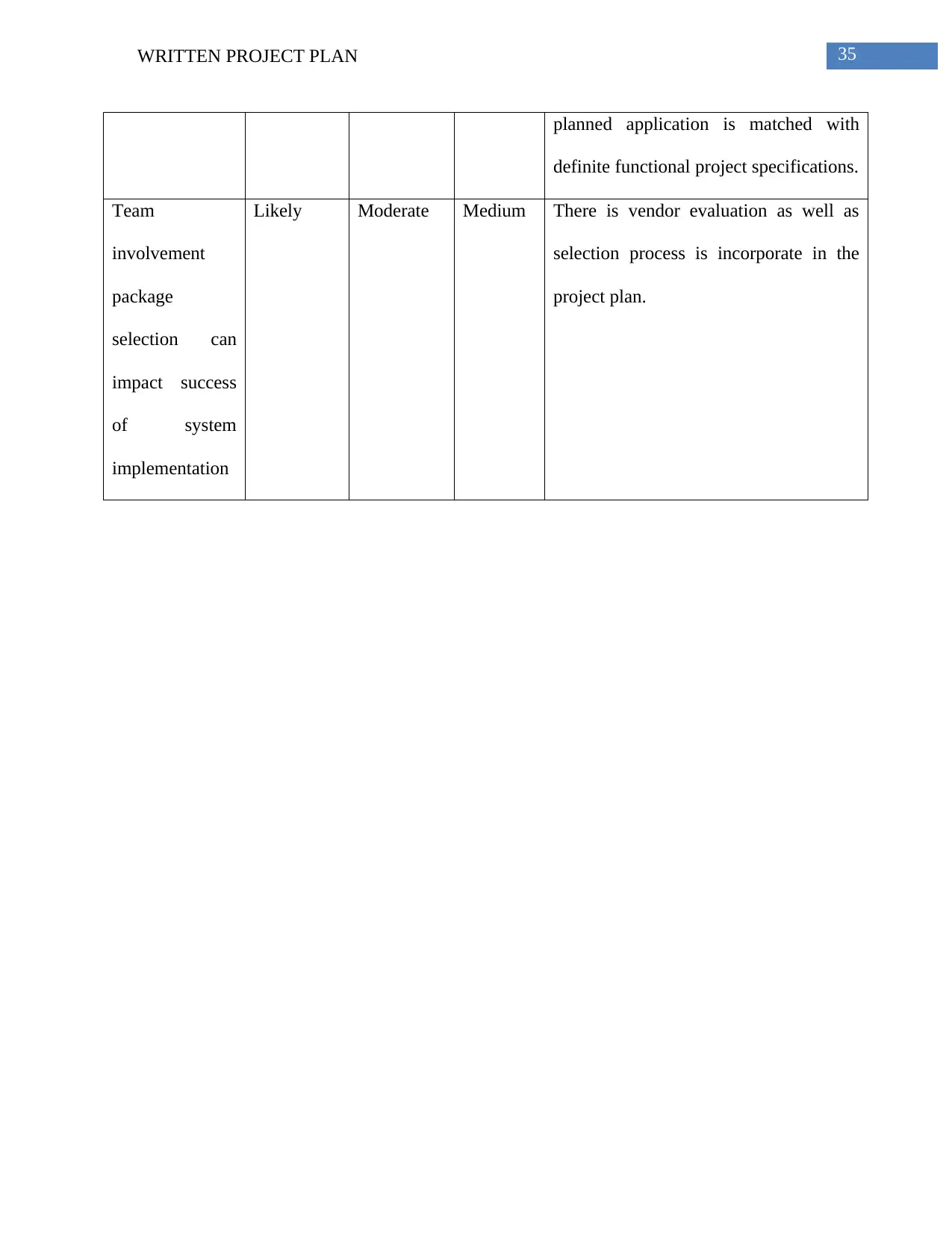
35WRITTEN PROJECT PLAN
planned application is matched with
definite functional project specifications.
Team
involvement
package
selection can
impact success
of system
implementation
Likely Moderate Medium There is vendor evaluation as well as
selection process is incorporate in the
project plan.
planned application is matched with
definite functional project specifications.
Team
involvement
package
selection can
impact success
of system
implementation
Likely Moderate Medium There is vendor evaluation as well as
selection process is incorporate in the
project plan.
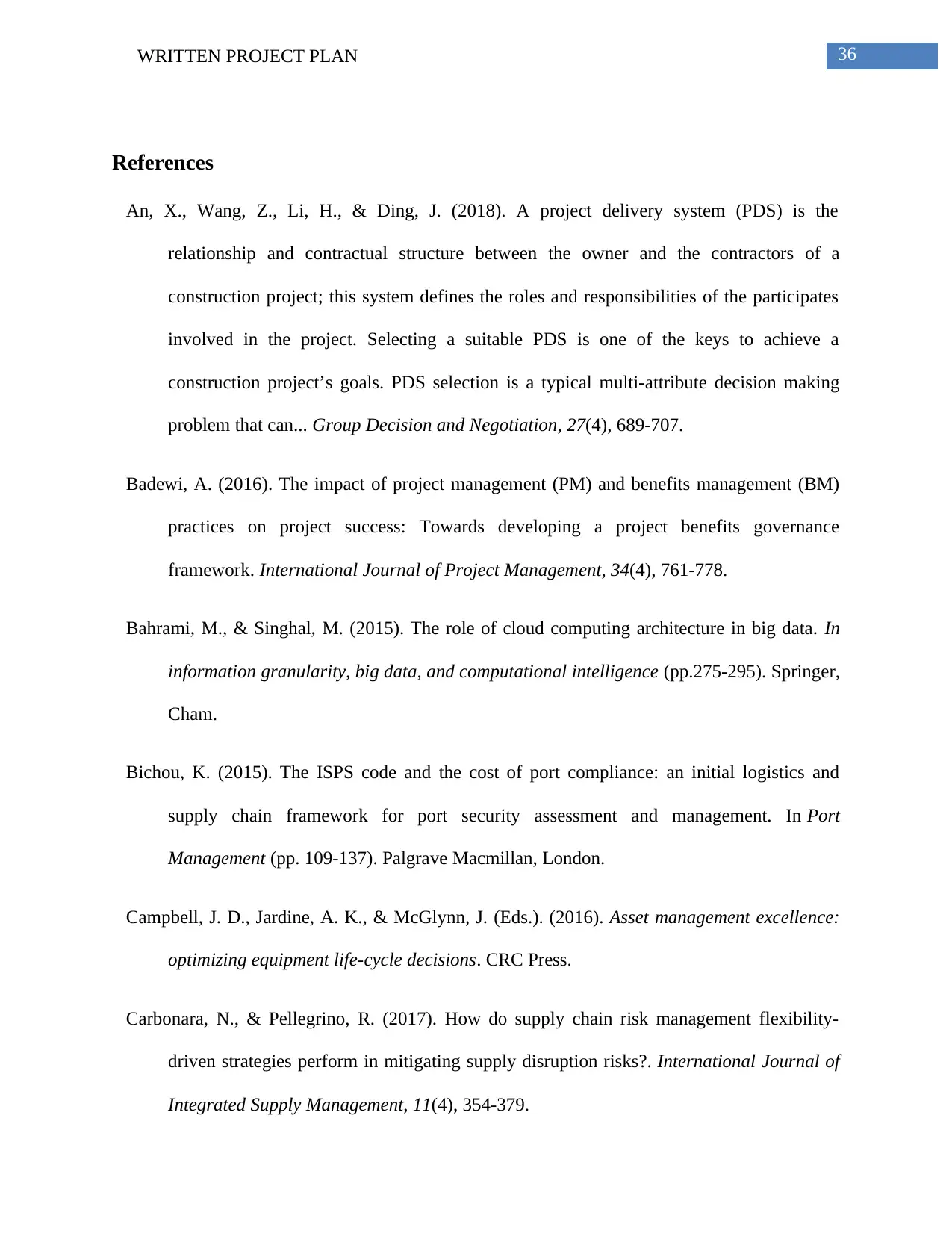
36WRITTEN PROJECT PLAN
References
An, X., Wang, Z., Li, H., & Ding, J. (2018). A project delivery system (PDS) is the
relationship and contractual structure between the owner and the contractors of a
construction project; this system defines the roles and responsibilities of the participates
involved in the project. Selecting a suitable PDS is one of the keys to achieve a
construction project’s goals. PDS selection is a typical multi-attribute decision making
problem that can... Group Decision and Negotiation, 27(4), 689-707.
Badewi, A. (2016). The impact of project management (PM) and benefits management (BM)
practices on project success: Towards developing a project benefits governance
framework. International Journal of Project Management, 34(4), 761-778.
Bahrami, M., & Singhal, M. (2015). The role of cloud computing architecture in big data. In
information granularity, big data, and computational intelligence (pp.275-295). Springer,
Cham.
Bichou, K. (2015). The ISPS code and the cost of port compliance: an initial logistics and
supply chain framework for port security assessment and management. In Port
Management (pp. 109-137). Palgrave Macmillan, London.
Campbell, J. D., Jardine, A. K., & McGlynn, J. (Eds.). (2016). Asset management excellence:
optimizing equipment life-cycle decisions. CRC Press.
Carbonara, N., & Pellegrino, R. (2017). How do supply chain risk management flexibility-
driven strategies perform in mitigating supply disruption risks?. International Journal of
Integrated Supply Management, 11(4), 354-379.
References
An, X., Wang, Z., Li, H., & Ding, J. (2018). A project delivery system (PDS) is the
relationship and contractual structure between the owner and the contractors of a
construction project; this system defines the roles and responsibilities of the participates
involved in the project. Selecting a suitable PDS is one of the keys to achieve a
construction project’s goals. PDS selection is a typical multi-attribute decision making
problem that can... Group Decision and Negotiation, 27(4), 689-707.
Badewi, A. (2016). The impact of project management (PM) and benefits management (BM)
practices on project success: Towards developing a project benefits governance
framework. International Journal of Project Management, 34(4), 761-778.
Bahrami, M., & Singhal, M. (2015). The role of cloud computing architecture in big data. In
information granularity, big data, and computational intelligence (pp.275-295). Springer,
Cham.
Bichou, K. (2015). The ISPS code and the cost of port compliance: an initial logistics and
supply chain framework for port security assessment and management. In Port
Management (pp. 109-137). Palgrave Macmillan, London.
Campbell, J. D., Jardine, A. K., & McGlynn, J. (Eds.). (2016). Asset management excellence:
optimizing equipment life-cycle decisions. CRC Press.
Carbonara, N., & Pellegrino, R. (2017). How do supply chain risk management flexibility-
driven strategies perform in mitigating supply disruption risks?. International Journal of
Integrated Supply Management, 11(4), 354-379.
Paraphrase This Document
Need a fresh take? Get an instant paraphrase of this document with our AI Paraphraser
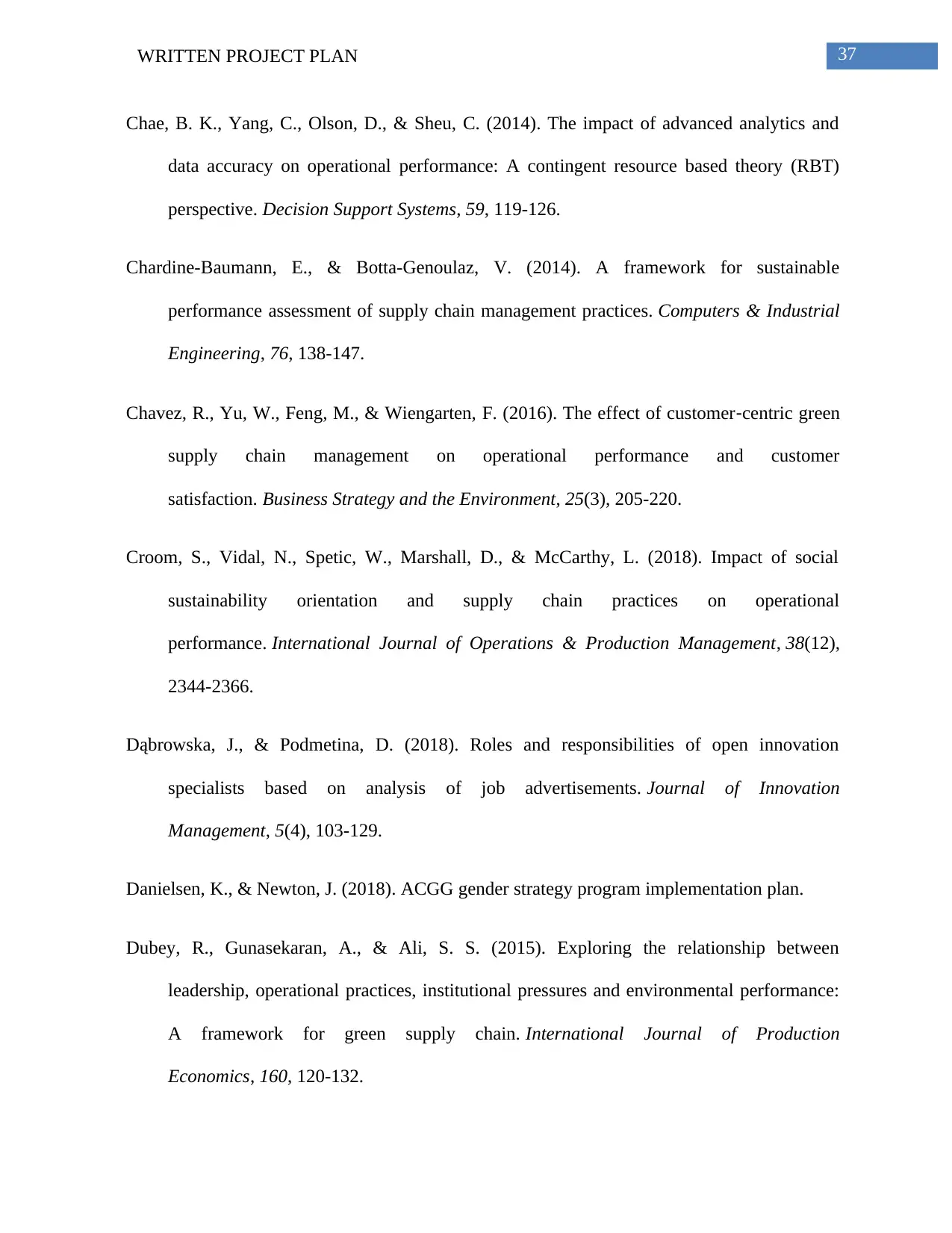
37WRITTEN PROJECT PLAN
Chae, B. K., Yang, C., Olson, D., & Sheu, C. (2014). The impact of advanced analytics and
data accuracy on operational performance: A contingent resource based theory (RBT)
perspective. Decision Support Systems, 59, 119-126.
Chardine-Baumann, E., & Botta-Genoulaz, V. (2014). A framework for sustainable
performance assessment of supply chain management practices. Computers & Industrial
Engineering, 76, 138-147.
Chavez, R., Yu, W., Feng, M., & Wiengarten, F. (2016). The effect of customer‐centric green
supply chain management on operational performance and customer
satisfaction. Business Strategy and the Environment, 25(3), 205-220.
Croom, S., Vidal, N., Spetic, W., Marshall, D., & McCarthy, L. (2018). Impact of social
sustainability orientation and supply chain practices on operational
performance. International Journal of Operations & Production Management, 38(12),
2344-2366.
Dąbrowska, J., & Podmetina, D. (2018). Roles and responsibilities of open innovation
specialists based on analysis of job advertisements. Journal of Innovation
Management, 5(4), 103-129.
Danielsen, K., & Newton, J. (2018). ACGG gender strategy program implementation plan.
Dubey, R., Gunasekaran, A., & Ali, S. S. (2015). Exploring the relationship between
leadership, operational practices, institutional pressures and environmental performance:
A framework for green supply chain. International Journal of Production
Economics, 160, 120-132.
Chae, B. K., Yang, C., Olson, D., & Sheu, C. (2014). The impact of advanced analytics and
data accuracy on operational performance: A contingent resource based theory (RBT)
perspective. Decision Support Systems, 59, 119-126.
Chardine-Baumann, E., & Botta-Genoulaz, V. (2014). A framework for sustainable
performance assessment of supply chain management practices. Computers & Industrial
Engineering, 76, 138-147.
Chavez, R., Yu, W., Feng, M., & Wiengarten, F. (2016). The effect of customer‐centric green
supply chain management on operational performance and customer
satisfaction. Business Strategy and the Environment, 25(3), 205-220.
Croom, S., Vidal, N., Spetic, W., Marshall, D., & McCarthy, L. (2018). Impact of social
sustainability orientation and supply chain practices on operational
performance. International Journal of Operations & Production Management, 38(12),
2344-2366.
Dąbrowska, J., & Podmetina, D. (2018). Roles and responsibilities of open innovation
specialists based on analysis of job advertisements. Journal of Innovation
Management, 5(4), 103-129.
Danielsen, K., & Newton, J. (2018). ACGG gender strategy program implementation plan.
Dubey, R., Gunasekaran, A., & Ali, S. S. (2015). Exploring the relationship between
leadership, operational practices, institutional pressures and environmental performance:
A framework for green supply chain. International Journal of Production
Economics, 160, 120-132.
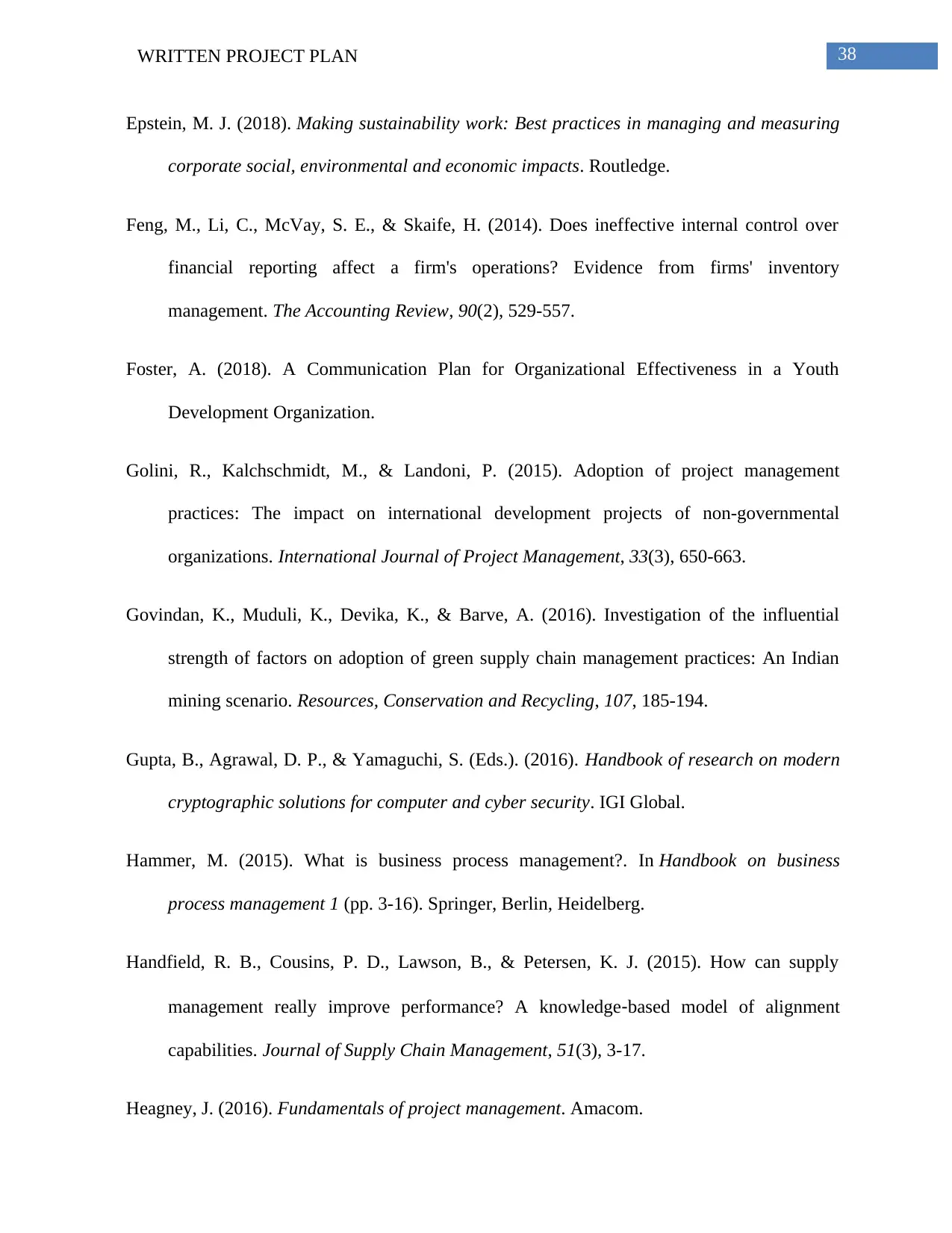
38WRITTEN PROJECT PLAN
Epstein, M. J. (2018). Making sustainability work: Best practices in managing and measuring
corporate social, environmental and economic impacts. Routledge.
Feng, M., Li, C., McVay, S. E., & Skaife, H. (2014). Does ineffective internal control over
financial reporting affect a firm's operations? Evidence from firms' inventory
management. The Accounting Review, 90(2), 529-557.
Foster, A. (2018). A Communication Plan for Organizational Effectiveness in a Youth
Development Organization.
Golini, R., Kalchschmidt, M., & Landoni, P. (2015). Adoption of project management
practices: The impact on international development projects of non-governmental
organizations. International Journal of Project Management, 33(3), 650-663.
Govindan, K., Muduli, K., Devika, K., & Barve, A. (2016). Investigation of the influential
strength of factors on adoption of green supply chain management practices: An Indian
mining scenario. Resources, Conservation and Recycling, 107, 185-194.
Gupta, B., Agrawal, D. P., & Yamaguchi, S. (Eds.). (2016). Handbook of research on modern
cryptographic solutions for computer and cyber security. IGI Global.
Hammer, M. (2015). What is business process management?. In Handbook on business
process management 1 (pp. 3-16). Springer, Berlin, Heidelberg.
Handfield, R. B., Cousins, P. D., Lawson, B., & Petersen, K. J. (2015). How can supply
management really improve performance? A knowledge‐based model of alignment
capabilities. Journal of Supply Chain Management, 51(3), 3-17.
Heagney, J. (2016). Fundamentals of project management. Amacom.
Epstein, M. J. (2018). Making sustainability work: Best practices in managing and measuring
corporate social, environmental and economic impacts. Routledge.
Feng, M., Li, C., McVay, S. E., & Skaife, H. (2014). Does ineffective internal control over
financial reporting affect a firm's operations? Evidence from firms' inventory
management. The Accounting Review, 90(2), 529-557.
Foster, A. (2018). A Communication Plan for Organizational Effectiveness in a Youth
Development Organization.
Golini, R., Kalchschmidt, M., & Landoni, P. (2015). Adoption of project management
practices: The impact on international development projects of non-governmental
organizations. International Journal of Project Management, 33(3), 650-663.
Govindan, K., Muduli, K., Devika, K., & Barve, A. (2016). Investigation of the influential
strength of factors on adoption of green supply chain management practices: An Indian
mining scenario. Resources, Conservation and Recycling, 107, 185-194.
Gupta, B., Agrawal, D. P., & Yamaguchi, S. (Eds.). (2016). Handbook of research on modern
cryptographic solutions for computer and cyber security. IGI Global.
Hammer, M. (2015). What is business process management?. In Handbook on business
process management 1 (pp. 3-16). Springer, Berlin, Heidelberg.
Handfield, R. B., Cousins, P. D., Lawson, B., & Petersen, K. J. (2015). How can supply
management really improve performance? A knowledge‐based model of alignment
capabilities. Journal of Supply Chain Management, 51(3), 3-17.
Heagney, J. (2016). Fundamentals of project management. Amacom.
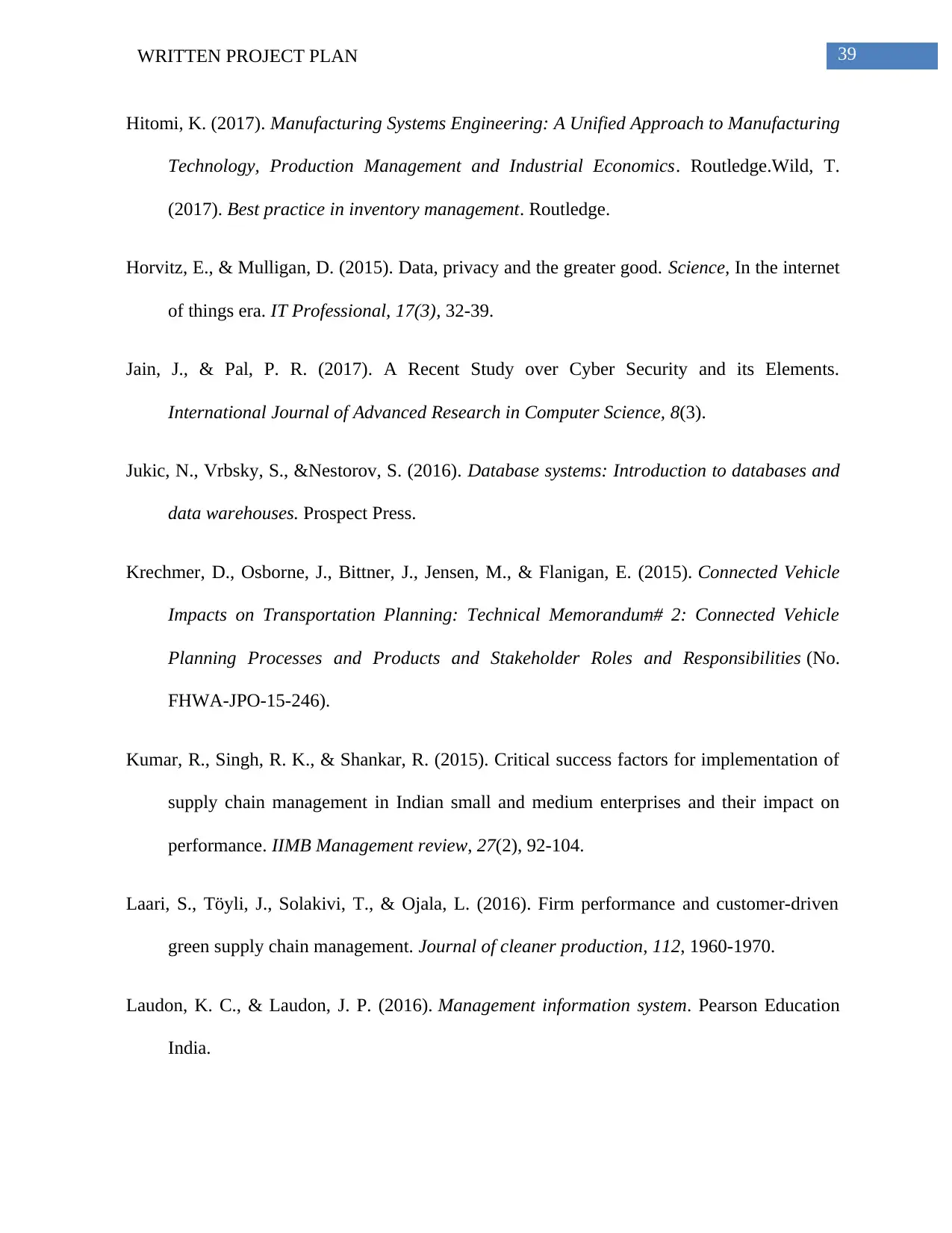
39WRITTEN PROJECT PLAN
Hitomi, K. (2017). Manufacturing Systems Engineering: A Unified Approach to Manufacturing
Technology, Production Management and Industrial Economics. Routledge.Wild, T.
(2017). Best practice in inventory management. Routledge.
Horvitz, E., & Mulligan, D. (2015). Data, privacy and the greater good. Science, In the internet
of things era. IT Professional, 17(3), 32-39.
Jain, J., & Pal, P. R. (2017). A Recent Study over Cyber Security and its Elements.
International Journal of Advanced Research in Computer Science, 8(3).
Jukic, N., Vrbsky, S., &Nestorov, S. (2016). Database systems: Introduction to databases and
data warehouses. Prospect Press.
Krechmer, D., Osborne, J., Bittner, J., Jensen, M., & Flanigan, E. (2015). Connected Vehicle
Impacts on Transportation Planning: Technical Memorandum# 2: Connected Vehicle
Planning Processes and Products and Stakeholder Roles and Responsibilities (No.
FHWA-JPO-15-246).
Kumar, R., Singh, R. K., & Shankar, R. (2015). Critical success factors for implementation of
supply chain management in Indian small and medium enterprises and their impact on
performance. IIMB Management review, 27(2), 92-104.
Laari, S., Töyli, J., Solakivi, T., & Ojala, L. (2016). Firm performance and customer-driven
green supply chain management. Journal of cleaner production, 112, 1960-1970.
Laudon, K. C., & Laudon, J. P. (2016). Management information system. Pearson Education
India.
Hitomi, K. (2017). Manufacturing Systems Engineering: A Unified Approach to Manufacturing
Technology, Production Management and Industrial Economics. Routledge.Wild, T.
(2017). Best practice in inventory management. Routledge.
Horvitz, E., & Mulligan, D. (2015). Data, privacy and the greater good. Science, In the internet
of things era. IT Professional, 17(3), 32-39.
Jain, J., & Pal, P. R. (2017). A Recent Study over Cyber Security and its Elements.
International Journal of Advanced Research in Computer Science, 8(3).
Jukic, N., Vrbsky, S., &Nestorov, S. (2016). Database systems: Introduction to databases and
data warehouses. Prospect Press.
Krechmer, D., Osborne, J., Bittner, J., Jensen, M., & Flanigan, E. (2015). Connected Vehicle
Impacts on Transportation Planning: Technical Memorandum# 2: Connected Vehicle
Planning Processes and Products and Stakeholder Roles and Responsibilities (No.
FHWA-JPO-15-246).
Kumar, R., Singh, R. K., & Shankar, R. (2015). Critical success factors for implementation of
supply chain management in Indian small and medium enterprises and their impact on
performance. IIMB Management review, 27(2), 92-104.
Laari, S., Töyli, J., Solakivi, T., & Ojala, L. (2016). Firm performance and customer-driven
green supply chain management. Journal of cleaner production, 112, 1960-1970.
Laudon, K. C., & Laudon, J. P. (2016). Management information system. Pearson Education
India.
Secure Best Marks with AI Grader
Need help grading? Try our AI Grader for instant feedback on your assignments.
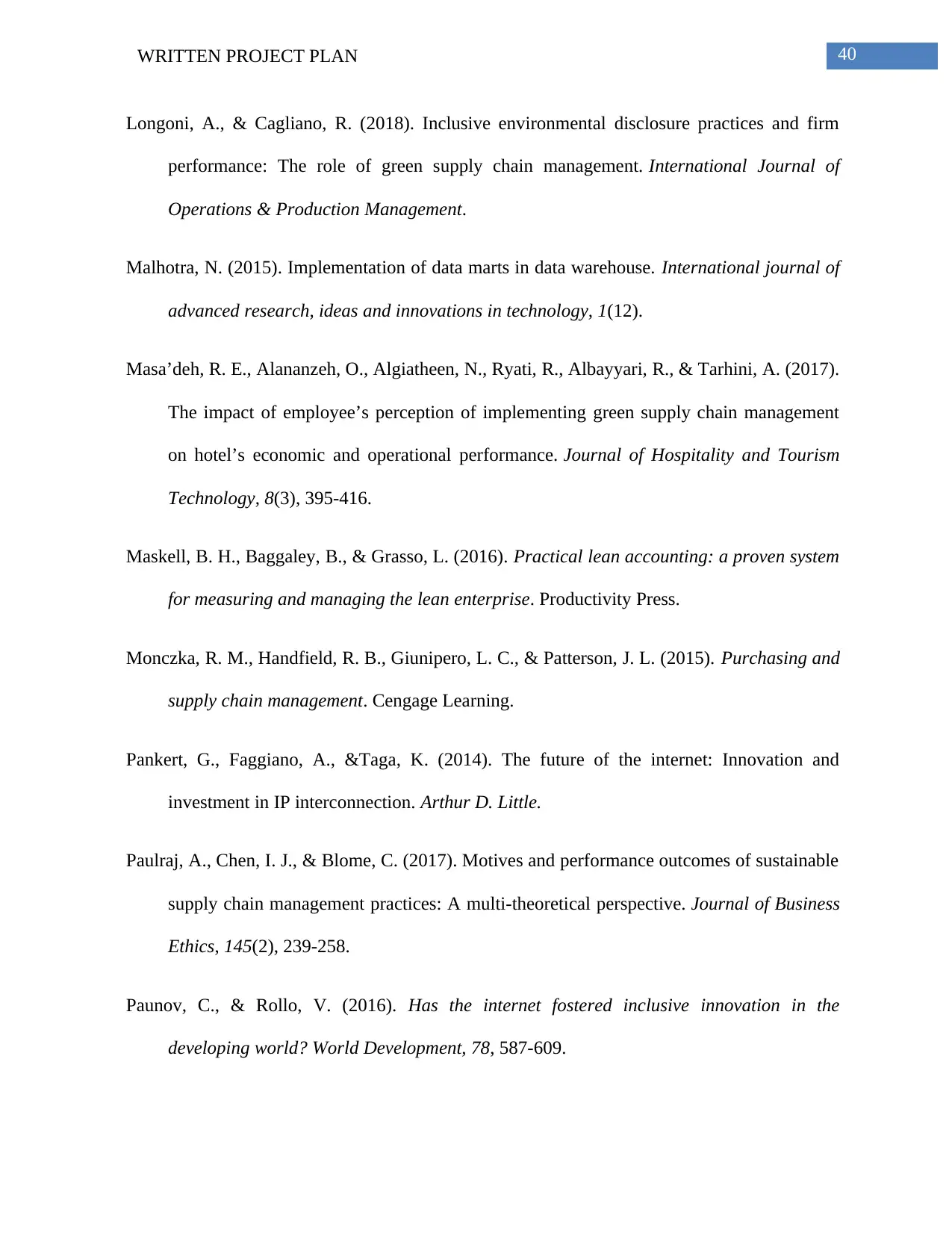
40WRITTEN PROJECT PLAN
Longoni, A., & Cagliano, R. (2018). Inclusive environmental disclosure practices and firm
performance: The role of green supply chain management. International Journal of
Operations & Production Management.
Malhotra, N. (2015). Implementation of data marts in data warehouse. International journal of
advanced research, ideas and innovations in technology, 1(12).
Masa’deh, R. E., Alananzeh, O., Algiatheen, N., Ryati, R., Albayyari, R., & Tarhini, A. (2017).
The impact of employee’s perception of implementing green supply chain management
on hotel’s economic and operational performance. Journal of Hospitality and Tourism
Technology, 8(3), 395-416.
Maskell, B. H., Baggaley, B., & Grasso, L. (2016). Practical lean accounting: a proven system
for measuring and managing the lean enterprise. Productivity Press.
Monczka, R. M., Handfield, R. B., Giunipero, L. C., & Patterson, J. L. (2015). Purchasing and
supply chain management. Cengage Learning.
Pankert, G., Faggiano, A., &Taga, K. (2014). The future of the internet: Innovation and
investment in IP interconnection. Arthur D. Little.
Paulraj, A., Chen, I. J., & Blome, C. (2017). Motives and performance outcomes of sustainable
supply chain management practices: A multi-theoretical perspective. Journal of Business
Ethics, 145(2), 239-258.
Paunov, C., & Rollo, V. (2016). Has the internet fostered inclusive innovation in the
developing world? World Development, 78, 587-609.
Longoni, A., & Cagliano, R. (2018). Inclusive environmental disclosure practices and firm
performance: The role of green supply chain management. International Journal of
Operations & Production Management.
Malhotra, N. (2015). Implementation of data marts in data warehouse. International journal of
advanced research, ideas and innovations in technology, 1(12).
Masa’deh, R. E., Alananzeh, O., Algiatheen, N., Ryati, R., Albayyari, R., & Tarhini, A. (2017).
The impact of employee’s perception of implementing green supply chain management
on hotel’s economic and operational performance. Journal of Hospitality and Tourism
Technology, 8(3), 395-416.
Maskell, B. H., Baggaley, B., & Grasso, L. (2016). Practical lean accounting: a proven system
for measuring and managing the lean enterprise. Productivity Press.
Monczka, R. M., Handfield, R. B., Giunipero, L. C., & Patterson, J. L. (2015). Purchasing and
supply chain management. Cengage Learning.
Pankert, G., Faggiano, A., &Taga, K. (2014). The future of the internet: Innovation and
investment in IP interconnection. Arthur D. Little.
Paulraj, A., Chen, I. J., & Blome, C. (2017). Motives and performance outcomes of sustainable
supply chain management practices: A multi-theoretical perspective. Journal of Business
Ethics, 145(2), 239-258.
Paunov, C., & Rollo, V. (2016). Has the internet fostered inclusive innovation in the
developing world? World Development, 78, 587-609.
1 out of 41
Related Documents
Your All-in-One AI-Powered Toolkit for Academic Success.
+13062052269
info@desklib.com
Available 24*7 on WhatsApp / Email
![[object Object]](/_next/static/media/star-bottom.7253800d.svg)
Unlock your academic potential
© 2024 | Zucol Services PVT LTD | All rights reserved.





